[LOGO]
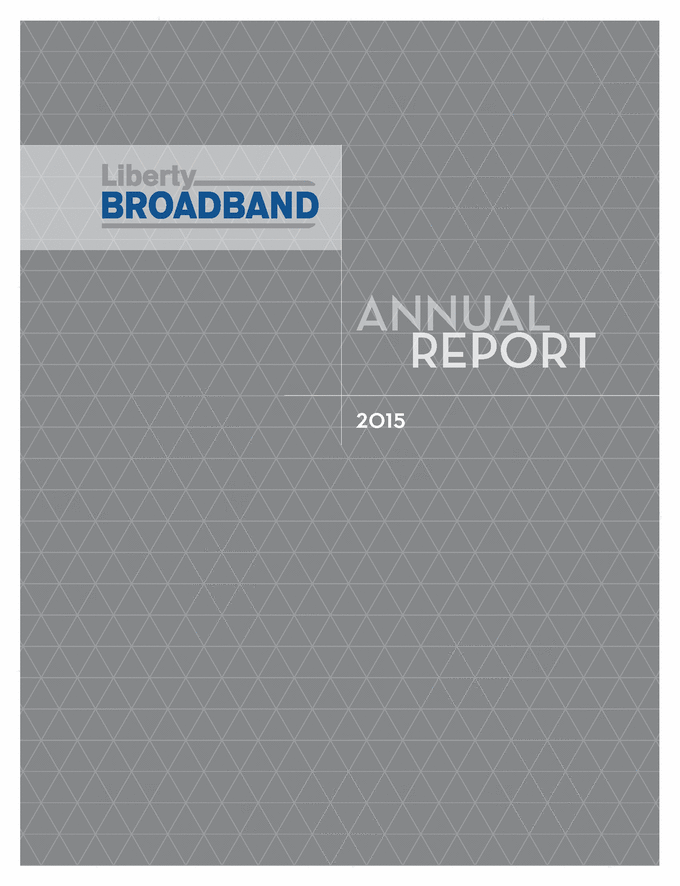
[LOGO]

[LOGO]

TABLE OF LETTER TO SHAREHOLDERS.1 STOCK PERFORMANCE 2 FINANCIAL INFORMATION F1 CORPORATE DATA Inside Back Cover CONTENTS
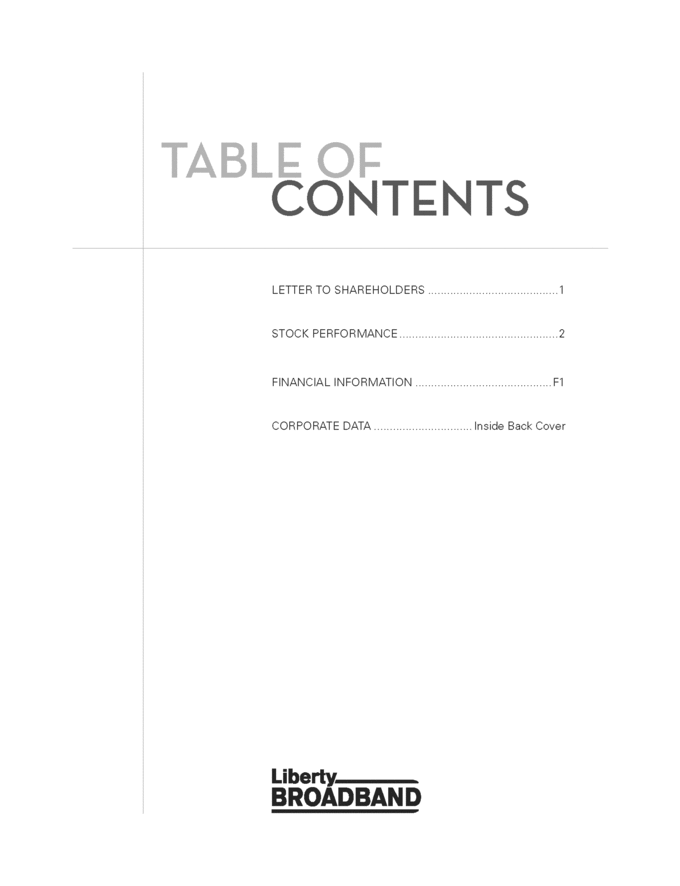
Certain statements in this Annual Report constitute forward-looking statements within the meaning of the Private Securities Litigation Reform Act of 1995, including statements regarding our business, product and marketing strategies; new service offerings; the return on our investment in, and performance of, Charter Communications, Inc. (”Charter”); future acquisition and investment activities; the recoverability of our goodwill and other long-lived assets; our projected sources and uses of cash; and the anticipated impact of certain contingent liabilities related to legal and tax proceedings and other matters arising in the ordinary course of business. In particular, statements in our “Letter to Shareholders” and under “Management’s Discussion and Analysis of Financial Condition and Results of Operations” and “Quantitative and Qualitative Disclosures About Market Risk” contain forward-looking statements. Where, in any forward-looking statement, we express an expectation or belief as to future results or events, such expectation or belief is expressed in good faith and believed to have a reasonable basis, but there can be no assurance that the expectation or belief will result or be achieved or accomplished. The following include some but not all of the factors that could cause actual results or events to differ materially from those anticipated: Charter’s ability to sustain and grow revenue and cash flow from operations by offering video, Internet, voice, advertising and other services to residential and commercial customers, to adequately meet the customer experience demands in its markets and to maintain and grow its customer base, particularly in the face of increasingly aggressive competition, the need for innovation and the related capital expenditures; • the impact of competition from other market participants, including but not limited to incumbent telephone companies, direct broadcast satellite operators, wireless broadband and telephone providers, digital subscriber line (“DSL”) providers, video provided over the Internet and providers of advertising over the Internet; general business conditions, economic uncertainty or downturn, high unemployment levels and the level of activity in the housing sector; • Charter’s ability to obtain programming at reasonable prices or to raise prices to offset, in whole or in part, the effects of higher programming costs (including retransmission consents); • the development and deployment of new products and technologies, including cloud-based user interface, Spectrum Guide downloadable security for set top boxes; • failure to protect the security of personal information about the customers of our operating subsidiary and equity affiliate, subjecting us to costly government enforcement actions or private litigation and reputational damage; • changes in, or failure or inability to comply with, government regulations, including, without limitation, regulations of the Federal Communications Commission, and adverse outcomes from regulatory proceedings; • the effects of governmental regulation on our business or potential business combination transactions; • any events that disrupt Charter’s networks, information systems or properties and impair its operating activities and negatively impact its reputation; • the ability of suppliers and vendors to deliver products, equipment, software and services; • the outcome of any pending or threatened litigation; • availability of qualified personnel; • changes in the nature of key strategic relationships with partners, vendors and joint venturers; • the availability and access, in general, of funds to meet debt obligations prior to or when they become due and to fund operations and necessary capital expenditures, either through (i) cash on hand, (ii) free cash flow, or (iii) access to the capital or credit markets; the ability of Charter and our company to comply with all covenants in our respective debt instruments, any violation of which, if not cured in a timely manner, could trigger a default of other obligations under cross-default provisions; • our ability to successfully monetize certain of our assets; and • our ability to successfully deploy the use of proceeds from the rights offering, including the availability of investment opportunities (to the extent such funds are not deployed to acquire shares of New Charter stock. RISKS RELATED TO THE TIME WARNER CABLE TRANSACTION AND THE BRIGHT HOUSE TRANSACTION • the ability of Charter to complete the Time Warner Cable Transaction and Bright House Transaction together with the Time Warner Cable Transaction, the “Transactions”) and our ability to complete the acquisition of New Charter stock in connection therewith; • New Charter’s ability to achieve the synergies and value creation contemplated by the Transactions; • New Charter’s ability to promptly, efficiently and effectively integrate acquired operations into its own operations; • managing a significantly larger company than before the completion of the Transactions; • diversion of management time on issues related to the Transactions; • changes in Charter’s, Time Warner Cable’s or Bright House’s businesses, future cash requirements, capital requirements, results of operations, revenues, financial condition and/or cash flows; • disruption in the existing business relationships of Charter, Time Warner Cable and Bright House as a result of the Transactions; • the increase in indebtedness as a result of the Transactions, which will increase interest expense and may decrease Charter’s operating flexibility; • changes in transaction costs, the amount of fees paid to financial advisors, potential termination fees and the potential payments to Time Warner Cable’s and Bright House’s executive officers in connection with the Transactions; • operating costs and business disruption that may be greater than expected; and • the ability to retain and hire key personnel and maintain relationships with providers or other business partners pending completion of the Transactions. The terms “New Charter,” “Time Warner Cable Transaction” and “Bright House Transaction” are defined in our Annual Report on Form 10-K for the year ended December 31, 2015 on file with the SEC. These forward-looking statements and such risks, uncertainties and other factors speak only as of the date of this Annual Report, and we expressly disclaim any obligation or undertaking to disseminate any updates or revisions to any forward-looking statement contained herein, to reflect any change in our expectations with regard thereto, or any other change in events, conditions or circumstances on which any such statement is based. When considering such forward-looking statements, you should keep in mind any risk factors identified and other cautionary statements contained in this Annual Report. Such risk factors and statements describe circumstances which could cause actual results to differ materially from those contained in any forward-looking statement. This Annual Report includes information concerning public companies in which we have non-controlling interests that file reports and other information with the SEC in accordance with the Securities Exchange Act of 1934, as amended. Information contained in this Annual Report concerning those companies has been derived from the reports and other information filed by them with the SEC. If you would like further information about these companies, the reports and other information they file with the SEC can be accessed on the Internet website maintained by the SEC at www.sec.gov. Those reports and other information are not incorporated by reference in this Annual Report.
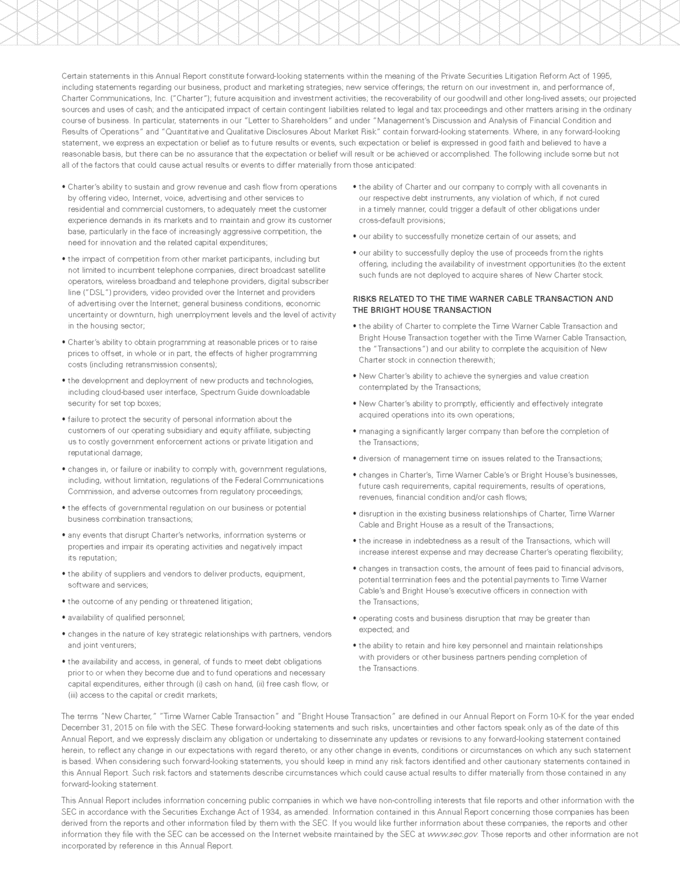
LETTER TO SHAREHOLDERS Events of the past year speak to the dynamism inherent in the cable industry. The transactions described in our 2015 letter were completely restructured, much to the benefit of Liberty Broadband as well as Liberty Interactive Corporation, which will soon be one of our newest investors. That said, for all the changes to who is buying whom, in what structure and at what price, the general trend towards industry consolidation continues. And how could it not? The economics of consolidation are compelling for acquirer and acquiree alike. As we’ve advocated for in the past, the scale these transactions create is integral to developing and deploying new generations of digital technology, to the ultimate benefit of consumers. This is an area where the US simply cannot afford to fall behind. Whether you believe it is keeping America great or making it great again, massive investment by leading cable companies will be a pivotal factor in our country’s digital future. For this and many other reasons, we at Liberty Broadband remain extremely excited about our investment in Charter Communications. Before we dive into the pending deals, let us briefly touch on fundamentals. In many ways, 2015 was a statement year for the cable industry and notably for Charter. We saw Charter add video subscribers, thereby defying prevailing industry logic that pay TV is a proverbial melting ice cube. We were proud of Charter for closing out 2015 as the first full year in over a decade in which video customers grew. Continued investment in the quality of the video offering is proving successful, and bundling this product alongside industry-leading broadband speeds offers consumers a highly compelling proposition. WHAT HAPPENED TO THE CHARTER— COMCAST DEALS? About a month after we published our 2014 letter, Comcast chose to walk away from its proposed acquisition of Time Warner Cable (“TWC”). Charter (with the support of Liberty Broadband’s strategic investment and board participation) was able to quickly negotiate a transaction through which it would buy the entirety of TWC. Combined with the pending acquisition of Bright House Networks, these transactions totaled $89 billion in incremental enterprise value at the time of announcement. During the negotiations with TWC, a new player emerged in the US cable space, Altice. We know Altice’s leadership team well and have great respect for Patrick and Dexter as both deal makers and operators, and will be observant of their planned acquisition of Cablevision. The US cable industry should benefit from their emergence as an additional scale player. TERMS OF THE NEW TWC & BRIGHT HOUSE DEALS While the details are too voluminous to fully capture here, the salient highlights include: • TWC shareholders receiving $195.71 (value as of announcement date) per share in a mix of cash and stock ($100-115 per share in cash); Bright House’s private owners to receive $10.4 billion in a mix of cash, and common and preferred equity (value as of announcement date); • Charter will have a reasonable pro forma leverage profile of 4.5x or lower and should delever rapidly through growth; • Liberty Broadband will invest $5 billion in newly issued Charter equity (up to $4.4 billion of which will be funded by newly issued Liberty Broadband Series C shares to Liberty Interactive via its Ventures Group and a small group of third party investors); • Liberty Broadband will own approximately 19% of Charter upon closing and will receive a voting proxy from Advance/ Newhouse (current parent of Bright House) to increase our vote to 25.01%; and • Liberty Broadband will maintain strong governance rights and appoint 3 of 13 directors post-close DEAL RATIONALE Liberty Broadband’s commitment to invest an incremental $5 billion in connection with the TWC and Bright House transactions speaks to our confidence in the future of Charter and cable. Rarely is one presented with such an opportunity: deploy large sums of capital, in one’s industry of expertise, with a highly efficient capital structure, the advantage of meaningful governance rights and a management team considered best-in-class. Tom Rutledge, Charter’s highly talented CEO, has been able to create value in the existing footprint through a clean strategy of investing in great products, providing fair and straight-forward consumer pricing and supporting it with superior customer service. We are extremely confident that this strategy will scale well to the much larger pro forma footprint of Charter, TWC and Bright House. Operating synergies, scale efficiencies in innovation, attractive financial leverage and accelerated use of our net operating losses further enhance the return profile. We jumped on the opportunity to invest in this transaction as a follow up to our initial investment in Charter in May 2013. LOOKING AHEAD For the time being, all eyes remain on the regulatory approval process. We continue to believe that a second quarter close is the most likely timeline. Charter’s reputation of proconsumer behavior and the benefits awaiting TWC’s millions of subscribers should tip the scales in our favor, but for now we wait… We look forward to seeing many of you at this year’s annual investor meeting, which will take place on November 10th at the Times Center at 242 West 41st Street in New York City. We appreciate your ongoing support. Very truly yours, Gregory B. Maffei President & Chief Executive Officer John C. Malone Chairman of the Board
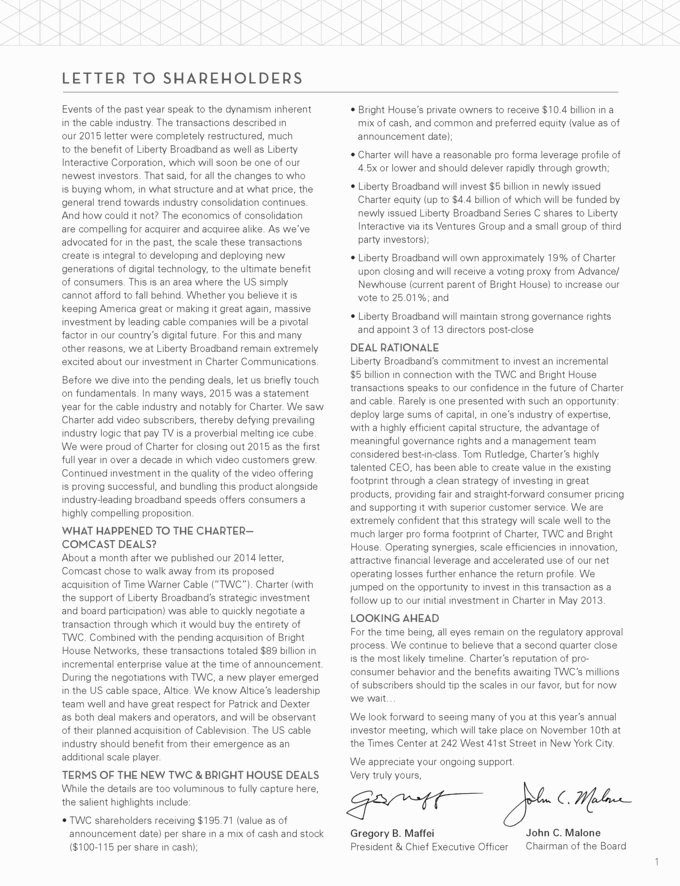
The following graph compares the percentage change in the cumulative total shareholder return on an investment in Liberty Broadband Series A and Series C common stock from November 5, 2014 (the day Liberty Broadband began trading “regular-way” following its spin-off from Liberty Media Corporation) through December 31, 2015, in comparison to the S&P 500 Index and S&P Media Index. Liberty Broadband performance includes the impact of the rights offering completed in January 2015. 11/5/2014 12/31/2014 12/31/2015 Liberty Broadband Series A $100.00 $102.03 $105.89 Liberty Broadband Series C $100.00 $101.48 $106.28 S&P 500 Index $100.00 $101.75 $101.01 S&P Media Index $100.00 $105.26 $99.23
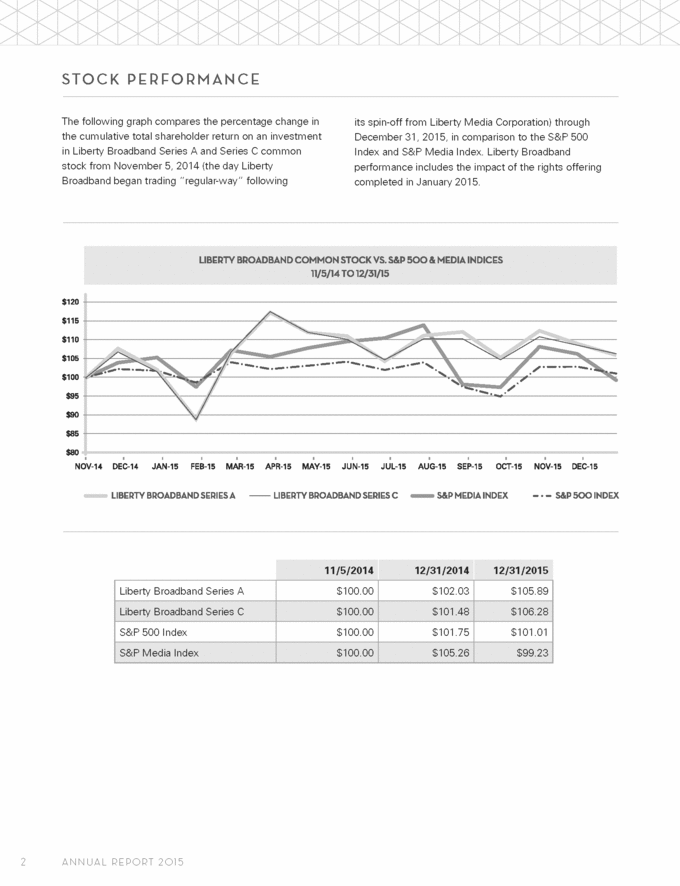
Market for Registrant's Common Equity and Related Stockholder Matters of Equity Securities. Market Information Each series of our common stock has been outstanding since November 2014. Our Series A and Series C common stock trade on the Nasdaq Global Select Market under the symbols “LBRDA” and “LBRDK,” respectively. Our Series B common stock is eligible for quotation on the OTC Markets under the symbol LBRDB, but it is not actively traded. The following table sets forth the quarterly range of high and low sales prices of shares of each series of our common stock for the years ended December 31, 2015 and 2014 for the periods they were outstanding. With respect to our Series B common stock, this information represents inter-dealer prices without dealer mark-ups, mark-downs or commissions, and may not be indicative of the value of the common stock or the existence of an active market. Liberty Broadband Corporation Series A Series B Series C (LBRDA) (LBRDB) (LBRDK) High Low High Low High Low 2014 Fourth quarter (after November 4, 2014) $ 55.35 44.63 50.00 48.00 54.74 42.12 2015 First quarter $ 58.13 44.08 60.01 43.09 58.07 44.06 Second quarter $ 56.60 49.80 60.01 51.67 56.80 49.99 Third quarter $ 57.28 49.50 56.30 50.23 56.03 48.28 Fourth quarter $ 56.10 48.80 55.07 51.53 59.70 48.99 Holders As of January 31, 2016, there were 949, 70 and 1,207 holders of our Series A, Series B and Series C common stock, respectively. The foregoing numbers of record holders do not include the number of stockholders whose shares are held nominally by banks, brokerage houses or other institutions, but include each such institution as one shareholder. Dividends We have not paid any cash dividends on our common stock, and we have no present intention of so doing. Payment of cash dividends, if any, in the future will be determined by our board of directors in light of our earnings, financial condition and other relevant considerations. Securities Authorized for Issuance Under Equity Compensation Plans Information required by this item is incorporated by reference to our definitive proxy statement for our 2016 Annual Meeting of stockholders. Purchases of Equity Securities by the Issuer There were no repurchases of Series A, B or C Liberty Broadband common stock during the period. During the three months ended December 31, 2015, 1,254 shares of Series A Liberty Broadband common stock and 2,256 shares of Series C Liberty Broadband common stock were surrendered by certain of our officers and employees to pay withholding taxes and other deductions in connection with the vesting of their restricted stock.
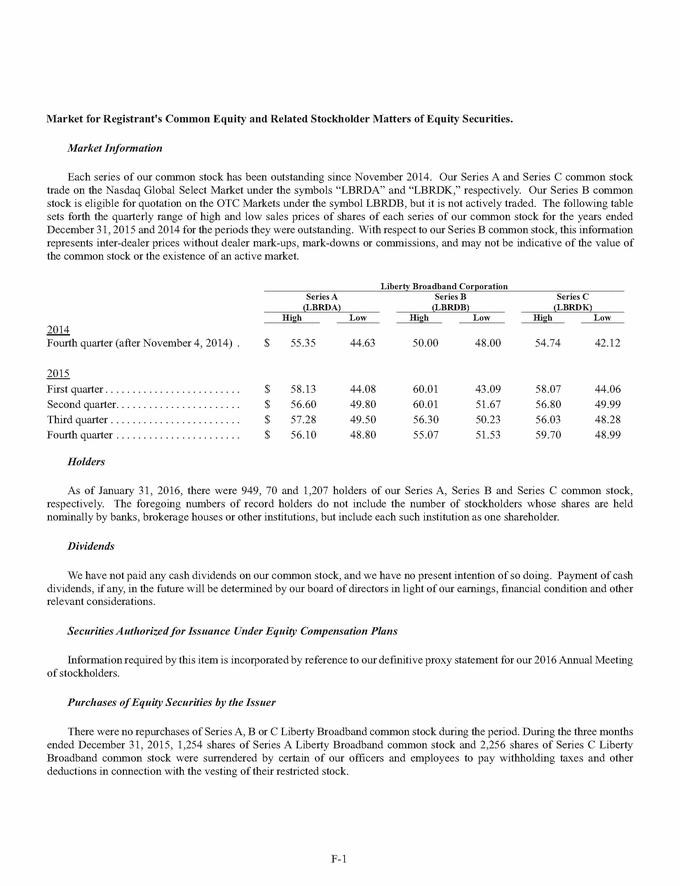
Selected Financial Data. The following tables present selected historical information relating to our financial condition and results of operations for the past five years. The following data should be read in conjunction with our consolidated financial statements. December 31, 2015 2014 2013 2012 2011 (3) Summary Balance Sheet Data: amounts in thousands Cash and cash equivalents $ 655,079 44,809 9,251 10,031 30,890 Investments in available for sale securities $ 439,560 360,762 326,700 232,648 151,581 Investment in affiliates, accounted for using the equity method (2) $ 2,372,699 2,498,804 2,402,024 — — Intangible assets not subject to amortization (1) $ 6,497 27,166 20,669 20,669 20,669 Intangible assets subject to amortization, net (1) $ 11,887 12,915 429 1,562 3,645 Net deferred income tax assets $ 55,368 30,822 — — — Total assets $ 3,565,741 3,003,471 2,891,781 306,786 247,084 Long-term debt $ 399,703 371,539 — — — Net deferred income tax liabilities $ — — 6,740 34,166 13,722 Total equity (deficit) $ 3,148,219 2,494,769 2,779,194 196,459 161,128 Years Ended December 31, 2015 2014 2013 2012 2011 (3) Summary Statement of Operations Data: amounts in thousands, except per share amounts Revenue $ 91,182 69,045 77,363 83,098 1,136,934 Operating income (loss) $ 58,955 (42,974) (88) 7,879 640,359 Share of earnings (losses) of affiliate (2) $ (120,962) (127,573) (76,090) — — Realized and unrealized gains (losses) on financial instruments $ 2,619 51,189 97,860 57,582 (4,150) Gain (loss) on dilution of investment in affiliate $ (7,198) (87,158) (92,933) — — Net earnings (loss) attributable to Liberty Broadband shareholders $ (50,187) (134,605) (41,728) 44,196 607,374 Basic earnings (loss) per common share (4) $ (0.49) (1.52) (0.47) 0.50 6.88 Diluted earnings (loss) per common share (4) $ (0.49) (1.52) (0.47) 0.50 6.88 (1) As discussed in note 2 to the accompanying consolidated financial statements, TruePosition acquired 100% of the outstanding common shares of Skyhook, a Delaware corporation, on February 14, 2014 for approximately $57.5 million in cash. (2) As discussed in note 6 to the accompanying consolidated financial statements, in May 2013, Liberty acquired approximately 26.9 million shares of common stock and approximately 1.1 million warrants in Charter for approximately $2.6 billion, which represented an approximate 27% beneficial ownership in Charter at the time of purchase. (3) In 2011 TruePosition recognized $1,014 million of previously deferred revenue and $405 million of deferred costs associated with two separate contracts. (4) We issued 85,761,332 common shares, which is the aggregate number of shares of Series A, Series B and Series C common stock outstanding upon the completion of the Broadband Spin-Off on November 4, 2014. Additionally, Liberty Broadband distributed subscription rights, which were priced at a discount to the market value, to all holders of Liberty Broadband common stock as of the rights record date. Because of the discount, the rights offering is considered a stock dividend which requires retroactive treatment for prior periods for the weighted average shares outstanding based on a factor determined by the fair value per share immediately prior to the rights exercise and the theoretical fair value after
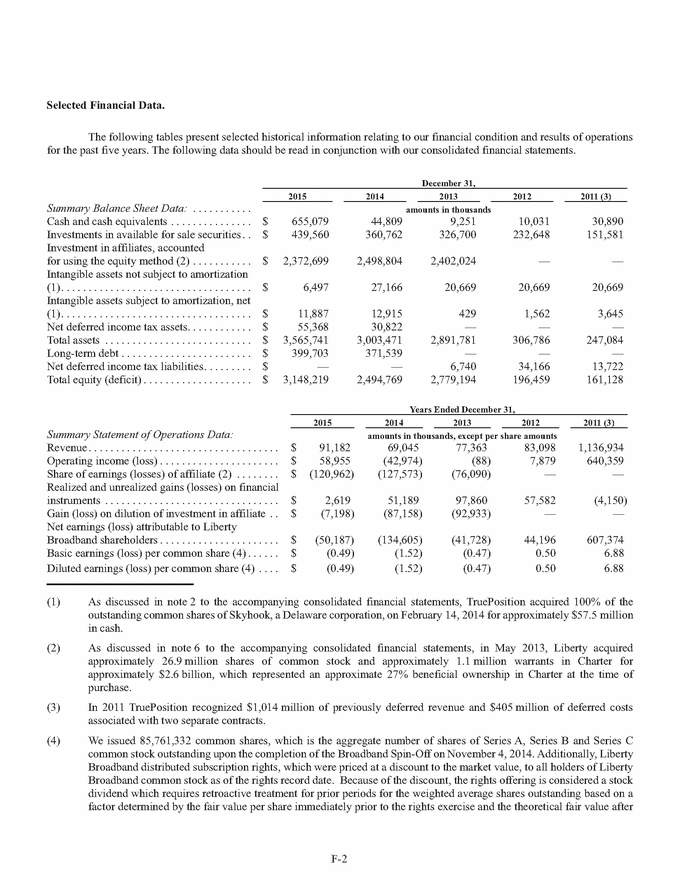
the rights exercise. The number of shares issued upon completion of the Broadband Spin-Off, adjusted for the rights factor, was used to determine both basic and diluted earnings (loss) per share (“EPS”) for the years ended December 31, 2013 and 2012 and for the period from January 1, 2014 through the date of the Broadband Spin-Off, as no Company equity awards were outstanding prior to the Broadband Spin-Off. Basic EPS subsequent to the Broadband Spin-Off was computed using the weighted average number of shares outstanding (“WASO”), adjusted for the rights factor, from the date of the completion of the Broadband Spin-Off through January 9, 2015, the date on which the rights offering was fully subscribed. Diluted EPS subsequent to the Broadband Spin-Off was computed using the WASO from the date of the completion of the Broadband Spin-Off through January 9, 2015, adjusted for the rights factor and potentially dilutive equity awards outstanding during the same period. Subsequent to January 9, 2015, basic EPS was computed using the WASO during the period, and diluted EPS was computed using the WASO adjusted for potentially dilutive equity awards outstanding during the period.
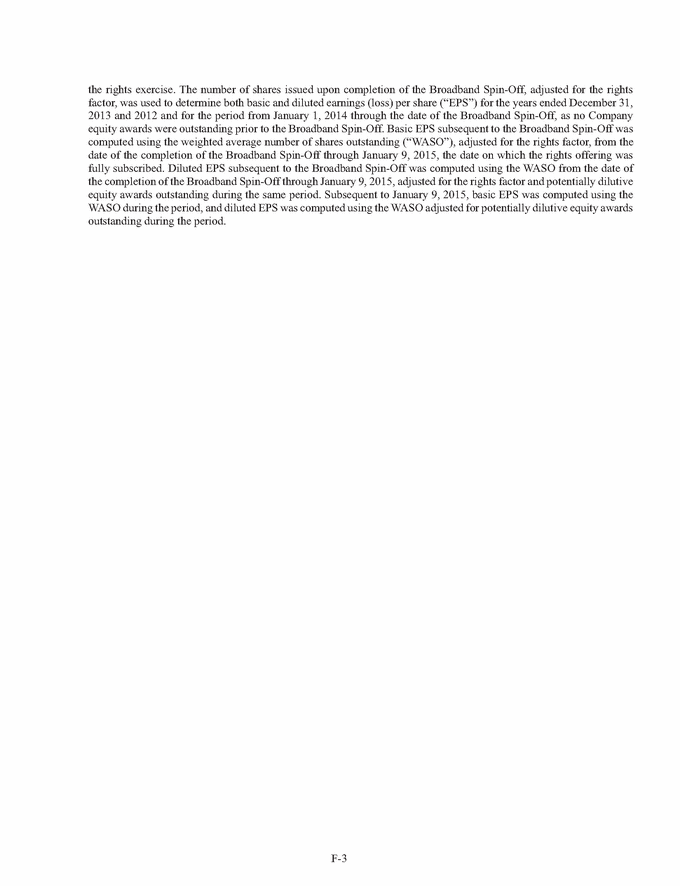
Management's Discussion and Analysis of Financial Condition and Results of Operations The following discussion and analysis provides information concerning our results of operations and financial condition. This discussion should be read in conjunction with our accompanying consolidated financial statements and the notes thereto. Overview During May 2014, the board of directors of Liberty Media Corporation and its subsidiaries (“Liberty”) authorized management to pursue a plan to spin-off to its stockholders common stock of a wholly-owned subsidiary, Liberty Broadband Corporation (“Liberty Broadband”), and to distribute subscription rights to acquire shares of Liberty Broadband’s common stock (the “Broadband Spin-Off”). At 5:00 p.m., New York City time, on November 4, 2014, the Broadband Spin-Off was completed and shares of Liberty Broadband common stock were distributed to the shareholders of Liberty as of a record date of 5:00 p.m., New York City time, on October 29, 2014. Liberty Broadband is comprised of, among other things, (i) Liberty’s former interest in Charter Communications, Inc. (“Charter”), (ii) Liberty’s former wholly-owned subsidiary TruePosition, Inc. (“TruePosition”), (iii) Liberty’s former minority equity investment in Time Warner Cable, Inc. (“Time Warner Cable” or “TWC”), (iv) certain deferred tax liabilities, as well as liabilities related to the Time Warner Cable written call options and (v) initial indebtedness, pursuant to margin loans entered into prior to the completion of the Broadband Spin-Off. The Broadband Spin-Off was accounted for at historical cost due to the pro rata nature of the distribution to holders of Liberty common stock. In the Broadband Spin-Off, record holders of Liberty Series A, Series B and Series C common stock received one-fourth of a share of the corresponding series of Liberty Broadband common stock for each share of Liberty common stock held by them as of 5:00 p.m., New York City time on October 29, 2014 (the record date) for the Broadband Spin-Off, with cash paid in lieu of fractional shares. In addition, following the completion of the Broadband Spin-Off, on December 10, 2014, stockholders received a subscription right to acquire one share of Series C Liberty Broadband common stock for every five shares of Liberty Broadband common stock they held as of 5:00 p.m., New York City time, on December 4, 2014 (the rights record date) at a per share subscription price of $40.36, which was a 20% discount to the 20-trading day volume weighted average trading price of the Series C Liberty Broadband common stock following the completion of the Broadband Spin-Off. The rights offering was fully subscribed on January 9, 2015, with 17,277,224 shares of Series C common stock issued to those rightsholders exercising basic and, as applicable, oversubscription privileges. The subscription rights were issued to raise capital for general corporate purposes of Liberty Broadband. The Broadband Spin-Off and rights offering were intended to be tax-free to stockholders of Liberty. During September 2015, Liberty entered into a closing agreement with the IRS which provided that the Broadband Spin-Off qualified for tax-free treatment. The financial information represents a combination of the historical financial information of TruePosition, Liberty Broadband’s interest in Charter, Liberty’s minority equity investment in Time Warner Cable and certain deferred tax liabilities, as well as liabilities related to the Time Warner Cable written call options. This financial information refers to the combination of the aforementioned subsidiary, investments, and financial instruments, as “Liberty Broadband,” “the Company,” “us,” “we” and “our” here and in the notes to the consolidated financial statements. Strategies and Challenges Executive Summary Our results prior to May 2013 were largely dependent on the operating performance of TruePosition. In 2013 and future periods, results for Liberty Broadband will be largely dependent upon the operating performance of Charter. Therefore, the executive summary below contains the strategies and challenges of TruePosition and Charter. TruePosition was incorporated on November 24, 1992. TruePosition develops and markets technology for locating wireless phones and other wireless devices on a cellular network, enabling wireless carriers to provide public safety E-9-1-1 services domestically and to enhance services in support of commercial applications, national security and law enforcement worldwide. “E-9-1-1” refers to a series of FCC mandates requiring wireless carriers to implement and continuously improve the ability to locate wireless callers requesting emergency services. Prior to 2015, TruePosition’s location system offering was a passive network overlay system using its patented U-TDOA technology. In 2015, TruePosition ceased making further investment in its U-TDOA based product offering and commenced the development and marketing of TrueFix, a location offering which is
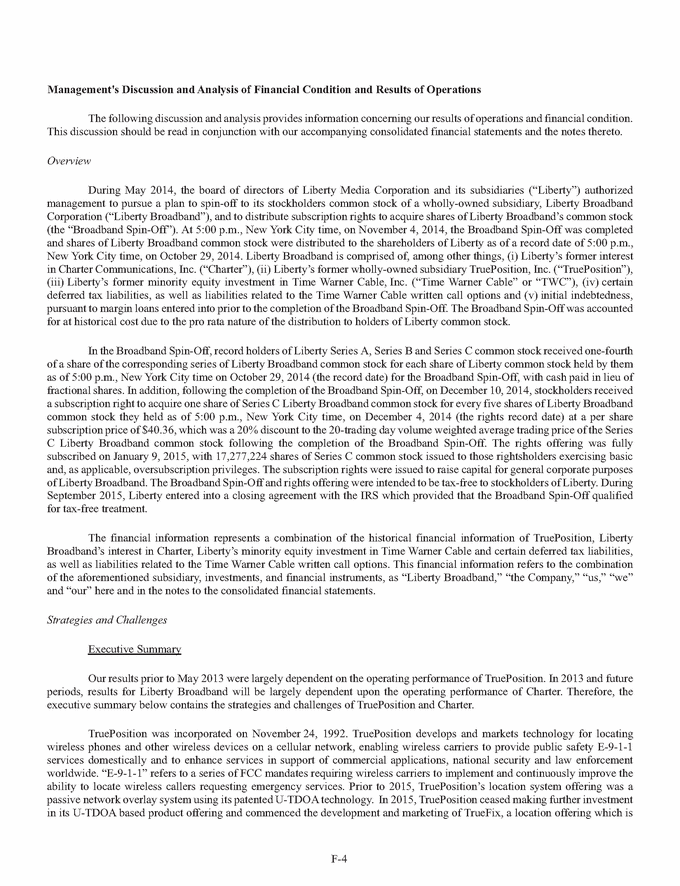
an extension of Skyhook’s WiFi location technology that determines the location of a wireless device by matching received WiFi signals to the known locations of WiFi access points contained in a proprietary reference database. TruePosition’s location system calculates the latitude and longitude of a designated wireless telephone or transmitter and forwards the information in real time to application software. Future enhancements, including reverse geo-coding and the integration with a National Emergency Address Database, may lead to refining the device location information to include a specific street address. On February 14, 2014, TruePosition completed the acquisition of Skyhook. Skyhook operates a global location network with more than 1 billion geolocated WiFi access points, providing hybrid wireless positioning technology and contextual location intelligence solutions worldwide. The large amount of data collected by Skyhook powers all of its products and provides Skyhook the ability to offer location and geo-informed context to any mobile app or device. Skyhook's location-based context solutions provide a way for companies and agencies to understand consumers' mobile behavior and improve mobile customer experience, while also allowing advertisers to reach their audiences in new and relevant ways. Charter is one of the largest providers of cable services in the United States with approximately 6.7 million residential and small and medium business customers at December 31, 2015, offering a variety of entertainment, information and communications solutions to residential and commercial customers, including traditional cable video programming, Internet services, and voice services, as well as advanced video services such as video on demand, HD television and DVR service. Charter also sells local advertising on cable networks and provides fiber connectivity to cellular towers and office buildings. Its infrastructure consists of a hybrid of fiber and coaxial cable plant with approximately 12.9 million estimated passings, with 97% at 550 MHz or greater and 98% of plant miles two-way active and 99% of plant all-digital. A national IP infrastructure interconnects Charter markets. Liberty acquired its interest in Charter on May 1, 2013. At December 31, 2015, Liberty Broadband owned approximately 28.8 million shares of Charter common stock, representing an approximate 26% ownership interest in the issued and outstanding shares. Under the Charter Stockholders Agreement, Liberty has the right to nominate four directors to the Charter board of directors, subject to certain exclusions and requirements. Liberty Broadband also has the right to cause one of its nominees to serve on the nominating and corporate governance, audit and compensation and benefits committees of the board, provided they meet the independence and other qualifications for membership on those committees. These rights were transferred from Liberty to Liberty Broadband in connection with the Broadband Spin-Off. The Second Amended and Restated Stockholders Agreement continues to provide us with board nomination rights. Key Drivers of Revenue TruePosition earns revenue from the sale of hardware and licensing of software required to generate location records for wireless phones and other wireless devices on a cellular network and from the design, installation, testing and commissioning of such hardware and software. In addition, TruePosition earns software maintenance revenue through the provision of ongoing technical and software support. Through its Skyhook subsidiary, TruePosition earns revenue from device manufacturers, application providers and advertising networks by licensing access to Skyhook’s location and geo-informed context network. Charter revenue is derived principally from the monthly fees customers pay for the residential and commercial video, Internet and voice services provided. Charter also earns revenue from one-time installation fees and advertising sales. Charter expects to continue to grow revenue by increasing the number of products in the company’s current customer homes and obtaining new customers with an improved value offering. In addition, Charter expects to increase revenue by expanding the sales of services to its commercial customers. Current Trends Affecting Our Business TruePosition’s location systems compete against a number of suppliers of both WiFi based technology solutions and other satellite and terrestrial based technology offerings. In addition, there are a number of new location technologies in development which may further increase competition to be a location solution for new air interfaces to provide commercial location based services and to meet more stringent commercial and governmental accuracy standards. Other large technology companies, such as Google, similarly facilitate the provision of location information to devices and applications operating on their mobile platforms. Charter faces competition for both residential and commercial customers in the areas of price, service offerings, and service reliability. With respect to its residential business, Charter competes with other providers of video, high-speed Internet
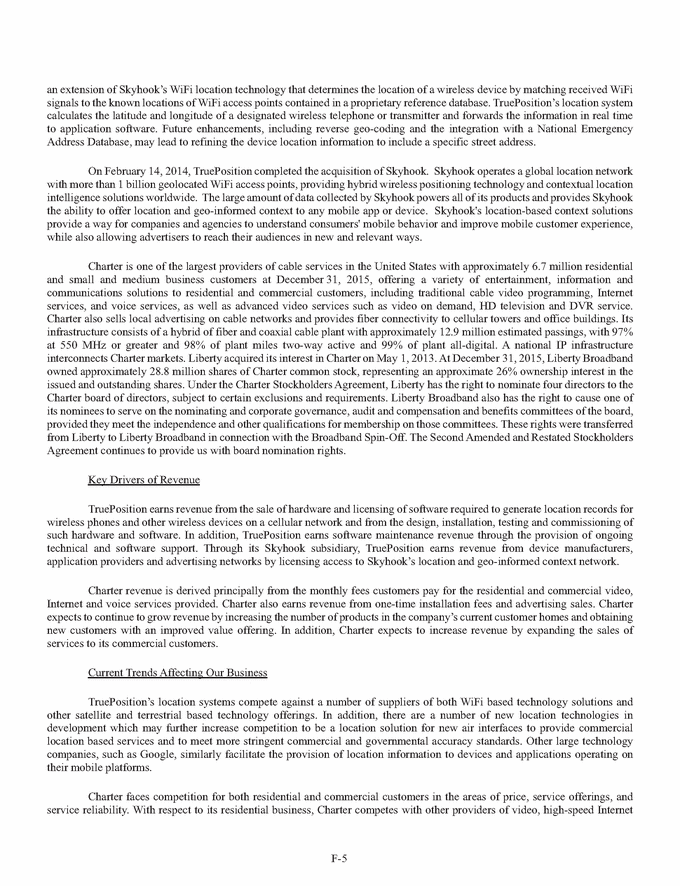
access, telephone services, and other sources of home entertainment. With respect to its commercial business, Charter competes with other providers of video, high-speed Internet access and related value-added services, fiber solutions, business telephony, and Ethernet services. In the broadband communications industry, Charter’s principal competitors for video services are DBS and telephone companies that offer video services. Charter’s principal competitors for high-speed Internet services are the broadband services provided by telephone companies, including both traditional DSL, fiber-to-the-node, and fiber-to-the-home offerings. Charter’s principal competitors for telephone services are established telephone companies, other telephone service providers, and other carriers, including VoIP providers. At this time, Charter does not consider other traditional cable operators to be significant competitors in the overall market, as overbuilds are infrequent and geographically spotty (although in any particular market, a cable operator overbuilder would likely be a significant competitor at the local level). Charter could, however, face additional competition from multi-channel video providers if they began distributing video over the Internet to customers residing outside their current territories. TruePosition and Charter must stay abreast of rapidly evolving technological developments and offerings to remain competitive and increase the utility of their products and services. These companies must be able to incorporate new technologies into their products and services in order to address the needs of their customers. Results of Operations—Consolidated Consolidated operating results: Years ended December 31, 2015 2014 2013 amounts in thousands Revenue $ 91,182 69,045 77,363 Operating expenses, excluding stock-based compensation Operating expense 6,089 7,499 23,442 Selling, general and administrative 36,814 46,946 33,317 Research and development 16,637 18,311 15,314 Adjusted OIBDA 31,642 (3,711) 5,290 Stock-based compensation 6,380 999 996 Depreciation and amortization 6,088 9,043 4,382 Gain on legal settlement (60,450) (6,000) — Impairment of intangible assets 20,669 35,221 — Operating income (loss) $ 58,955 (42,974) (88) Revenue Revenue increased $22.1 million and decreased $8.3 million for the years ended December 31, 2015 and 2014, respectively, as compared to the corresponding prior year periods. The increase in revenue during 2015 was primarily due to the recognition of $35.5 million of deferred revenue upon the expiration of TruePosition’s contract with its largest customer on December 31, 2015, as all contractual obligations were satisfied at that time. This customer accounted for approximately 85%, 83% and 85% of TruePosition’s revenue during 2015, 2014 and 2013, respectively. As a result, a significant decline in TruePosition’s future operating results is expected unless TruePosition is able to generate significant new business to replace the financial impact of this customer. Exclusive of the recognition of the deferred revenue associated with this contract during 2015, revenue decreased $13.4 million from the prior year, due to a $15.3 million revenue decline at TruePosition, partially offset by a $1.9 million increase at Skyhook. The decrease in TruePosition’s revenue was primarily a result of reduced domestic software and maintenance license fees, due to a reduction in the size of the deployed base of TruePosition’s technologies. This decrease was partially offset by a $1.9 million increase in revenue from Skyhook, due to a full year of revenue recognition during 2015, as Skyhook was acquired during February 2014. The decrease in revenue during 2014 was primarily due to reduced domestic hardware and software license sales as a result of uncertainty around new FCC indoor accuracy mandates. As a result of the uncertainty, many wireless carrier companies delayed investments in location technologies. Additionally, TruePosition experienced reduced hardware and software license sales in the international markets which was partially offset by Skyhook revenue subsequent to its acquisition in early 2014. On January 29, 2015, the FCC adopted indoor location accuracy rules in its Fourth Report and Order, redefining location accuracy standards that wireless carriers will be required to meet in future years.
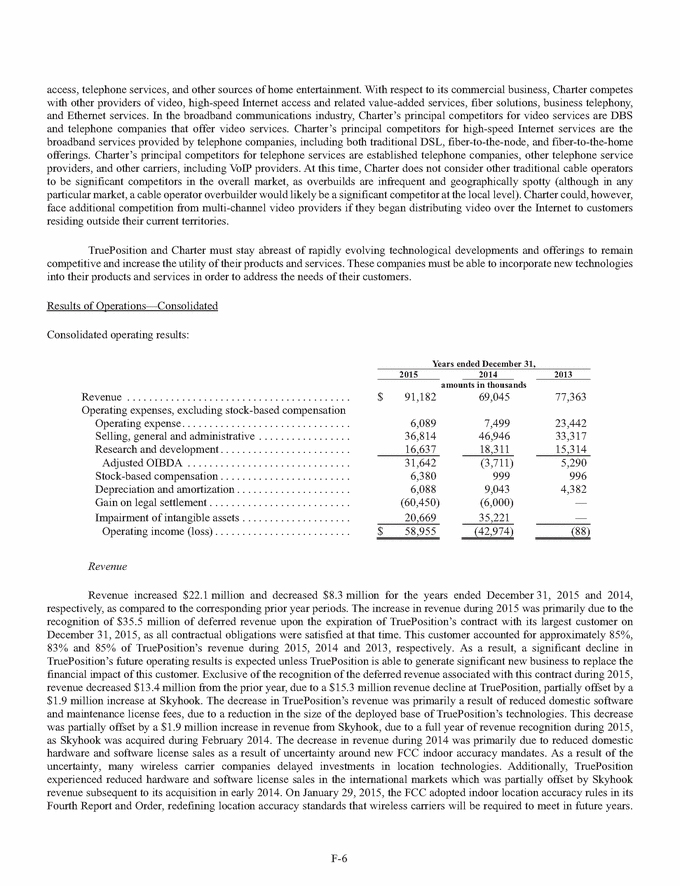
TruePosition’s technologies, including new technologies now under development, will compete with other technologies to satisfy the new standards in the coming years. Adjusted OIBDA We define Adjusted OIBDA as revenue less operating expenses and selling, general and administrative expenses (excluding stock compensation). Our chief operating decision maker and management team use this measure of performance in conjunction with other measures to evaluate our businesses and make decisions about allocating resources among our businesses. We believe this is an important indicator of the operational strength and performance of our businesses, including each business’s ability to service debt and fund capital expenditures. In addition, this measure allows us to view operating results, perform analytical comparisons and benchmarking between businesses and identify strategies to improve performance. This measure of performance excludes such costs as depreciation and amortization, stock-based compensation, separately reported litigation settlements and restructuring and impairment charges that are included in the measurement of operating income pursuant to GAAP. Accordingly, Adjusted OIBDA should be considered in addition to, but not as a substitute for, operating income, net income, cash flow provided by operating activities and other measures of financial performance prepared in accordance with GAAP. See note 15 to the accompanying consolidated financial statements for a reconciliation of Adjusted OIBDA to Earnings (loss) from continuing operations before income taxes. Adjusted OIBDA improved $35.4 million and decreased $9.0 million in the years ended December 31, 2015 and 2014, respectively, as compared to the corresponding prior year periods. In addition to the $22.1 million increase in revenue, discussed above, Adjusted OIBDA in 2015 was positively impacted by a $10.2 million decline in legal expenses during the year (discussed below) and a $3.1 million improvement in operating expenses during the year. The decrease in Adjusted OIBDA during 2014 was primarily a result of increased legal expenses, cost of the Skyhook acquisition and Skyhook generating negative Adjusted OIBDA, partially offset by the full year impact of cost reduction measures undertaken in 2013. The reduction in overall revenue of $8.3 million, discussed above, was offset by lower cost of goods sold of $15.2 million, primarily due to reduced international sales, which have lower margins than domestic sales. During 2013 TruePosition entered into an international project for which revenue was only recognized to the extent cash was received, as future collectability of revenue was unsure. Therefore, the gross margin on that particular project was dependent on the payments received from the customer. This project was canceled as of the end of 2013 and therefore there was less revenue and cost of goods sold recognized for the year ended December 31, 2014. Legal expenses decreased $10.2 million and increased $5.8 million in the years ended December 31, 2015 and 2014, respectively, as compared to the corresponding prior years. Legal expenses are included in selling, general and administrative expenses. The decrease in legal costs during 2015 and the increase in legal costs during 2014 is primarily a result of TruePosition's antitrust lawsuit arising from the standard setting processes for LTE wireless data communication technology as it pertains to location technology, which was settled during the third quarter of 2014, and Skyhook’s patent infringement lawsuit against Google, which was settled during the first quarter of 2015. Additionally, lobbying costs of $431 thousand, $3.3 million and $3.4 million related to the indoor accuracy regulations previously discussed were incurred during each of the years ended December 31, 2015, December 31, 2014 and December 31, 2013, respectively. Lobbying expenses are also included in selling, general and administrative expenses. Subsequent to the first quarter of 2015, these costs have significantly declined due to rulemaking timelines. Merger costs of $958 thousand and $624 thousand related to the Skyhook acquisition were incurred in 2014 and 2013, respectively. No merger costs were incurred during 2015. Merger costs are included in selling, general and administrative costs. Operating expenses, research and development, and selling, general and administrative, excluding legal expenses and merger costs, discussed above, decreased $2.0 million and increased by $9.7 million in the years ended December 31, 2015 and 2014, respectively, as compared to the corresponding prior year periods. The decrease in 2015 was largely due to a full year implementation of cost reduction measures at TruePosition, partially offset by higher corporate selling, general and administrative costs during the current year. The increase in 2014 was primarily due to operating and selling, general and administrative expenses related to Skyhook of $13.5 million against revenue of $8.4 million for the year ended December 31, 2014.
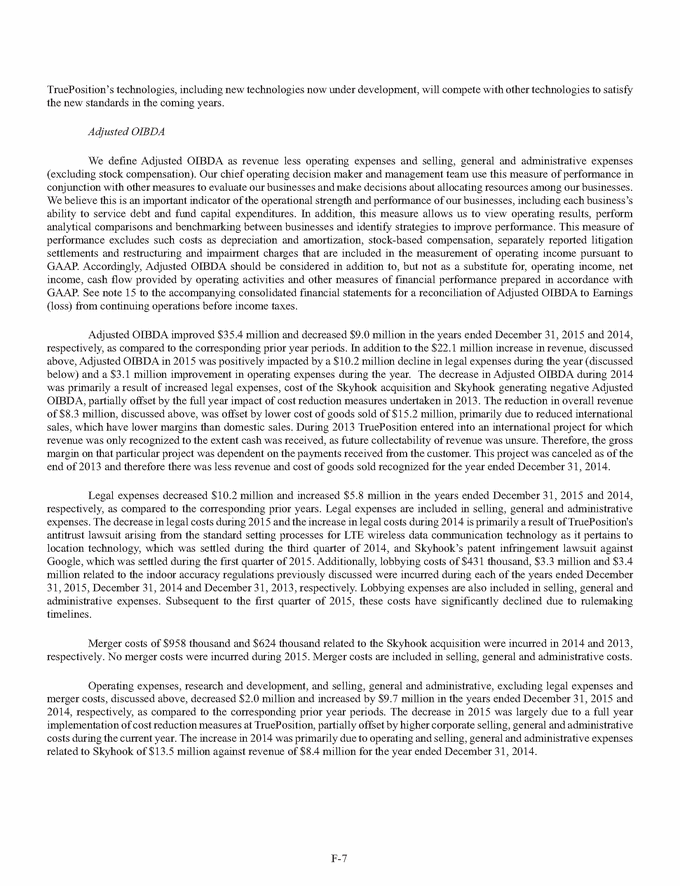
Operating Income (Loss) Operating income (loss) improved $101.9 million and declined $42.9 million for the years ended December 31, 2015 and 2014, respectively, as compared to the corresponding prior year periods. In addition to those items impacting Adjusted OIBDA, operating income (loss) for the year ended December 31, 2015 was further impacted by a favorable net legal settlement of $60.5 million (an improvement of $54.5 million from the prior year) due to the settlement of Skyhook’s patent infringement lawsuit against Google during the first quarter of 2015 and a decrease in depreciation and amortization of $3.0 million, partially offset by a $20.7 million impairment expense (a $14.6 million improvement from the prior year) recorded during the current year and an increase in stock-based compensation expense of $5.4 million. In addition to those items impacting Adjusted OIBDA, operating income (loss) for the year ended December 31, 2014 was further impacted by an increase in depreciation and amortization of $4.7 million and a $35.2 million impairment of goodwill and intangible assets, partially offset by a $6.0 million favorable legal settlement of the antitrust lawsuit in July 2014. Stock-based compensation expense increased $5.4 million and $3 thousand for the years ended December 31, 2015 and 2014, respectively. The increase in stock-based compensation during the current year was primarily due to the vesting of options to purchase shares of Liberty Broadband Series C common stock granted during December 2014 and an increase in the number of options to purchase shares of Series C Liberty Broadband common stock granted during the current year. Additionally, TruePosition’s stock-based compensation increased during the current year due to the issuance of new awards and additional vesting of the outstanding awards under the plans, partially offset by cancelled awards. Depreciation and amortization decreased $3.0 million and increased $4.7 million for the years ended December 31, 2015 and 2014, respectively, as compared to the corresponding prior year periods. The decrease in depreciation and amortization expense during the current year is primarily due to lower amortization expense resulting from the impairment of TruePosition’s intangible assets related to Skyhook during the fourth quarter of 2014 and write-off of fixed assets during the first quarter of 2015. The assets written off were comprised of assets related to the abandonment of a product development project by TruePosition during the period. The increase in 2014 was primarily due to the acquisition of Skyhook during the year. On September 10, 2010, Skyhook Wireless, Inc. filed a patent infringement lawsuit in the U.S. District Court for the District of Massachusetts against Google, Inc. In March 2013, Skyhook amended its lawsuit to add additional claims. The case had been scheduled to be tried before a jury commencing March 9, 2015, with Skyhook alleging at that time that Google infringed on eight Skyhook patents involving location technology and seeking an injunction and/or award of damages in an amount to be determined at trial. However, on March 5, 2015, the parties advised the District Court that the case had been settled and thereby dismissed the action without costs and without prejudice to the right, upon good cause shown within 45 days, to reopen the action if settlement is not consummated. On March 27, 2015, the parties consummated a final settlement agreement and on April 24, 2015, Google paid Skyhook settlement consideration of $90 million. In return for payment of the settlement consideration, Google received dismissal of the action with prejudice, a license to the existing Skyhook patents and patent applications (and their continuations, divisionals, continuations-in-part), a three-year covenant not to sue (subject to limited exceptions) and a mutual release of claims. As a result of the settlement, Skyhook realized a net gain, after legal fees, of approximately $60.5 million during the first quarter of 2015. During September 2015, AT&T gave notice to TruePosition that it did not intend to renew its contract, which expired on December 31, 2015. The Company believed that the receipt of the notification represented a significant change in circumstances since we last performed our annual goodwill impairment test. Accordingly, we performed a goodwill impairment test upon receipt of the notification from TruePosition. At that time, the estimated fair value of the reporting unit was primarily determined based on the cash and cash equivalents held by the reporting unit, and when compared to its carrying value, it was concluded that a goodwill impairment did not exist. As previously discussed, the carrying value of TruePosition included a $35.5 million deferred revenue liability related to the contract with the largest customer. Upon expiration of the contract on December 31, 2015, the deferred revenue was recognized, as all contractual obligations were satisfied at that time. The recognition of this deferred revenue liability increased the reporting unit carrying value. As a result, the Company determined the fair value of TruePosition. As the reporting unit’s carrying value exceeded the fair value, we performed a Step 2 impairment test and recorded a $20.7 million impairment loss related to TruePosition’s goodwill during December 2015. See note 2 and note 7 in the accompanying consolidated financial statements for additional discussion regarding this impairment loss. In November 2014, Skyhook was notified that one of its significant customers was not expected to renew its contract for 2015. As a result, 30-40% of Skyhook's revenue was not expected to recur in 2015. Due to this anticipated decline in Skyhook's
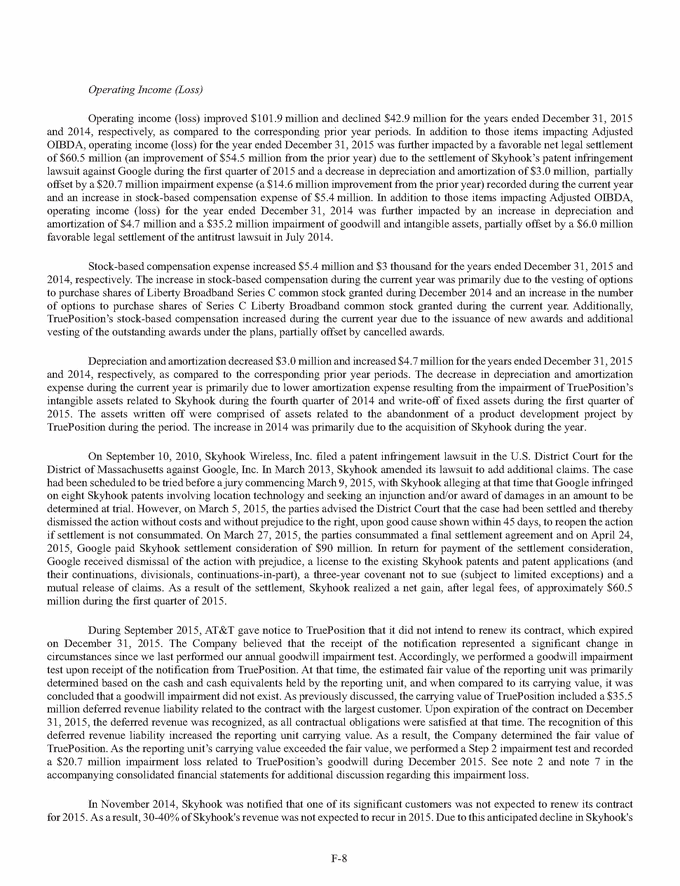
operations, the Company determined the fair value of Skyhook and performed a Step 2 impairment test, which resulted in a $35.2 million impairment loss recorded to TruePosition’s goodwill and intangible assets related to Skyhook during December 2014. See note 2 and note 7 in the accompanying consolidated financial statements for additional discussion regarding this impairment loss. Other Income and Expense: Components of Other Income (Expense) are presented in the table below. Years ended December 31, 2015 2014 2013 amounts in thousands Other income (expense): Interest expense $ (7,424) (1,138) — Dividend and interest income 3,797 5,426 6,878 Share of earnings (losses) of affiliate (120,962) (127,573) (76,090) Realized and unrealized gains (losses) on financial instruments, net 2,619 51,189 97,860 Gain (loss) on dilution of investment in affiliate (7,198) (87,158) (92,933) Other, net .158 (63) (53) $ (129,010) (159,317) (64,338) Interest expense Interest expense during the years ended December 31, 2015 and 2014 is attributable to two margin loans entered into with each of the lenders party thereto by BroadbandSPV on October 30, 2014, in connection with and prior to the effectiveness of the Broadband Spin-Off. See note 8 in the accompanying consolidated financial statements for additional information on the margin loan agreements. Dividend and interest income Dividend and interest income decreased $1.6 million and $1.5 million for each of the years ended December 31, 2015 and 2014, respectively, as compared to the corresponding prior year periods. The decrease in both years was primarily due to contractual commitments on the Time Warner Cable shares. Although the 2015 quarterly Time Warner Cable dividend rate remained the same as 2014, a larger portion of the dividends were passed through to the counterparty in 2015, due to more written call option contracts on Time Warner Cable shares outstanding during 2015 than 2014 as well as the Time Warner Cable collar agreement that was outstanding for a portion of the current year. The Time Warner Cable dividend rate increased from $0.65 per share per quarter in 2013 to $0.75 per share per quarter in 2014. However, interest and dividend income decreased in 2014 due to contractual commitments on the Time Warner Cable shares, as a portion of the dividends were passed through to the counterparty in 2014 based on the written call option contracts on Time Warner Cable shares. Share of earnings (losses) of affiliates Share of losses from affiliates improved $6.6 million and declined $51.5 million during the years ended December 31, 2015 and 2014, respectively, as compared to the corresponding prior year periods. Share of losses from affiliates is attributable to the Company’s ownership interest in Charter. In May 2013, the Company acquired approximately 26.9 million shares of common stock and approximately 1.1 million warrants in Charter for approximately $2.6 billion, which represented an approximate 27% beneficial ownership (including the warrants on an as if converted basis) in Charter at the time of purchase. Upon acquisition, the Company allocated the excess basis, between the book basis of Charter and fair value of the shares acquired, and ascribed remaining useful lives of 7 years and 13 years to property and equipment and customer relationships, respectively, and indefinite lives to franchise fees, trademarks and goodwill. Outstanding debt is amortized over the contractual period using the effective interest rate method. Amortization related to debt and intangible assets with identifiable useful lives is included in the Company’s share of earnings (losses) from affiliates line item in the accompanying consolidated statements of operations and aggregated $51.6 million and $81.2 million, net of related taxes, for the years ended December 31, 2015 and 2014, respectively. See note 6 in the accompanying notes to the consolidated financial statements for additional discussion of the Company’s investment in Charter.
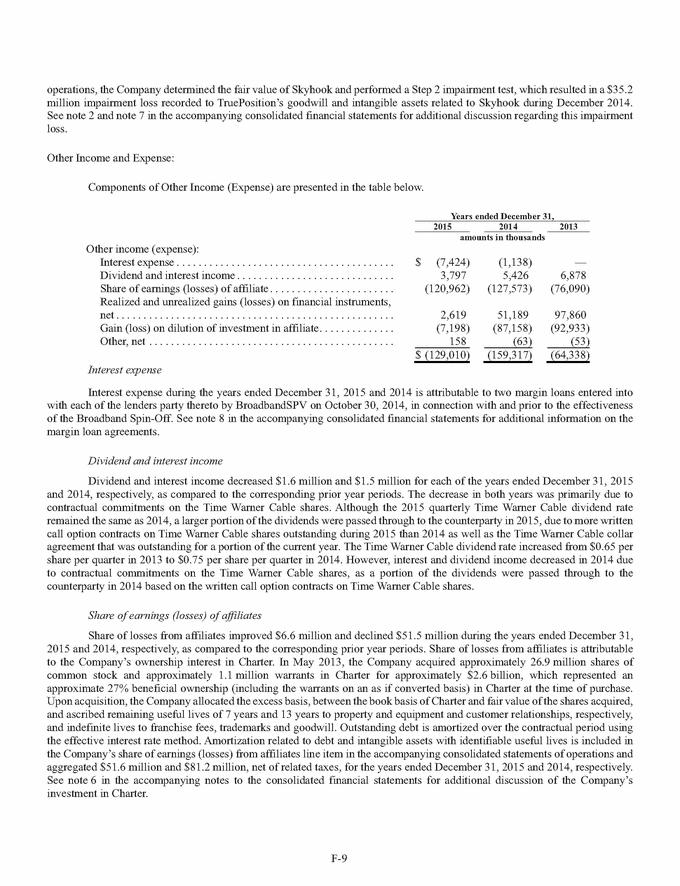
The following is a discussion of Charter’s stand alone results of operations. In order to provide a better understanding of Charter’s operations, we have included a summarized presentation of Charter’s results from operations. Charter is a separate publicly traded company and additional information about Charter can be obtained through its website and public filings. The amounts included in the table below represent Charter’s results for each of the years ended December 31, 2015, 2014 and 2013. However, the portion of Charter’s share of earnings (losses) included in our consolidated financial statements only includes Charter’s results from the time of acquisition (May 2013) through December 31, 2015. Years ended December 31, 2015 2014 2013 amounts in millions Revenue $ 9,754 9,108 8,155 Operating expenses, excluding stock-based compensation (6,437) (5,980) (5,344) Adjusted OIBDA 3,317 3,128 2,811 Depreciation and amortization (2,125) (2,102) (1,854) Stock-based compensation (78) (55) (48) Operating income 1,114 971 909 Other expenses, net (1,445) (918) (958) Net income (loss) before income taxes (331) 53 (49) Income tax benefit (expense) 60 (236) (120) Net loss $ (271) (183) (169) Charter’s revenue increased $646 million and $953 million during the years ended December 31, 2015 and 2014, respectively, as compared to the corresponding prior years. Revenue growth primarily reflects increases in the number of residential Internet and triple play customers and in commercial business customers, growth in expanded basic and digital penetration, promotional and annual rate increases, and higher advanced services penetration, partially offset by a decrease in advertising sales in 2015 and a decrease in average basic video customers. Additionally, Charter’s acquisition of Bresnan on July 1, 2013 increased revenue by approximately $276 million in 2014 as compared to 2013. The increase in revenue during 2015 was partially offset by the net impact of an increase in operating expenses, excluding stock-based compensation, of $457 million. The increase in operating expenses was primarily attributable to an increase in programming costs as a result of annual contractual rate adjustments, including increases in amounts paid for retransmission consents, broader carriage of certain networks as a result of Charter’s all-digital initiative and the introduction of new networks to Charter’s video offering as well as 2014 expense benefits not recurring in 2015. Depreciation and amortization also increased $23 million, stock compensation expense remained flat, other expenses increased $527 million and income tax benefit (expense) improved $296 million. The increase in depreciation and amortization expense is primarily attributable to the depreciation on recent capital expenditures, partially offset by certain assets becoming fully depreciated. The increase in other expenses is primarily attributable to an increase of $431 million of interest expense during 2015 related to debt held in escrow during the year to fund the Comcast Transactions, Time Warner Cable Merger and the Bright House Transaction, as defined in note 6 to the accompanying consolidated financial statements. Additionally, Charter recognized a loss on extinguishment of debt of $128 million during 2015 in connection with the repayment of certain term loans during April 2015. The income tax benefit recognized in 2015 was primarily due to the deemed liquidation of Charter Communications Holding Company, LLC (“Charter Holdco”) solely for federal and state income tax purposes, resulting in a $187 million deferred income tax benefit offset by income tax expense recognized during 2015, primarily through increases in deferred tax liabilities. Charter owns a 100% equity interest in Charter Holdco and was treated as a partnership for tax purposes prior to July 2, 2015. The impact of the election to treat Charter Holdco as a disregarded entity resulted in a $169 million net deferred income tax benefit. Income tax benefit (expense) also improved due to a reduction in tax amortization for fully amortized intangible assets that are indefinite-lived for book purposes. The increase in revenue during 2014 was partially offset by the net impact of a $636 million increase in operating expenses, excluding stock compensation expense, a $248 million increase in depreciation and amortization expense, a $7 million increase in stock-based compensation expense, a $40 million decrease in other expenses and an increase in income tax expense of $116 million. The increase in operating expense is primarily attributable to a full year of costs associated with Charter’s acquisition of Bresnan on July 1, 2013, increases in programming costs as a result of annual contractual rate adjustments, including increases in amounts paid for retransmission consents and for new programming, offset in part by video customer losses. Transition costs related to transactions with Comcast accounted for $14 million of total 2014 operating costs. The increase
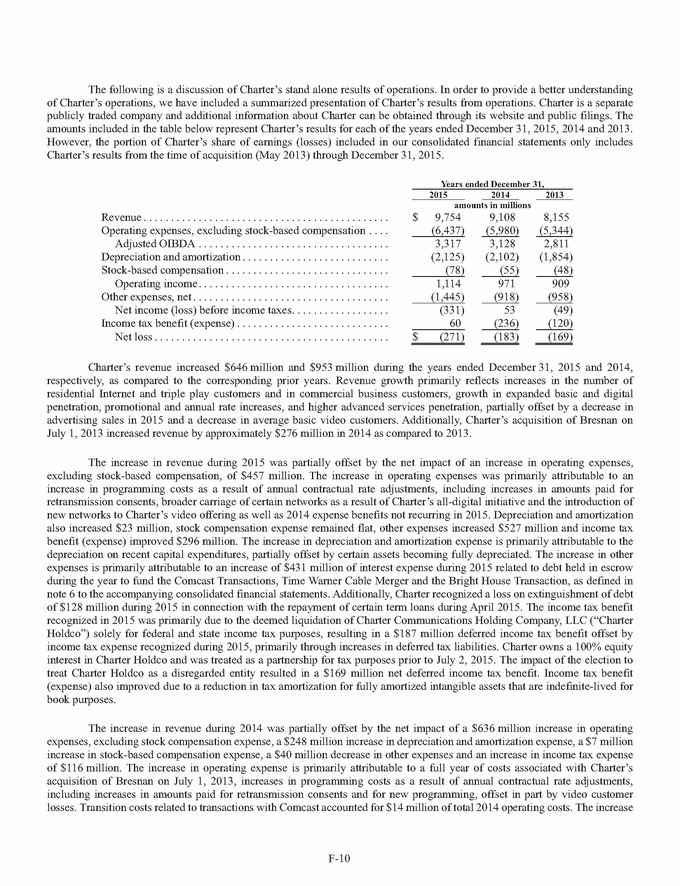
in depreciation expense is primarily attributable to the acquisition of Bresnan and depreciation on recent capital expenditures, partially offset by certain assets becoming fully depreciated. The increase in stock-based compensation expense was due to an increase in the number of options granted during the year along with an increase in the weighted average grant price of options and restricted stock granted and vested during the year. The decrease in other expenses is primarily attributable to a $123 million loss on extinguishment of debt that was recognized during the year ended December 31, 2013. Income tax expense for the year ended December 31, 2013 included a step-up in basis of indefinite-lived assets for tax, but not GAAP purposes, resulting from the effects of partnership gains related to financing transactions, which decreased Charter's net deferred tax liability related to indefinite-lived assets resulting in a benefit of $67 million. Realized and unrealized gains (losses) on financial instruments, net Realized and unrealized gains on financial instruments, net decreased $48.6 million and $46.7 million for each of the years ended December 31, 2015 and 2014, respectively, as compared to the corresponding prior year periods. Net realized and unrealized losses on financial instruments during 2015 were attributable to changes in the fair value of our investment in Time Warner Cable and corresponding collar agreement and written call options. The change in fair value of our investment in Time Warner Cable is typically directly correlated to changes in the underlying Time Warner Cable stock price. The change in fair value of our derivative instruments related to our investment in Time Warner Cable is typically inversely correlated to changes in the underlying Time Warner Cable stock price. The net realized and unrealized gain of $2.6 million during 2015 was primarily due to gains in the fair value of our investment in Time Warner Cable, partially offset by losses on the Time Warner Cable call options and collar, due to increases in the Time Warner Cable stock price during the year. Realized and unrealized gains on financial instruments, net during 2014 were primarily attributable to changes in fair value of the Charter warrants. Changes in the fair value of the Charter warrants were directly correlated to changes in the underlying Charter share price. A gain of $32.8 million attributable to the Charter warrants acquired during May 2013 was due to an improvement in the Charter price per share of outstanding stock during the year ended December 31, 2014. As discussed in note 6 to the accompanying consolidated financial statements, Liberty Broadband exercised of all of the Company’s outstanding Charter warrants during November 2014, subsequent to the completion of the Broadband Spin-Off. Additionally, a net gain of $18.4 million on the investment in Time Warner Cable shares and outstanding call options were recorded during 2014. The net gain was primarily due to gains in our investment in Time Warner Cable, partially offset by losses on the Time Warner Cable call options, due to an improvement in the Time Warner Cable price per share of outstanding stock during the respective period. Gain (loss) on dilution of investment in equity affiliate The losses in 2015 and 2014 are the result of the issuance of Charter common stock from the exercise of warrants and stock options held by outside investors (employees and other third parties), at prices below Liberty Broadband’s book basis per share. As Liberty Broadband’s ownership in Charter changes due to exercises of Charter warrants and stock options, a loss is recorded with the effective sale of common stock, because the exercise price of Charter warrants or stock options is typically lower than the book value of the Charter shares held by Liberty Broadband. Other, net Other income (expenses) improved $221 thousand and declined $10 thousand for each of the years ended December 31, 2015 and 2014, respectively, as compared to the corresponding prior year periods. The improvement during 2015 is primarily attributable to a gain on TruePosition fixed assets that were retired during the year. The decline in 2014 is primarily attributable to an increase in income tax penalties during the year. Income taxes Our effective tax rate for the years ended December 31, 2015, 2014 and 2013 was 28%, 33% and 35%, respectively. During 2015, our effective tax rate was lower than the federal tax rate of 35% primarily due to the non-deductible impairment of goodwill related to TruePosition. During 2014, our effective tax rate was lower than the federal tax rate of 35% primarily due to the non-deductible impairment of goodwill and other amortizable intangible assets related to Skyhook. Net earnings (losses) We had net losses of $50.2 million, $134.6 million and $41.7 million for the years ended December 31, 2015, 2014 and 2013, respectively. The change in net losses was the result of the above-described fluctuations in our revenue, expenses and other gains and losses.
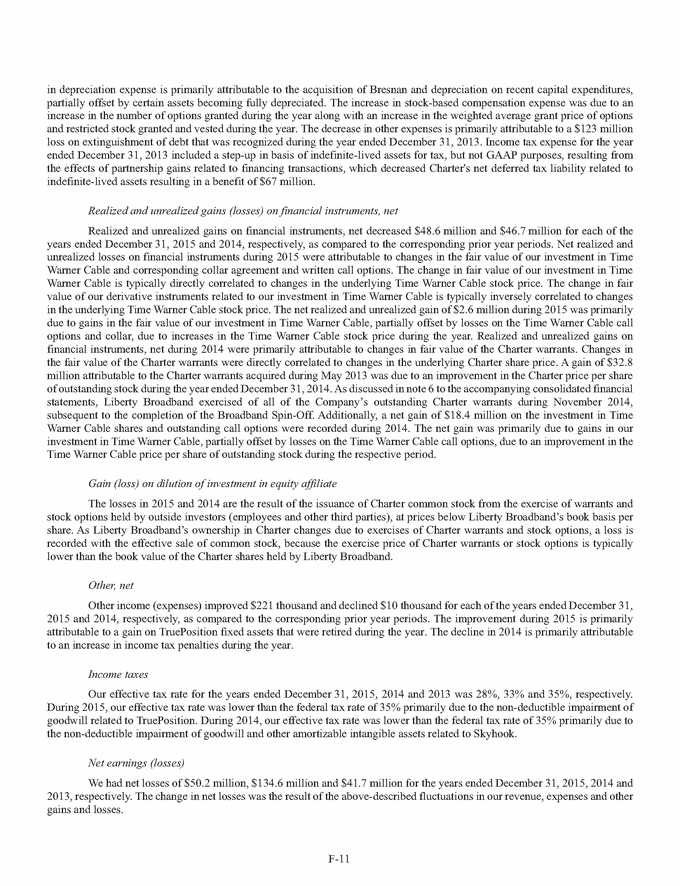
Liquidity and Capital Resources As of December 31, 2015 substantially all of our cash and cash equivalents are invested in U.S. Treasury securities, other government securities or government guaranteed funds, AAA rated money market funds and other highly rated financial and corporate debt instruments. The following are potential sources of liquidity: available cash balances, cash generated by the operating activities of our privately-owned subsidiaries (to the extent such cash exceeds the working capital needs of the subsidiaries and is not otherwise restricted), proceeds from asset sales, monetization of our other investments, outstanding debt facilities, debt and equity issuances, and dividend and interest receipts. As of December 31, 2015, Liberty Broadband had a cash balance of $655.1 million. In addition, Liberty Broadband had $438.9 million of unencumbered available for sale securities. Years ended December 31, 2015 2014 2013 amounts in thousands Cash flow information Net cash provided (used) by operating activities $ 34,072 2,728 5,475 Net cash provided (used) by investing activities .$ (2,479) (209,986) (2,624,868) Net cash provided (used) by financing activities $ 578,677 242,816 2,618,613 TruePosition generally collects the majority of its annual software maintenance from its customers during the first quarter of each calendar year, which is the most significant factor contributing to the cash generated from operations during 2014 and 2013. The most significant factor contributing to the cash generated from operations during 2015 was the receipt by Skyhook of legal settlement proceeds, partially offset by the payment of legal fees. Due to the expiration of TruePosition’s contract with a significant customer on December 31, 2015, we expect a decline in cash flows from operations in future periods. During the year ended December 31, 2015, our primary use of cash was $182.1 million in net settlements of financial instruments. This use of cash was funded by cash on hand and the receipt of $697.3 million in net proceeds from the rights offering during the year. The projected use of our cash will be the continued operational needs of our subsidiary, including potential investment in location technology at TruePosition, or other investment opportunities. As discussed in note 6 of the accompanying consolidated financial statements, in support of the Time Warner Cable Merger, the Company expects to issue $4.4 billion additional shares of Liberty Broadband Series C common stock in order to purchase $4.3 billion in shares of New Charter. However, Liberty Broadband has the right, and may determine, to incur debt financing (subject to certain conditions) to fund a portion of the purchase price for such shares of New Charter, in which case Liberty Broadband may reduce the aggregate Series C share subscriptions by up to 25%, with such reduction applied pro rata to all investors. The Series C share subscriptions are subject to customary closing conditions, and funding will only occur upon the completion of the Time Warner Cable Merger. Furthermore, as also discussed in note 6 of the accompanying consolidated financial statements, Liberty Broadband expects to use a portion of the proceeds from the rights offering to purchase an additional $700 million of New Charter shares in connection with Charter’s proposed acquisition of Bright House Networks from A/N.
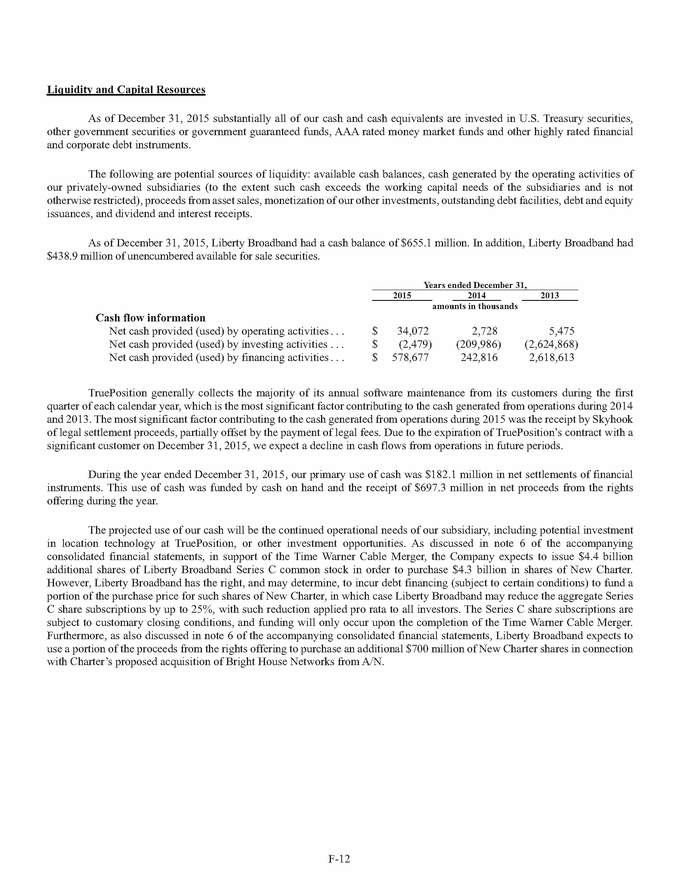
Off-Balance Sheet Arrangements and Aggregate Contractual Obligations Information concerning the amount and timing of required payments, both accrued and off-balance sheet, under our contractual obligations, excluding uncertain tax positions as it is indeterminable when payments will be made, is summarized below. Payments due by period Less than After Total 1 year 2 - 3 years 4 - 5 years 5 years amounts in thousands Consolidated contractual obligations Long-term debt $ 400,000 — 400,000 — — Interest payments $ 15,911 8,626 7,285 — — Operating lease obligations $ 2,324 1,161 1,163 — — Other (1) $ 3,166 3,166 — — — Total $ 421,401 12,953 408,448 — — (1) Includes TruePosition open purchase orders and other guarantees. Critical Accounting Estimates and Policies The preparation of our financial statements in conformity with GAAP requires us to make estimates and assumptions that affect the reported amounts of assets and liabilities at the date of the financial statements and the reported amounts of revenue and expenses during the reporting period. Listed below are the accounting estimates and accounting policies that we believe are critical to our financial statements due to the degree of uncertainty regarding the estimates or assumptions involved and the magnitude of the asset, liability, revenue or expense being reported. All of these accounting estimates and assumptions, as well as the resulting impact to our financial statements, have been discussed with our audit committee. Application of the Equity Method of Accounting for Investments in Affiliates. For those investments in affiliates in which the Company has the ability to exercise significant influence, the equity method of accounting is used. Under this method, the investment, originally recorded at cost, is adjusted to recognize the Company’s share of net earnings or losses of the affiliate as they occur rather than as dividends or other distributions are received. Losses are limited to the extent of the Company’s investment in, advances to and commitments for the investee. The Company determines the difference between the purchase price of the investee and the underlying equity which results in an excess basis in the investment. This excess basis is allocated to the underlying assets and liabilities of the Company’s investee through a purchase accounting exercise and is allocated within memo accounts used for equity accounting purposes. Depending on the applicable underlying assets, these amounts are either amortized over the applicable useful lives or determined to be indefinite lived. Changes in the Company’s proportionate share of the underlying equity of an equity method investee, which result from the issuance of additional equity securities by such equity investee, to investors other than the Company, are recognized in the statement of operations through the gain (loss) on dilution of investment in affiliate line item. We periodically evaluate our equity method investment to determine if decreases in fair value below our cost basis are other than temporary. If a decline in fair value is determined to be other than temporary, we are required to reflect such decline in our consolidated statement of operations. Other than temporary declines in fair value of our equity method investment would be included in share of earnings (losses) of affiliates in our consolidated statement of operations. The primary factors we consider in our determination of whether declines in fair value are other than temporary are the length of time that the fair value of the investment is below our carrying value; the severity of the decline; and the financial condition, operating performance and near term prospects of the investee. In addition, we consider the reason for the decline in fair value, be it general market conditions, industry specific or investee specific; analysts' ratings and estimates of 12 month share price targets for the investee; changes in stock price or valuation subsequent to the balance sheet date; and our intent and ability to hold the investment for a period of time sufficient to allow for a recovery in fair value. Fair value of our publicly traded cost and equity investments is based on the market prices of the investments at the balance sheet date. We estimate the fair value of
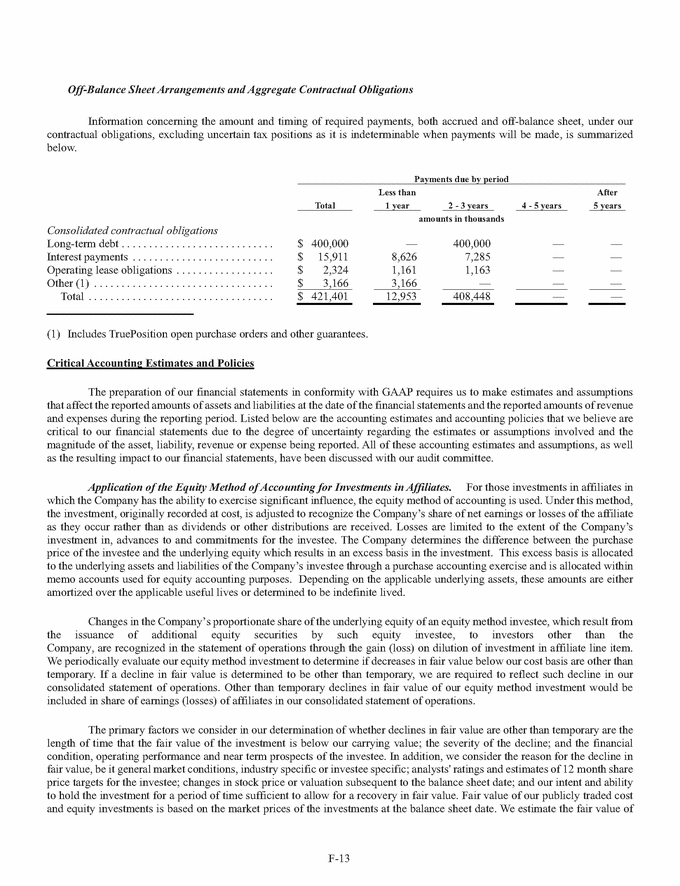
our non-public cost and equity investments using a variety of methodologies, including cash flow multiples, discounted cash flow, per subscriber values, or values of comparable public or private businesses. Impairments are calculated as the difference between our carrying value and our estimate of fair value. As our assessment of the fair value of our investments and any resulting impairment losses and the timing of when to recognize such charges requires a high degree of judgment and includes significant estimates and assumptions, actual results could differ materially from our estimates and assumptions. Our evaluation of the fair value of our investments and any resulting impairment charges are made as of the most recent balance sheet date. Changes in fair value subsequent to the balance sheet date due to the factors described above are possible. Subsequent decreases in fair value will be recognized in our consolidated statement of operations in the period in which they occur to the extent such decreases are deemed to be other than temporary. Subsequent increases in fair value will be recognized in our consolidated statement of operations only upon our ultimate disposition of the investment. Fair Value of Non-Financial Instruments. Our non-financial instrument valuations are primarily comprised of our determination of the estimated fair value allocation of net tangible and identifiable intangible assets acquired in business combinations, our annual assessment of the recoverability of our goodwill and other nonamortizable intangibles, and our evaluation of the recoverability of our other long-lived assets upon certain triggering events. The Company periodically reviews the carrying value of its intangible assets with definite lives and other long-lived assets or asset groups, including property and equipment, to be used in operations whenever events or changes in circumstances indicate that the carrying amount of the assets or asset groups might not be recoverable. Factors that would necessitate an impairment assessment include a significant adverse change in the extent or manner in which an asset is used, a significant adverse change in legal factors or the business climate that could affect the value of the asset group, or a significant decline in the observable market value of an asset group, among others. If such facts indicate a potential impairment, the recoverability of the asset group is assessed by determining whether the carrying value of the asset group exceeds the sum of the projected undiscounted cash flows expected to result from the use and eventual disposition of the asset group over the remaining economic life of the asset group. If the carrying amount of the asset group is greater than the expected undiscounted cash flows to be generated by such asset group, including its ultimate disposition, an impairment adjustment is recognized. The accounting guidance permits entities to first perform a qualitative assessment to determine whether it is more likely than not that an indefinite-lived intangible asset is impaired. If the qualitative assessment supports that it is more likely than not that the carrying value of the Company’s indefinite-lived intangible assets, other than goodwill, exceeds its fair value, then a quantitative assessment is performed. If the carrying value of our intangible or long-lived assets exceeds their estimated fair value, we are required to write the carrying value down to fair value. Any such writedown is included in impairment expense in our consolidated statement of operations. A high degree of judgment is required to estimate the fair value of our intangible and long-lived assets. We may use quoted market prices, prices for similar assets, present value techniques and other valuation techniques to prepare these estimates. We may need to make estimates of future cash flows and discount rates as well as other assumptions in order to implement these valuation techniques. Due to the high degree of judgment involved in our estimation techniques, any value ultimately derived from our intangible or long-lived assets may differ from our estimate of fair value. As each of our operating segments have intangible assets, this critical accounting policy affects the financial position and results of operations of each segment. As of December 31, 2015, the Company had $6.5 million of goodwill, attributable to the Company’s acquisition of Skyhook, primarily related to assembled workforces, non-contractual relationships and other intangibles that do not qualify for separate recognition. We perform our annual assessment of the recoverability of our goodwill in the fourth quarter each year. The Company utilizes a qualitative assessment for determining whether step one of the goodwill impairment analysis is necessary. The accounting guidance permits entities to first assess qualitative factors to determine whether it is more likely than not that the fair value of a reporting unit is less than its carrying amount as a basis for determining whether it is necessary to perform the twostep goodwill impairment test. In evaluating goodwill on a qualitative basis, the Company reviews the business performance of each reporting unit and evaluates other relevant factors as identified in the relevant accounting guidance to determine whether it is more likely than not that an indicated impairment exists for any of our reporting units. The Company considers whether there are any negative macroeconomic conditions, industry specific conditions, market changes, increased competition, increased costs
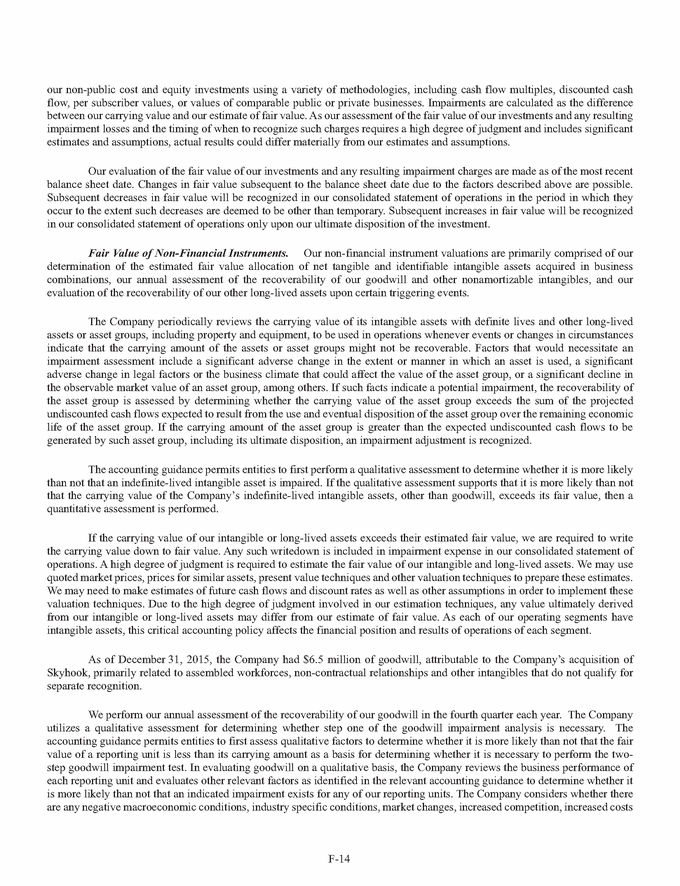
in doing business, management challenges, the legal environments and how these factors might impact company specific performance in future periods. As part of the analysis, the Company also considers fair value determinations for certain reporting units that have been made at various points throughout the current and prior year for other purposes. In mid-November 2014, Skyhook was notified that one of its significant customers, representing approximately 30-40% of its revenue, was not expected to renew its contract for 2015. Due to this anticipated decline in Skyhook's operations, the Company determined the fair value of Skyhook and performed a Step 2 impairment test, which resulted in a $35.2 million impairment loss recorded related to Skyhook’s goodwill and intangible assets during December 2014. During September 2015, TruePosition’s largest customer gave notice that it did not intend to renew its contract, which expired on December 31, 2015. The Company believed that the receipt of the notification represented a significant change in circumstances since we last performed our annual goodwill impairment test. Accordingly, we performed a goodwill impairment test upon receipt of the notification from TruePosition. At that time, the estimated fair value of the reporting unit was primarily determined based on the cash and cash equivalents held by the reporting unit, and when compared to its carrying value, it was concluded that a goodwill impairment did not exist. The carrying value of TruePosition included a $35.5 million deferred revenue liability related to the contract with the largest customer. Upon expiration of the contract on December 31, 2015, the deferred revenue was recognized, as all contractual obligations were satisfied at that time. The recognition of this deferred revenue liability increased the reporting unit carrying value. As a result, the Company determined the fair value of TruePosition. As the carrying value exceeded the fair value, we performed a Step 2 impairment test and recorded a $20.7 million impairment loss related to TruePosition’s goodwill during December 2015. Fair Value of Financial Instruments. All marketable debt and equity securities held by the Company are classified as available-for-sale (“AFS”) and are carried at fair value generally based on quoted market prices. Fair values are determined for each individual security in the investment portfolio. GAAP permits entities to choose to measure many financial instruments, such as AFS securities, and certain other items at fair value and to recognize the changes in fair value of such instruments in the entity’s statements of operations (the “Fair Value Option”). Liberty Broadband has elected the Fair Value Option for those of its AFS securities which it considers to be non-strategic (“Fair Value Option Securities”). Accordingly, changes in the fair value of Fair Value Option Securities, as determined by quoted market prices, are reported in realized and unrealized gain (losses) on financial instruments in the accompanying consolidated statements of operations. A small portion of the Company’s AFS securities are not designated as Fair Value Option Securities and are reviewed from time to time in order to determine whether a decline in fair value below the carrying value is other than temporary. The primary factors considered in this determination are the length of time that the fair value of the investment is below the carrying value, the severity of the decline, and the financial condition, operating performance and near term prospects of the investee. In addition, the Company considers the reason for the decline in fair value, be it general market conditions, industry specific or investee specific; analysts’ ratings and estimates of 12 month share price targets for the investee; changes in stock price or valuation subsequent to the balance sheet date; and the Company’s intent and ability to hold the investment for a period of time sufficient to allow for a recovery in fair value. If the decline in fair value is deemed to be other than temporary, the carrying value of the security is written down to fair value. In situations where the fair value of an investment is not evident due to a lack of public market price or other factors, the Company uses its best estimates and assumptions to arrive at the estimated fair value of such investments. The Company’s assessment of the foregoing factors involves considerable management judgment and accordingly, actual results may differ materially from the Company’s estimates and judgments. Writedowns of AFS securities would be included in the consolidated statements of operations as other than temporary declines in fair values of investments. There were no impairment charges recorded during 2015, 2014 or 2013. All of the Company’s derivatives, whether designated in hedging relationships or not, are recorded on the balance sheet at fair value. If the derivative is designated as a fair value hedge, the changes in the fair value of the derivative and of the hedged item attributable to the hedged risk are recognized in earnings. If the derivative is designated as a cash flow hedge, the effective portions of changes in the fair value of the derivative are recorded in other comprehensive earnings and are recognized in the statement of operations when the hedged item affects earnings. Ineffective portions of changes in the fair value of cash flow hedges are recognized in earnings. If the derivative is not designated as a hedge, changes in the fair value of the derivative are recognized in earnings. None of the Company’s derivatives are currently designated as hedges. The fair value of certain of the Company’s derivative instruments are estimated using the Black Scholes Merton optionpricing model (“Black-Scholes model”). The Black-Scholes model incorporates a number of variables in determining such fair values, including expected volatility of the underlying security and an appropriate discount rate. The Company obtains volatility rates from pricing services based on the expected volatility of the underlying security over the remaining term of the derivative instrument. A discount rate is obtained at the inception of the derivative instrument and updated each reporting period, based on the Company’s estimate of the discount rate at which it could currently settle the derivative instrument. The Company considered
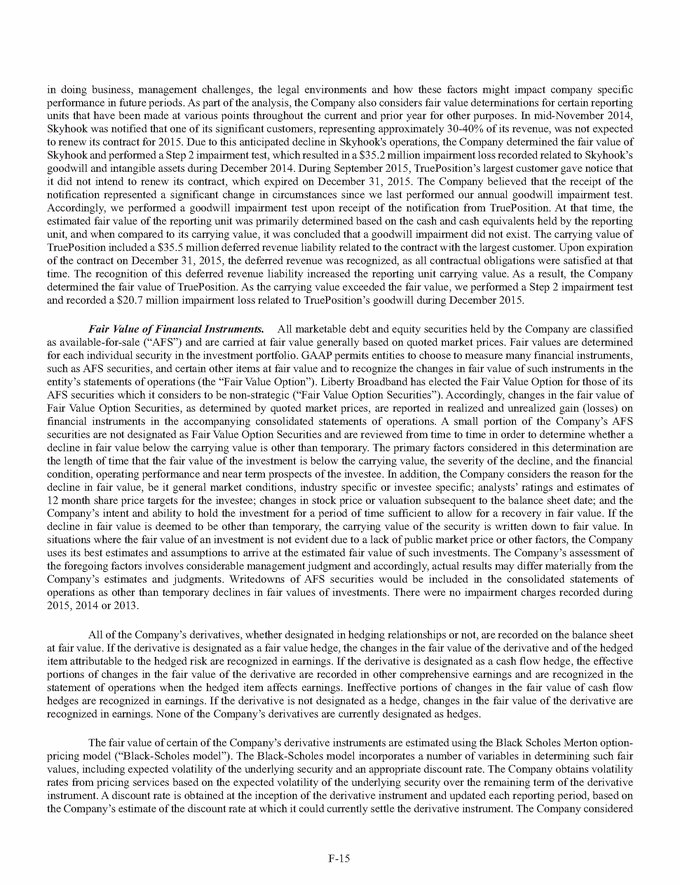
its own credit risk as well as the credit risk of its counterparties in estimating the discount rate. Management judgment is required in estimating the Black-Scholes variables. Revenue Recognition. TruePosition earns revenue from the sale of hardware and licensing of software required to generate location records for wireless phones and other wireless devices on a cellular network and from the design, installation, testing, and commissioning of such hardware and software. In addition, TruePosition earns software maintenance revenue through the provision of ongoing technical and software support. TruePosition’s tangible products contain software components and non-software components that function together to deliver the tangible products’ essential functionality. Under the applicable accounting guidance, arrangements for such products are excluded from the scope of software revenue recognition guidance and are subject to the guidance for multiple-element arrangements. Accordingly, for multiple-element arrangements entered into or materially modified on or after January 1, 2011, the overall arrangement fee is allocated to each element (both delivered and undelivered items) based on their relative selling prices, regardless of whether those selling prices are evidenced by vendor specific objective evidence (“VSOE”) or third-party evidence of selling price or are based on the entity’s estimated selling price. The associated revenue for each element is recognized upon delivery assuming all other criteria for revenue recognition are met. For arrangements which do not qualify for treatment under the guidance, TruePosition continues to account for such arrangements consistent with the outstanding guidance for software revenue recognition. Under those policies, for revenue derived from multiple-element arrangements, if VSOE exists for each of the elements of the arrangement at the outset, the Company allocates the revenue to the various elements for recognition upon delivery of each element. If not, the revenue is deferred until the earlier of establishing sufficient VSOE for allocating revenue for recognition or delivery of all of the elements. If a multiple-element arrangement includes post-contract customer support (commonly referred to as maintenance), VSOE must exist for the maintenance in order to allocate revenue to all of the elements of the arrangement. If VSOE does not exist for the maintenance, revenue for the entire arrangement is recognized ratably over the contractual or expected term of the maintenance arrangement. Direct costs related to multiple-element arrangements are deferred and recognized as the related revenue is recognized. Direct costs include installation services, hardware, and software costs. TruePosition’s multiple-element arrangement with its significant customer also contemplates usage-based transaction fees for certain commercial uses of TruePosition’s hardware and software. To date, no transaction fees have been earned. TruePosition also provides training, technical, and repair services under its multiple-element arrangements. Revenue is recognized upon delivery of the services. In May 2014, the FASB issued new accounting guidance on revenue from contracts with customers. The new guidance requires an entity to recognize the amount of revenue to which it expects to be entitled for the transfer of promised goods or services to customers. The updated guidance will replace most existing revenue recognition guidance in GAAP when it becomes effective and permits the use of either a retrospective or cumulative effect transition method. This guidance is effective for fiscal years, and interim periods within those fiscal years, beginning after December 15, 2017. The Company is currently evaluating the effect that the new standard may have on its revenue recognition and has not yet selected a transition method but does not believe the standard will significantly impact its financial statements and related disclosures. Income Taxes. We are required to estimate the amount of tax payable or refundable for the current year and the deferred income tax liabilities and assets for the future tax consequences of events that have been reflected in our financial statements or tax returns for each taxing jurisdiction in which we operate. This process requires our management to make judgments regarding the timing and probability of the ultimate tax impact of the various agreements and transactions that we enter into. Based on these judgments we may record tax reserves or adjustments to valuation allowances on deferred tax assets to reflect the expected realizability of future tax benefits. Actual income taxes could vary from these estimates due to future changes in income tax law, significant changes in the jurisdictions in which we operate, our inability to generate sufficient future taxable income or unpredicted results from the final determination of each year's liability by taxing authorities. These changes could have a significant impact on our financial position.
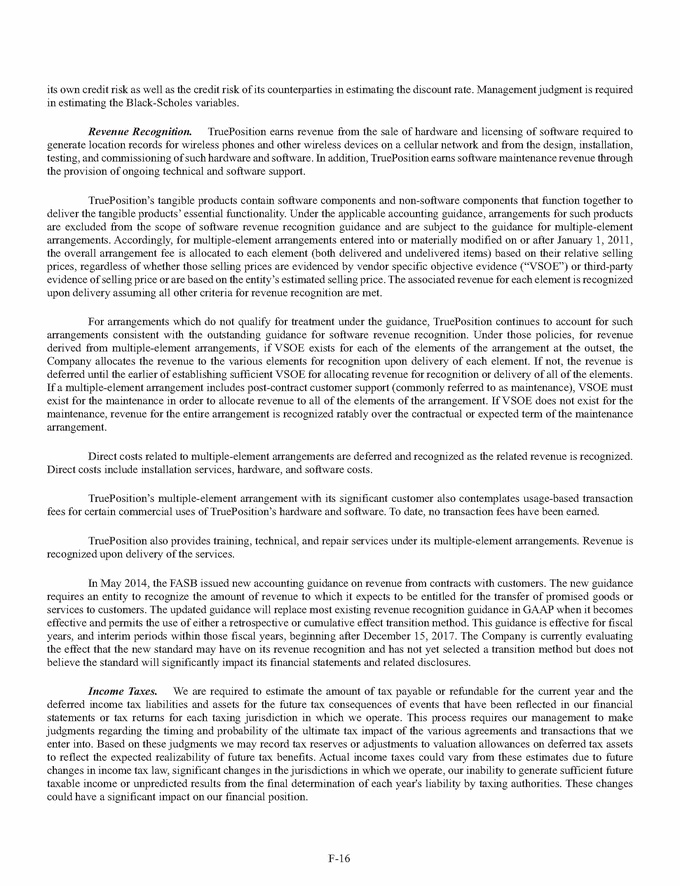
Quantitative and Qualitative Disclosures about Market Risk. We are exposed to market risk in the normal course of business due to our ongoing investing and financial activities. Market risk refers to the risk of loss arising from adverse changes in stock prices and interest rates. The risk of loss can be assessed from the perspective of adverse changes in fair values, cash flows and future earnings. We have established policies, procedures and internal processes governing our management of market risks and the use of financial instruments to manage our exposure to such risks. We are exposed to changes in interest rates primarily as a result of our borrowing and investment activities, which include investments in fixed and floating rate debt instruments and borrowings used to maintain liquidity and to fund business operations. The nature and amount of our long-term and short-term debt are expected to vary as a result of future requirements, market conditions and other factors. We manage our exposure to interest rates by maintaining what we believe is an appropriate mix of fixed and variable rate debt. We believe this best protects us from interest rate risk. We expect to achieve this mix by (i) issuing fixed rate debt that we believe has a low stated interest rate and significant term to maturity, (ii) issuing variable rate debt with appropriate maturities and interest rates and (iii) entering into interest rate swap arrangements when we deem appropriate. As of December 31, 2015, our debt is comprised of the following amounts: Variable rate debt Fixed rate debt Principal Weighted avg Principal Weighted avg amount interest rate amount interest rate dollar amounts in millions $ 400 2.2% $ — NA We are exposed to changes in stock prices primarily as a result of our significant holdings in publicly traded securities. We continually monitor changes in stock markets, in general, and changes in the stock prices of our holdings, specifically. We believe that changes in stock prices can be expected to vary as a result of general market conditions, technological changes, specific industry changes and other factors. We periodically use equity collars and other financial instruments to manage market risk associated with certain investment positions. These instruments are recorded at fair value based on option pricing models. At December 31, 2015, the fair value of our AFS equity securities was $439.6 million. Had the market price of such securities been 10% lower at December 31, 2015, the aggregate value of such securities would have been $44.0 million lower. Additionally, our stock in Charter (our equity method affiliate) is publicly traded and not reflected at fair value in our balance sheet. Our investment in Charter is also subject to market risk that is not directly reflected in our financial statements. Financial Statements and Supplementary Data. The consolidated financial statements of Liberty Broadband Corporation are included herein beginning on Page F-21. Changes in and Disagreements with Accountants on Accounting and Financial Disclosure. None. Controls a nd Procedures. In accordance with Exchange Act Rules 13a-15 and 15d-15, the Company carried out an evaluation, under the supervision and with the participation of management, including its chief executive officer and its principal accounting and financial officer (the "Executives"), of the effectiveness of its disclosure controls and procedures as of the end of the period covered by this report. Based on that evaluation, the Executives concluded that the Company's disclosure controls and procedures were effective as of December 31, 2015 to provide reasonable assurance that information required to be disclosed in its reports
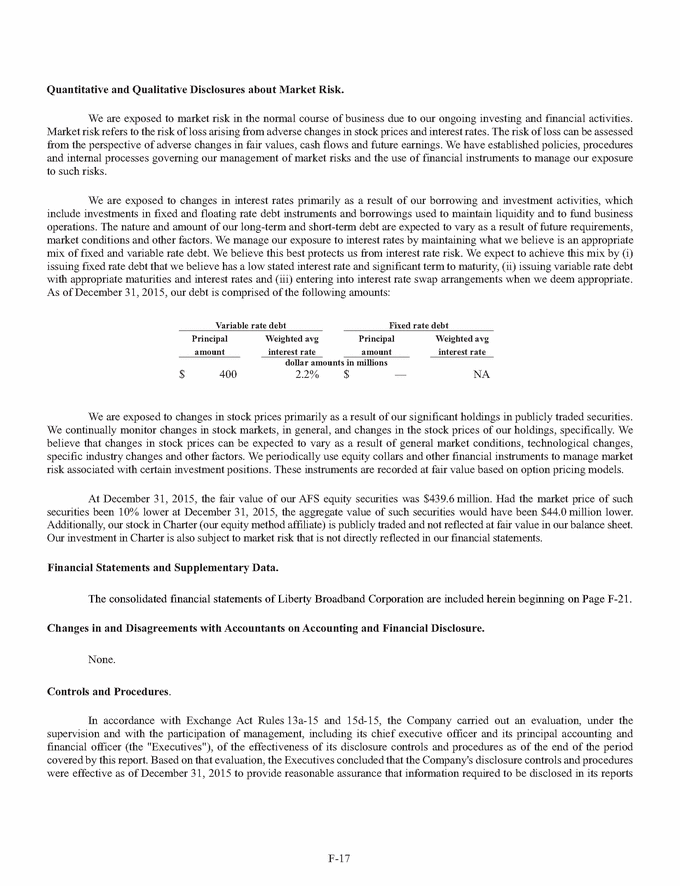
filed or submitted under the Exchange Act is recorded, processed, summarized and reported within the time periods specified in the Securities and Exchange Commission's rules and forms. See page F-19 for Management's Report on Internal Control Over Financial Reporting. See page F-20 for Report of Independent Registered Public Accounting Firm for their attestation regarding our internal control over financial reporting. There has been no change in the Company's internal control over financial reporting that occurred during the three months ended December 31, 2015 that has materially affected, or is reasonably likely to materially affect, its internal control over financial reporting. Other Information. None.
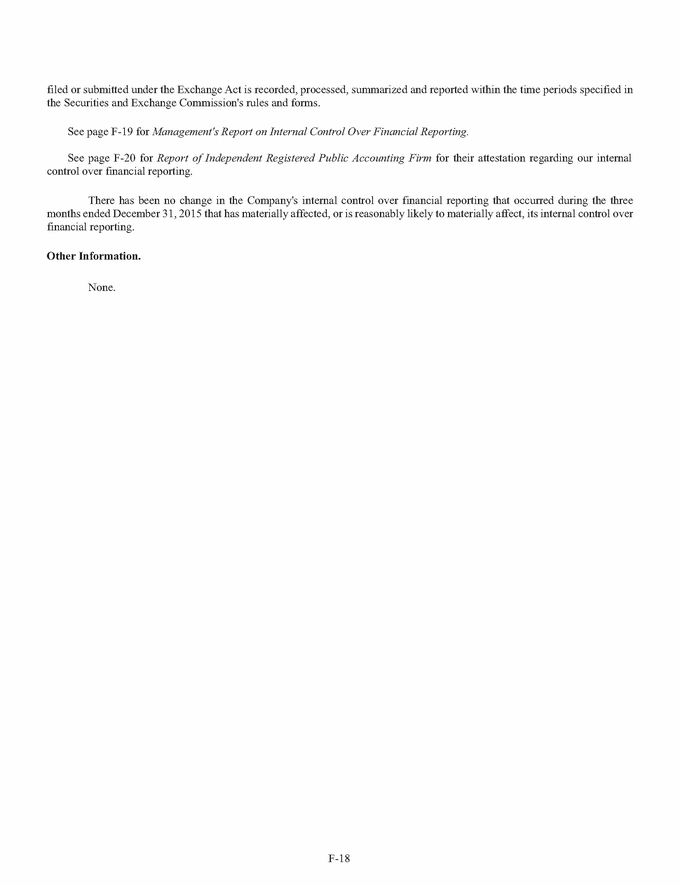
MANAGEMENT'S REPORT ON INTERNAL CONTROL OVER FINANCIAL REPORTING Liberty Broadband Corporation’s (the "Company") management is responsible for establishing and maintaining adequate internal control over the Company's financial reporting, as such term is defined in Rule 13a - 15(f) of the Securities Exchange Act of 1934. The Company's internal control over financial reporting is designed to provide reasonable assurance regarding the reliability of financial reporting and the preparation of financial statements for external purposes in accordance with accounting principles generally accepted in the United States of America. Because of inherent limitations, internal control over financial reporting may not prevent or detect misstatements. Also, projections of any evaluation of effectiveness to future periods are subject to the risk that controls may become inadequate because of changes in conditions, or that the degree of compliance with the policies and procedures may deteriorate. The Company's management assessed the effectiveness of internal control over financial reporting as of December 31, 2015, using the criteria in Internal Control-Integrated Framework (2013), issued by the Committee of Sponsoring Organizations of the Treadway Commission. Based on this evaluation the Company's management believes that, as of December 31, 2015, its internal control over financial reporting is effective. The Company's independent registered public accounting firm audited the consolidated financial statements and related disclosures in the Annual Report on Form 10-K and have issued an audit report on the effectiveness of the Company's internal control over financial reporting. This report appears on page F-20 of this Annual Report on Form 10-K.
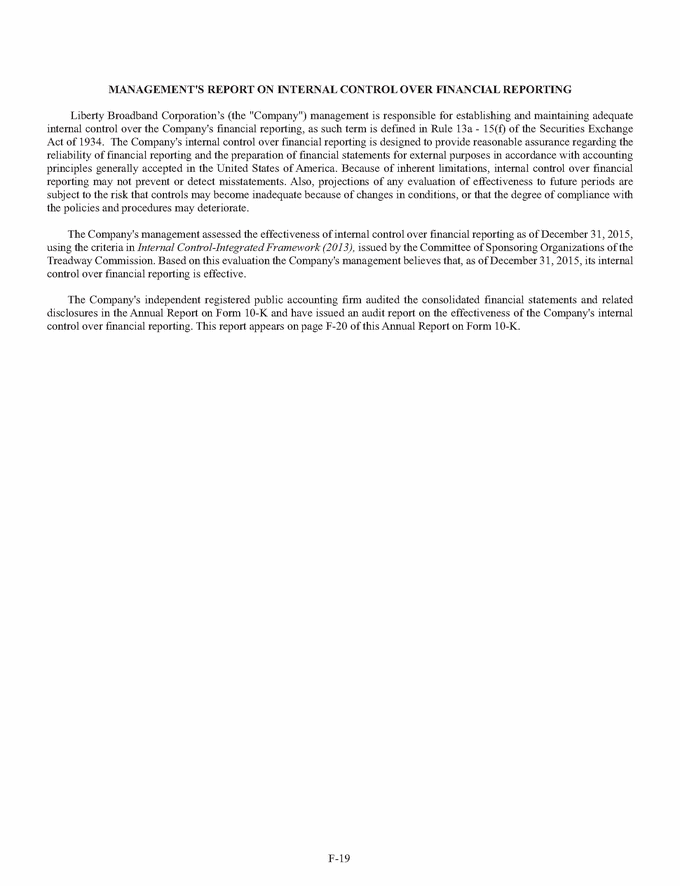
Report of Independent Registered Public Accounting Firm The Board of Directors and Stockholders Liberty Broadband Corporation: We have audited Liberty Broadband Corporation’s (the Company) internal control over financial reporting as of December 31, 2015, based on criteria established in Internal Control – Integrated Framework (2013) issued by the Committee of Sponsoring Organizations of the Treadway Commission (COSO). The Company’s management is responsible for maintaining effective internal control over financial reporting and for its assessment of the effectiveness of internal control over financial reporting, included in the accompanying Management’s Report on Internal Control Over Financial Reporting. Our responsibility is to express an opinion on the Company’s internal control over financial reporting based on our audit. We conducted our audit in accordance with the standards of the Public Company Accounting Oversight Board (United States). Those standards require that we plan and perform the audit to obtain reasonable assurance about whether effective internal control over financial reporting was maintained in all material respects. Our audit included obtaining an understanding of internal control over financial reporting, assessing the risk that a material weakness exists, and testing and evaluating the design and operating effectiveness of internal control based on the assessed risk. Our audit also included performing such other procedures as we considered necessary in the circumstances. We believe that our audit provides a reasonable basis for our opinion. A company’s internal control over financial reporting is a process designed to provide reasonable assurance regarding the reliability of financial reporting and the preparation of financial statements for external purposes in accordance with generally accepted accounting principles. A company’s internal control over financial reporting includes those policies and procedures that (1) pertain to the maintenance of records that, in reasonable detail, accurately and fairly reflect the transactions and dispositions of the assets of the company; (2) provide reasonable assurance that transactions are recorded as necessary to permit preparation of financial statements in accordance with generally accepted accounting principles, and that receipts and expenditures of the company are being made only in accordance with authorizations of management and directors of the company; and (3) provide reasonable assurance regarding prevention or timely detection of unauthorized acquisition, use, or disposition of the company’s assets that could have a material effect on the financial statements. Because of its inherent limitations, internal control over financial reporting may not prevent or detect misstatements. Also, projections of any evaluation of effectiveness to future periods are subject to the risk that controls may become inadequate because of changes in conditions, or that the degree of compliance with the policies or procedures may deteriorate. In our opinion, Liberty Broadband Corporation maintained, in all material respects, effective internal control over financial reporting as of December 31, 2015, based on criteria established in Internal Control – Integrated Framework (2013) issued by the Committee of Sponsoring Organizations of the Treadway Commission (COSO). We also have audited, in accordance with the standards of the Public Company Accounting Oversight Board (United States), the consolidated balance sheets of Liberty Broadband Corporation as of December 31, 2015 and 2014, and the related consolidated statements of operations, comprehensive earnings (loss), cash flows, and equity for each of the years in the three-year period ended December 31, 2015, and our report dated February 12, 2016 expressed an unqualified opinion on those consolidated financial statements. /s/ KPMG LLP Denver, Colorado February 12, 2016
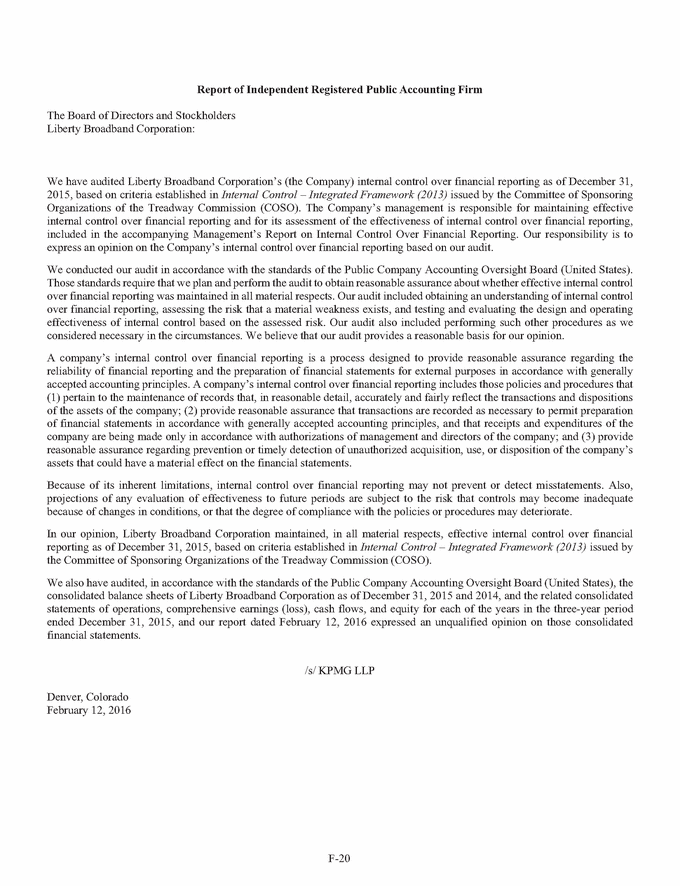
Report of Independent Registered Public Accounting Firm The Board of Directors and Stockholders Liberty Broadband Corporation: We have audited the accompanying consolidated balance sheets of Liberty Broadband Corporation (the Company) as of December 31, 2015 and 2014, and the related consolidated statements of operations, comprehensive earnings (loss), cash flows, and equity for each of the years in the three-year period ended December 31, 2015. These consolidated financial statements are the responsibility of the Company’s management. Our responsibility is to express an opinion on these consolidated financial statements based on our audits. We conducted our audits in accordance with the standards of the Public Company Accounting Oversight Board (United States). Those standards require that we plan and perform the audit to obtain reasonable assurance about whether the financial statements are free of material misstatement. An audit includes examining, on a test basis, evidence supporting the amounts and disclosures in the financial statements. An audit also includes assessing the accounting principles used and significant estimates made by management, as well as evaluating the overall financial statement presentation. We believe that our audits provide a reasonable basis for our opinion. In our opinion, the consolidated financial statements referred to above present fairly, in all material respects, the consolidated financial position of Liberty Broadband Corporation as of December 31, 2015 and 2014, and the results of their operations and their cash flows for each of the years in the three-year period ended December 31, 2015, in conformity with U.S. generally accepted accounting principles. We also have audited, in accordance with the standards of the Public Company Accounting Oversight Board (United States), the Company’s internal control over financial reporting as of December 31, 2015, based on criteria established in Internal Control – Integrated Framework (2013) issued by the Committee of Sponsoring Organizations of the Treadway Commission (COSO), and our report dated February 12, 2016, expressed an unqualified opinion on the effectiveness of the Company’s internal control over financial reporting. /s/ KPMG LLP Denver, Colorado February 12, 2016
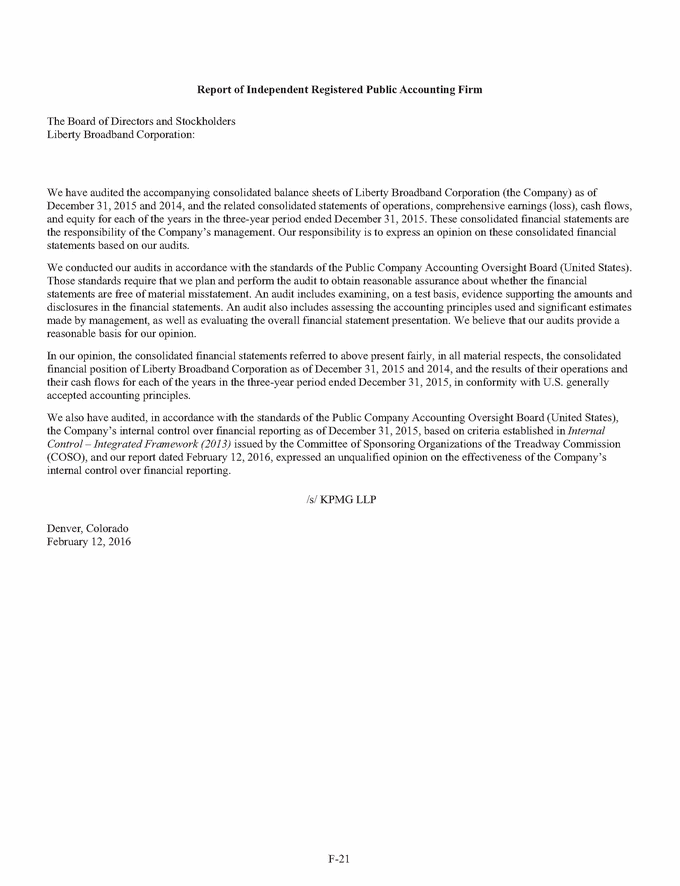
LIBERTY BROADBAND CORPORATION Consolidated Balance Sheets December 31, 2015 and 2014 2015 2014 amounts in thousands Assets Current assets: Cash and cash equivalents $ 655,079 44,809 Trade and other receivables, net of allowance for doubtful accounts of $138 thousand and $45 thousand, respectively 2,462 617 Restricted cash 32 4,082 Short-term marketable securities 9,014 9,001 Other current assets 11,660 10,639 Total current assets 678,247 69,148 Investments in available-for-sale securities (note 5) 439,560 360,762 Investments in affiliates, accounted for using the equity method (note 6) 2,372,699 2,498,804 Property and equipment, net 1,248 3,590 Goodwill (note 7) 6,497 27,166 Intangible assets subject to amortization, net (note 7) 11,887 12,915 Deferred income tax assets (note 9) 55,368 30,822 Other assets 235 264 Total assets $3,565,741 3,003,471 Liabilities and Equity Current liabilities: Accounts payable and accrued liabilities $ 10,493 15,953 Deferred revenue 2,629 5,947 Derivative instruments (note 4) — 75,356 Other current liabilities 2,254 2,340 Total current liabilities 15,376 99,596 Debt (note 8) 399,703 371,539 Deferred revenue 2,443 37,567 Total liabilities 417,522 508,702 Equity Preferred stock, $.01 par value. Authorized 50,000,000 shares; no shares issued — — Series A common stock, $.01 par value. Authorized 500,000,000 shares; issued and outstanding 26,163,206 and 26,126,459 at December 31, 2015 and 2014, respectively 262 261 Series B common stock, $.01 par value. Authorized 18,750,000 shares; issued and outstanding 2,467,547 at December 31, 2015 and 2014 25 25 Series C common stock, $.01 par value. Authorized 500,000,000 shares; issued and outstanding 74,643,546 and 57,189,897 at December 31, 2015 and 2014, respectively 746 572 Additional paid-in capital 3,537,848 2,835,373 Accumulated other comprehensive earnings, net of taxes 8,905 7,918 Retained earnings (accumulated deficit) (399,567) (349,380) Total equity 3,148,219 2,494,769 Commitments and contingencies (note 14) — — Total liabilities and equity $ 3,565,741 3,003,471 See accompanying notes to consolidated financial statements.
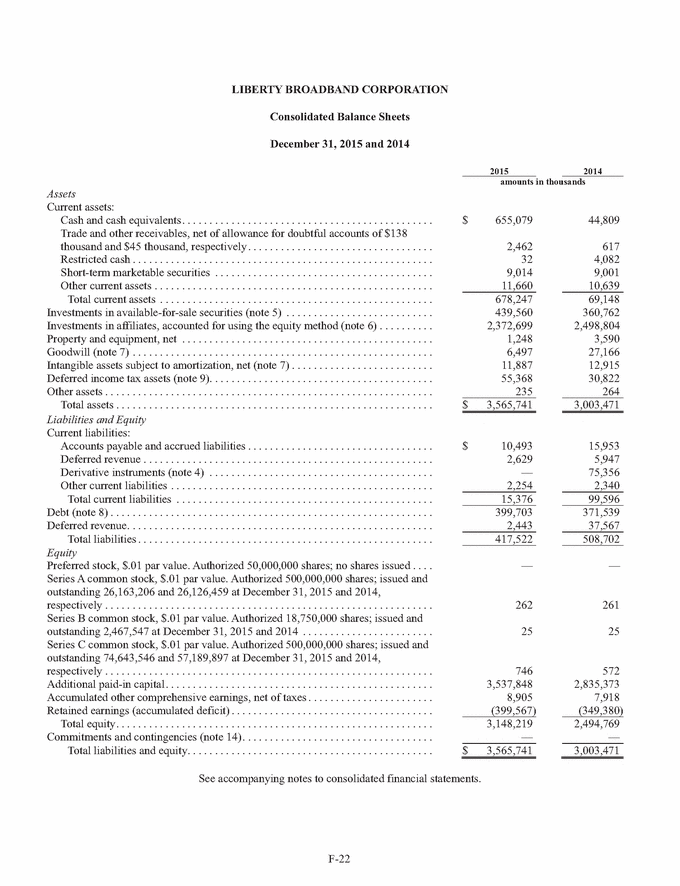
LIBERTY BROADBAND CORPORATION Consolidated Statements of Operations Years Ended December 31, 2015, 2014 and 2013 2015 2014 2013 amounts in thousands, except per share amounts Revenue: Service $ 76,139 58,426 61,264 Other 15,043 10,619 16,099 Total revenue 91,182 69,045 77,363 Operating costs and expenses Operating, including stock-based compensation (notes 3,11). 6,096 7,500 23,444 Selling, general and administrative, including stock-based compensation (notes 3,11) 42,792 47,778 34,068 Research and development, including stock-based compensation (notes 3,11) 17,032 18,477 15,557 Gain on legal settlement (60,450) (6,000) — Impairment of intangible assets (note 7) 20,669 35,221 — Depreciation and amortization 6,088 9,043 4,382 32,227 112,019 77,451 Operating income (loss) 58,955 (42,974) (88) Other income (expense): Interest Expense (7,424) (1,138) — Dividend and interest income 3,797 5,426 6,878 Share of earnings (losses) of affiliate (note 6) (120,962) (127,573) (76,090) Realized and unrealized gains (losses) on financial instruments, net (note 4) 2,619 51,189 97,860 Gain (loss) on dilution of investment in affiliate (note 6) (7,198) (87,158) (92,933) Other, net 158 (63) (53) Earnings (loss) from continuing operations before income taxes (70,055) (202,291) (64,426) Income tax benefit (expense) 19,868 67,686 22,698 Net earnings (loss) attributable to Liberty Broadband shareholders $ (50,187) (134,605) (41,728) Basic earnings (loss) from continuing operations attributable to Series A, Series B and Series C Liberty Broadband shareholders per common share (note 3) $ (0.49) (1.52) (0.47) Diluted net earnings (loss) attributable to Series A, Series B and Series C Liberty Broadband shareholders per common share (note 3) $ (0.49) (1.52) (0.47) See accompanying notes to consolidated financial statements.
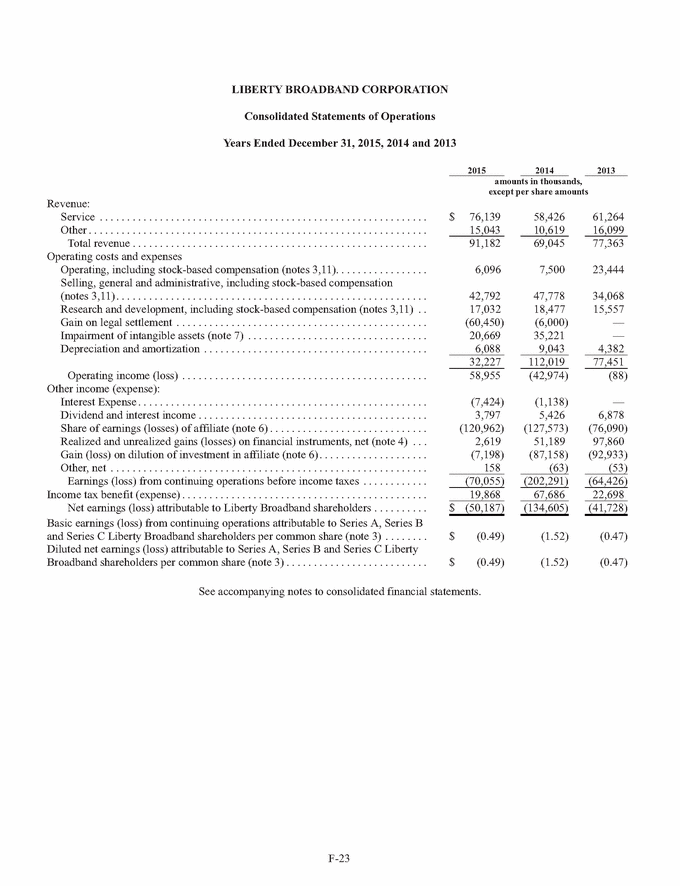
LIBERTY BROADBAND CORPORATION Consolidated Statements of Comprehensive Earnings (Loss) Years ended December 31, 2015, 2014 and 2013 2015 2014 2013 amounts in thousands Net earnings (loss) $ (50,187) (134,605) (41,728) Other comprehensive earnings (loss), net of taxes: Unrealized holding gains (losses) arising during the period (287) (3,163) 2,105 Share of other comprehensive earnings (loss) of equity affiliate 1,274 3,191 3,745 Other comprehensive earnings (loss), net of taxes 987 28 5,850 Comprehensive earnings (loss) attributable to Liberty Broadband shareholders $ (49,200) (134,577) (35,878) See accompanying notes to consolidated financial statements.
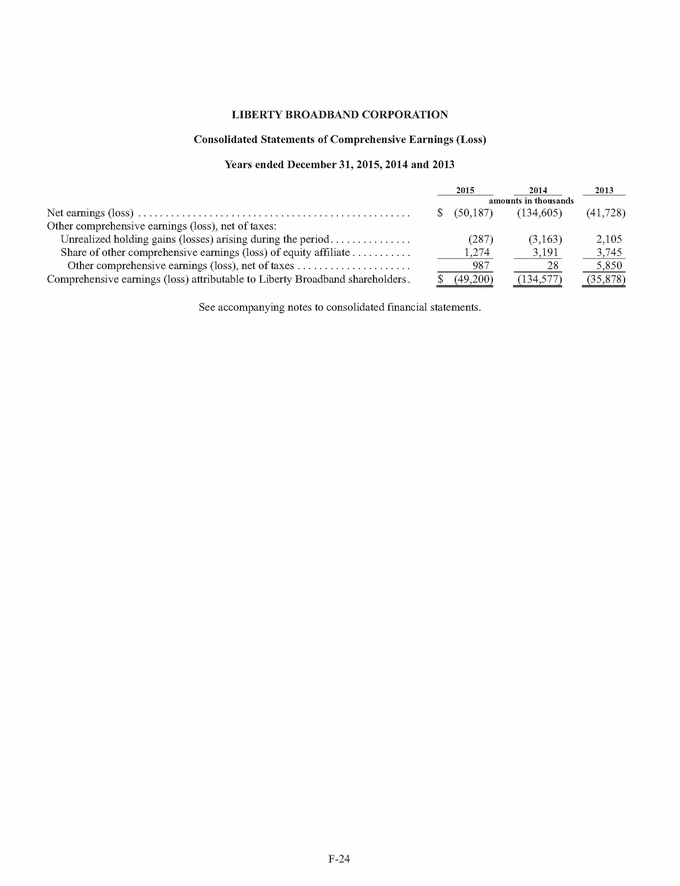
LIBERTY BROADBAND CORPORATION Consolidated Statements of Cash Flows Years ended December 31, 2015, 2014 and 2013 2015 2014 2013 amounts in thousands Cash flows from operating activities: Net earnings (loss) $ (50,187) (134,605) (41,728) Adjustments to reconcile net earnings (loss) to net cash provided by operating activities: Depreciation and amortization 6,088 9,043 4,382 Stock-based compensation 6,380 999 996 Excess tax benefit from stock-based compensation (1,217) — — Impairment of intangible assets 20,669 35,221 — Cash payments for stock-based compensation (1,268) (732) (765) Share of (earnings) losses of affiliate, net 120,962 127,573 76,090 Realized and unrealized (gains) losses on financial instruments, net .(2,619) (51,189) (97,860) (Gain) loss on dilution of investment in affiliate 7,198 87,158 92,933 Deferred income tax expense (benefit) (24,964) (66,703) (30,924) Other, net (1,440) 18 39 Changes in operating assets and liabilities: Current and other assets (1,238) 446 7,729 Payables and other liabilities (44,292) (4,501) (5,417) Net cash provided by operating activities 34,072 2,728 5,475 Cash flows from investing activities: Capital expended for property and equipment (731) (1,398) (1,127) Cash paid for acquisitions, net of cash acquired — (48,088) — Proceeds (payments) from issuances and settlements of financial instruments, net — — (59,612) Investments in equity investees — (175,857) (2,565,150) Amounts loaned to former parent — (55,646) (58,344) Repayments by former parent on loan receivable — 80,012 59,373 Purchases of short term investments and other marketable securities .(18,032) (9,001) — Sales of short term investments and other marketable securities 18,019 — — Other investing activities, net (1,735) (8) (8) Net cash used in investing activities (2,479) (209,986) (2,624,868) Cash flows from financing activities: Cash received from rights offering 697,309 — — Borrowings of debt 67,995 372,000 — Repayments of debt (40,000) — — Contribution from (distribution to) former parent, ne — (129,184) 2,618,613 Proceeds from issuances of financial instruments 30,158 130,237 63,547 Payments from settlements of financial instruments (182,192) (130,237) (63,547) Excess tax benefit from stock-based compensation 1,217 — — Other financing activities, net 4,190 — — Net cash provided by (used in) financing activities 578,677 242,816 2,618,613 Net increase (decrease) in cash 610,270 35,558 (780) Cash and cash equivalents, beginning of year 44,809 9,251 10,031 Cash and cash equivalents, end of year $ 655,079 44,809 9,251 Supplemental disclosure to the consolidated statements of cash flows: Years ended December 31, 2015 2014 2013 amounts in thousands Cash paid for interest $ 7,251 1,078 — Cash paid for taxes $ 5,485 2,870 16,577 See accompanying notes to consolidated financial statements.
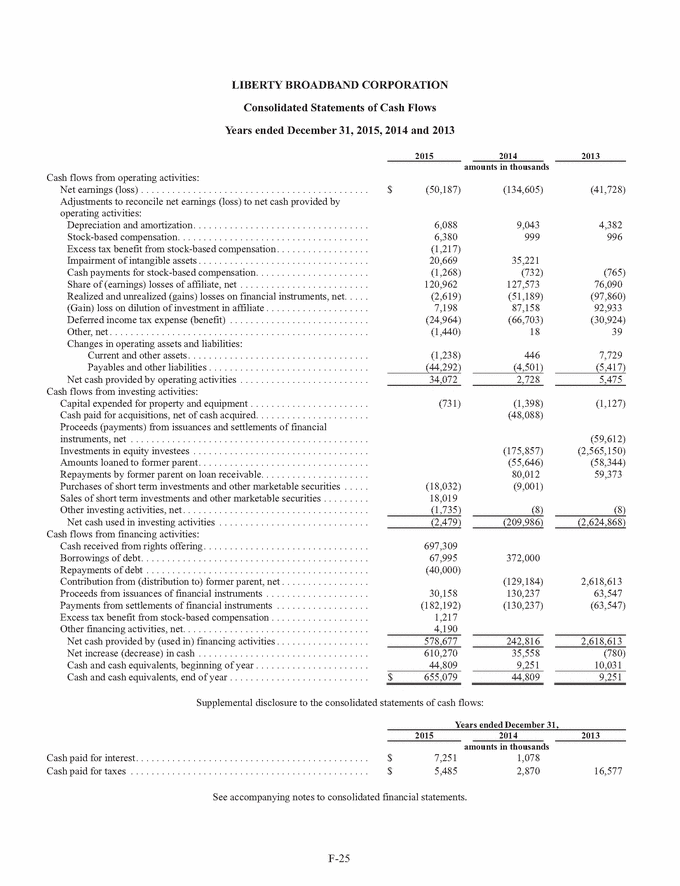
LIBERTY BROADBAND CORPORATION Consolidated Statement of Equity Years ended December 31, 2015, 2014 and 2013 Accumulated Retained Additional other earnings Preferred Common stock paid-in Parent’s comprehensive (accumulated Total Stock Series A Series B Series C capital investment earnings deficit) equity amounts in thousands Balance at January 1, 2013 $ — — — — — 367,466 2,040 (173,047) 196,459 Net earnings (loss) — — — — — — — (41,728) (41,728) Other comprehensive earnings (loss) — — — — — — 5,850 — 5,850 Contribution from (distribution to) former parent. — — — — — 2,618,613 — — 2,618,613 Balance at December 31, 2013. — — — — — 2,986,079 7,890 (214,775) 2,779,194 Net earnings (loss) — — — — — — — (134,605) (134,605) Other comprehensive earnings (loss) — — — — — — 28 — 28 Stock-based compensation — — — — 422 — — — 422 Change in capitalization in connection with Broadband Spin-Off — 261 25 572 3,155,537 (3,156,395) — — — Contribution from (distribution to) former parent — — — — (299,500) 170,316 — — (129,184) Tax attributes in connection with Broadband Spin-Off — — — — (21,086) — — — (21,086) Balance at December 31, 2014 — 261 25 572 2,835,373 — 7,918 (349,380) 2,494,769 Net earnings (loss) — — — — — — — (50,187) (50,187) Other comprehensive earnings (loss) — — — — — — 987 — 987 Stock-based compensation — — — — 5,200 — — — 5,200 Issuance of common stock upon exercise of stock options — 1 — 1 138 — — — 140 Excess tax benefits from stock-based compensation — — — — 1,217 — — — 1,217 Common stock issued pursuant to the rights offering — — — 173 697,136 — — — 697,309 Other — — — — (1,216) — — — (1,216) Balance at December 31, 2015 $ — 262 25 746 3,537,848 — 8,905 (399,567) 3,148,219 See accompanying notes to consolidated financial statements.
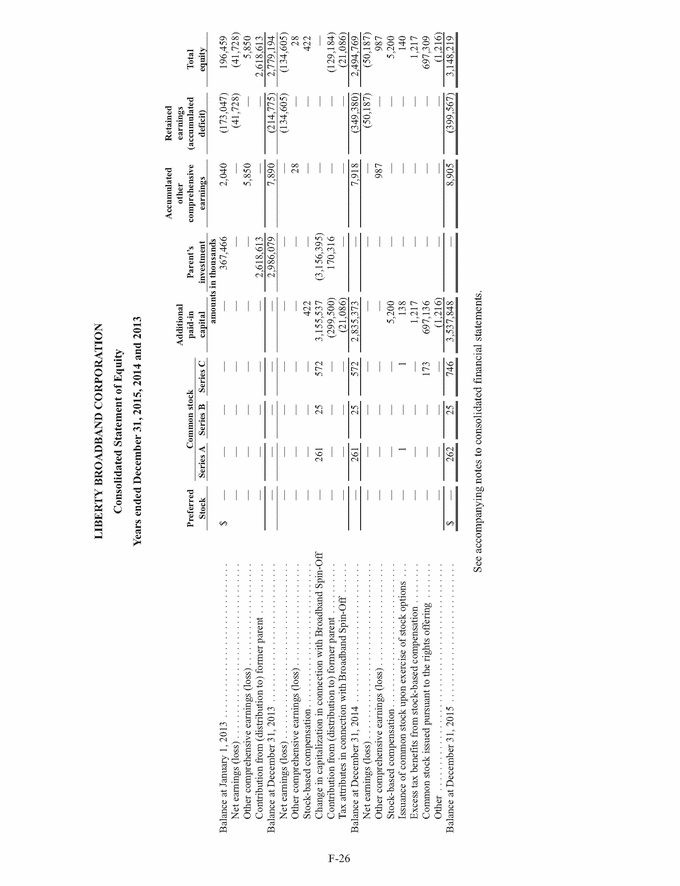
LIBERTY BROADBAND CORPORATION Notes to Consolidated Financial Statements December 31, 2015, 2014 and 2013 (1) Basis of Presentation During May 2014, the board of directors of Liberty Media Corporation and its subsidiaries (“Liberty”) authorized management to pursue a plan to spin-off to its stockholders common stock of a wholly-owned subsidiary, Liberty Broadband Corporation (“Liberty Broadband”), and to distribute subscription rights to acquire shares of Liberty Broadband’s common stock (the “Broadband Spin-Off”). At 5:00 p.m., New York City time, on November 4, 2014 the Broadband Spin-Off was completed and shares of Liberty Broadband common stock were distributed to the shareholders of Liberty as of a record date of 5:00 p.m., New York City time, on October 29, 2014. Liberty Broadband is comprised of, among other things, (i) Liberty’s former interest in Charter Communications, Inc. (“Charter”), (ii) Liberty’s former wholly-owned subsidiary TruePosition, Inc. (“TruePosition”), (iii) Liberty’s former minority equity investment in Time Warner Cable, Inc. (“Time Warner Cable”), (iv) certain deferred tax liabilities, as well as liabilities related to the Time Warner Cable written call options and (v) initial indebtedness, pursuant to margin loans entered into prior to the completion of the Broadband Spin-Off. These financial statements refer to the combination of the aforementioned subsidiary, investments, and financial instruments, as “Liberty Broadband,” “the Company,” “us,” “we” and “our” in the notes to the consolidated financial statements. The Broadband Spin-Off was accounted for at historical cost due to the pro rata nature of the distribution to holders of Liberty common stock. In the Broadband Spin-Off, record holders of Liberty Series A, Series B and Series C common stock received one-fourth of a share of the corresponding series of Liberty Broadband common stock for each share of Liberty common stock held by them as of 5:00 p.m., New York City time, on October 29, 2014 (the record date), with cash paid in lieu of fractional shares. In addition, following the completion of the Broadband Spin-Off, on December 10, 2014, stockholders received a subscription right to acquire one share of Series C Liberty Broadband common stock for every five shares of Liberty Broadband common stock they held as of 5:00 p.m., New York City time, on December 4, 2014 (the rights record date). See note 10 for additional information related to the rights offering. Following the Broadband Spin-Off, Liberty and Liberty Broadband operate as separate, publicly traded companies, and neither has any stock ownership, beneficial or otherwise, in the other. In connection with the Broadband Spin-Off, Liberty and Liberty Broadband entered into certain agreements in order to govern certain of the ongoing relationships between the two companies after the Broadband Spin-Off and to provide for an orderly transition. These agreements include a reorganization agreement, a services agreement, a facilities sharing agreement and a tax sharing agreement. The reorganization agreement provides for, among other things, the principal corporate transactions (including the internal restructuring) required to effect the Broadband Spin-Off, certain conditions to the Broadband Spin-Off and provisions governing the relationship between Liberty Broadband and Liberty with respect to and resulting from the Broadband Spin-Off. The tax sharing agreement provides for the allocation and indemnification of tax liabilities and benefits between Liberty and Liberty Broadband and other agreements related to tax matters. Pursuant to the tax sharing agreement, Liberty Broadband has agreed to indemnify Liberty, subject to certain limited exceptions, for losses and taxes resulting from the Broadband Spin-Off to the extent such losses or taxes result primarily from, individually or in the aggregate, the breach of certain restrictive covenants made by Liberty Broadband (applicable to actions or failures to act by Liberty Broadband and its subsidiaries following the completion of the Broadband Spin-Off). Pursuant to the services agreement, Liberty provides Liberty Broadband with general and administrative services including legal, tax, accounting, treasury and investor relations support. Under the facilities sharing agreement, Liberty Broadband shares office space with Liberty and related amenities at Liberty’s corporate headquarters. Liberty Broadband will reimburse Liberty for direct, out-of-pocket expenses incurred by Liberty in providing these services which will be negotiated semi-annually. Under these various agreements, approximately $2.5 million was reimbursable to Liberty for the year ended December 31, 2015. The accompanying consolidated financial statements have been prepared in accordance with generally accepted accounting principles in the United States (“GAAP”) and represent a combination of the historical financial information of
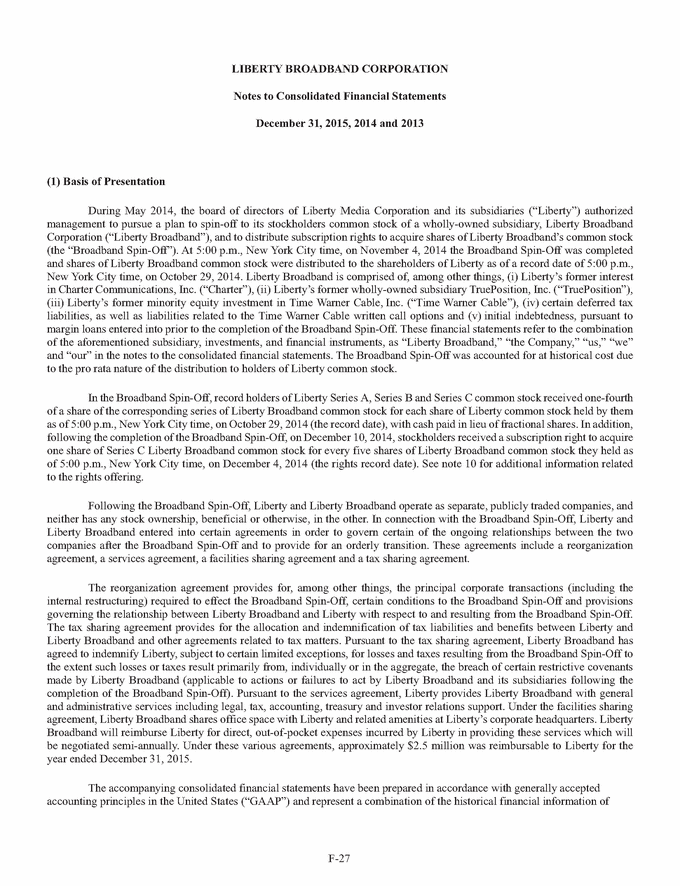
LIBERTY BROADBAND CORPORATION Notes to Consolidated Financial Statements (Continued) December 31, 2015, 2014 and 2013 TruePosition, the Company’s interest in Charter, the Company’s minority equity investment in Time Warner Cable and certain deferred tax liabilities, as well as liabilities related to the Time Warner Cable call option. All significant intercompany accounts and transactions have been eliminated in the consolidated financial statements. (2) Description of Business TruePosition develops and markets technology for locating wireless phones and other wireless devices on a cellular network, enabling wireless carriers and government agencies to provide public safety E-9-1-1 services domestically and services in support of commercial applications, national security and law enforcement worldwide. Since 2012, TruePosition has been largely dependent on one wireless carrier (AT&T), which accounted for approximately 80% - 90% of TruePosition’s overall revenue. During September 2015, AT&T gave notice that it did not intend to renew its contract, which expired on December 31, 2015. The Company believed that the receipt of the notification represented a significant change in circumstances since we last performed our annual goodwill impairment test. Accordingly, we performed a goodwill impairment test upon receipt of the notification from TruePosition. At that time, the estimated fair value of the reporting unit was primarily determined based on the cash and cash equivalents held by the reporting unit, and when compared to its carrying value, it was concluded that a goodwill impairment did not exist. The carrying value of TruePosition included a $35.5 million deferred revenue liability related to the contract with AT&T. Upon expiration of the contract on December 31, 2015, the deferred revenue was recognized, as all contractual obligations were satisfied at that time. The recognition of this deferred revenue liability increased the reporting unit carrying value. As a result, the Company determined the fair value of TruePosition. As the reporting unit’s carrying value exceeded the fair value, we performed a Step 2 impairment test and recorded a $20.7 million impairment loss related to TruePosition’s goodwill during December 2015. See note 7 for additional discussion regarding this impairment loss. On February 14, 2014, TruePosition acquired 100% of the outstanding common shares of Skyhook Wireless, Inc. (“Skyhook”), a Delaware corporation, for approximately $57.5 million in cash. Skyhook is a provider of hybrid wireless positioning technology and contextual location intelligence. Acquisition related costs of $958 thousand and $624 thousand are included in selling, general and administrative expenses for the years ending December 31, 2014 and 2013, respectively. TruePosition used its cash plus a capital contribution of $49.4 million from Liberty during 2014 to fund the acquisition. Upon the acquisition of Skyhook, TruePosition placed $6.0 million of the cash consideration into an escrow account for use to settle any indemnification claims made by TruePosition during the 12 months subsequent to closing the acquisition. There were no claims made against the escrow account, and the full amount was released to the selling parties during February 2015. The purchase price allocation resulted in the following (amounts in thousands): Cash and cash equivalents $ 9,442 Goodwill. 24,931 Amortizable intangible assets 35,598 Other assets 1,353 Accounts payable and accrued liabilities (6,905) Deferred revenue (5,000) Deferred taxes (1,889) $ 57,530 Amortizable intangible assets acquired include patents, tradenames, customer relationships, and capitalized software. The fair value of these assets was determined using projected cash flows based on Level 3 inputs. The remaining useful life of patents, tradenames and customer relationships was determined to be five years. The remaining useful life of capitalized software was determined to be three to five years. Accordingly, the amortizable intangible assets acquired were amortized straight-line over these respective periods. In connection with the intangible impairment recorded on Skyhook’s intangible assets during the fourth quarter of 2014 (discussed below), TruePosition re-evaluated the remaining useful lives of Skyhook’s amortizable intangible assets. As a result, as of January 1, 2015, TruePosition determined the remaining useful life of Skyhook’s patents to be
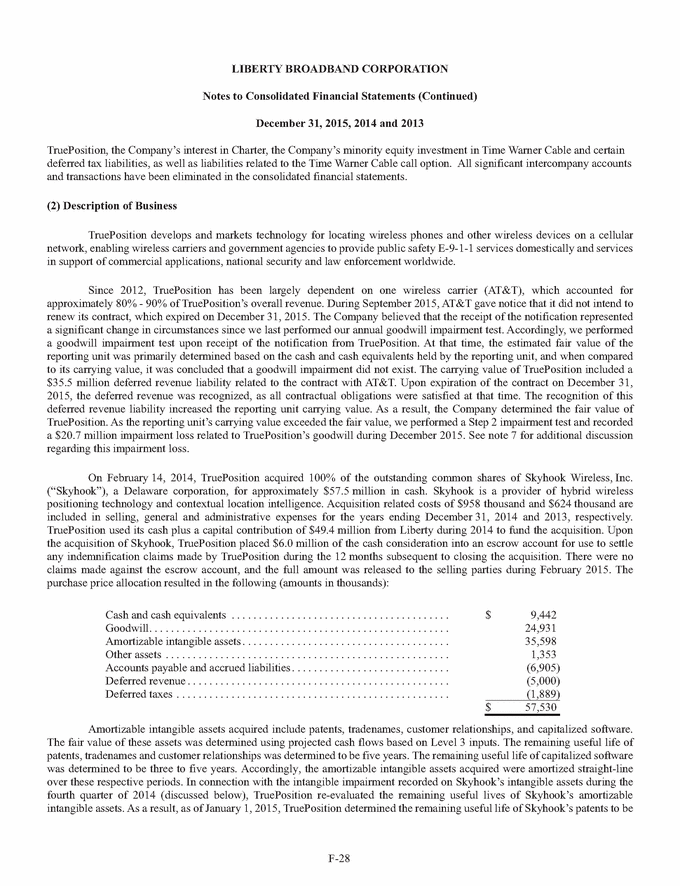
LIBERTY BROADBAND CORPORATION Notes to Consolidated Financial Statements (Continued) December 31, 2015, 2014 and 2013 three and a half years and Skyhook’s tradename and customer relationship to be five and a half years. On January 1, 2015, TruePosition began amortizing Skyhook’s intangible assets straight-line prospectively over these revised periods. Capitalized software intangible assets continue to be amortized over three to five years. Goodwill is calculated as the excess of the consideration transferred over the identifiable net assets acquired and represents the future economic benefits expected to arise from other intangible assets acquired that do not qualify for separate recognition, including assembled workforce and noncontractual relationships. Assuming the Skyhook transaction took place on January 1, 2013, the Company’s revenue would have been approximately $85.9 million, the operating loss would have been $11.7 million and the net loss would have been $48.7 million on a pro forma basis for the year ended December 31, 2013. The previous amounts were determined using historical results of Liberty Broadband and Skyhook, including purchase accounting amortization. Such amounts are not indicative of what actual amounts might have been had the transaction occurred as of that date. In mid-November 2014, Skyhook was notified that one of its significant customers was not expected to renew its contract for 2015. As a result, approximately 30-40% of Skyhook's revenue was not expected to recur during 2015. Due to this anticipated decline in Skyhook's operations, the Company determined the fair value of Skyhook and performed a Step 2 impairment test, which resulted in a $35.2 million impairment loss recorded to TruePosition’s goodwill and intangible assets related to Skyhook during December 2014. See note 7 for additional discussion regarding this impairment loss. Charter is a cable operator that provides services in the United States. Charter offers to residential and commercial customers traditional cable video programming, Internet services, and voice services, as well as advanced video services such as Charter OnDemandTM, high definition television, and digital video recorder (“DVR”) service. Charter sells its cable video programming, Internet, voice, and advanced video services primarily on a subscription basis. Charter also sells local advertising on cable networks and on the Internet and provides fiber connectivity to cellular towers and office buildings. Liberty acquired its interest in Charter on May 1, 2013. At December 31, 2015, Liberty Broadband owned approximately 28.8 million shares of Charter common stock, which represents an approximate 26% ownership interest in Charter’s issued and outstanding shares as of December 31, 2015. Under Liberty’s stockholders agreement with Charter, Liberty had the right to nominate four directors to the Charter board of directors, subject to certain exclusions and requirements. Liberty also had the right to cause one of its nominees to serve on the nominating and corporate governance, audit and compensation and benefits committees of the board, provided they meet the independence and other qualifications for membership on those committees. These rights were transferred to Liberty Broadband in connection with the Broadband Spin-Off. In connection with the proposed Bright House Transaction and Time Warner Cable Merger (each as defined in note 6), on May 23, 2015, we entered into an Amended and Restated Stockholders Agreement (the “Second Amended and Restated Stockholders Agreement”) with Charter, New Charter and Advance/Newhouse Partnership (“A/N”), which continues to provide us with board nomination rights, among other rights. Also included in Liberty Broadband is an investment in outstanding shares of Time Warner Cable, which is classified as available-for-sale and is carried at fair value based on quoted market prices. Additionally, the Company historically had written call options and a cashless collar agreement on Time Warner Cable shares. See note 5 for information regarding the Company’s investment in Time Warner Cable. See note 4 for information regarding the Time Warner Cable written call options and cashless collar agreement. (3) Summary of Significant Accounting Policies Cash and Cash Equivalents Cash consists of cash deposits held in global financial institutions. Cash equivalents consist of highly liquid investments with maturities of three months or less at the time of acquisition. Cash that has restrictions upon its usage has been excluded from cash and cash equivalents. Restricted cash comprises bank deposits securing a line of credit (note 8). Restricted cash was $32 thousand and $4.0 million at December 31, 2015 and 2014, respectively.
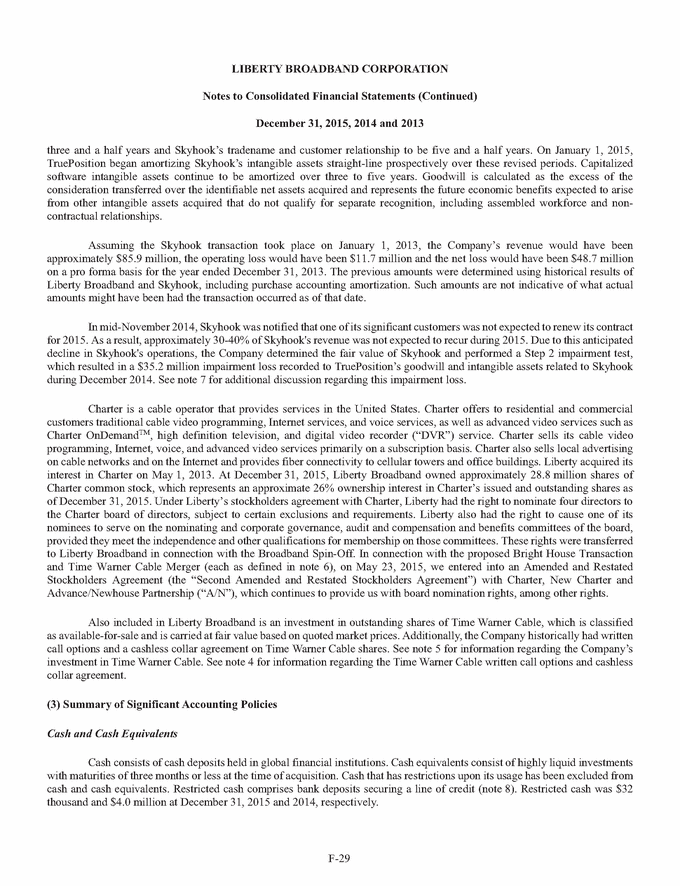
LIBERTY BROADBAND CORPORATION Notes to Consolidated Financial Statements (Continued) December 31, 2015, 2014 and 2013 Accounts Receivable and Allowance for Doubtful Accounts Accounts receivable are recorded at the invoiced amount and reduced by an allowance for doubtful accounts. For accounts outstanding longer than the contractual payment terms, the Company determines an allowance by considering a number of factors, including the length of time trade accounts receivable are past due, previous loss history, a specific customer’s ability to pay its obligations to us, and current economic conditions. Derivative Instruments and Hedging Activities All of the Company’s derivatives, whether designated in hedging relationships or not, are recorded on the balance sheet at fair value. If the derivative is designated as a fair value hedge, the changes in the fair value of the derivative and of the hedged item attributable to the hedged risk are recognized in earnings. If the derivative is designated as a cash flow hedge, the effective portions of changes in the fair value of the derivative are recorded in other comprehensive earnings and are recognized in the statement of operations when the hedged item affects earnings. Ineffective portions of changes in the fair value of cash flow hedges are recognized in earnings. If the derivative is not designated as a hedge, changes in the fair value of the derivative are recognized in earnings. None of the Company’s derivatives are currently designated as hedges. The fair value of certain of the Company’s derivative instruments are estimated using the Black Scholes Merton optionpricing model (“Black-Scholes model”). The Black-Scholes model incorporates a number of variables in determining such fair values, including expected volatility of the underlying security and an appropriate discount rate. The Company obtained volatility rates from pricing services based on the expected volatility of the underlying security over the remaining term of the derivative instrument. A discount rate was obtained at the inception of the derivative instrument and updated each reporting period, based on the Company’s estimate of the discount rate at which it could currently settle the derivative instrument. The Company considered its own credit risk as well as the credit risk of its counterparties in estimating the discount rate. Management judgment was required in estimating the Black-Scholes variables. See note 4 for further discussion of fair value of the Company’s derivative instruments. Property and Equipment Property and equipment consists of the following (amounts in thousands): December 31, 2015 2014 Support equipment. $ 21,769 34,526 Computer equipment 2,257 3,382 Furniture & fixtures 2,025 2,006 26,051 39,914 Accumulated depreciation. (24,803) (36,324) $ 1,248 3,590 Property and equipment is recorded at cost, net of accumulated depreciation. Depreciation is computed using the straight-line method over the estimated useful lives of the assets, which is three years for computer equipment and five years for support equipment and furniture and fixtures. Investments All marketable debt and equity securities held by the Company are classified as available-for-sale (“AFS”) and are carried at fair value generally based on quoted market prices. Fair values are determined for each individual security in the
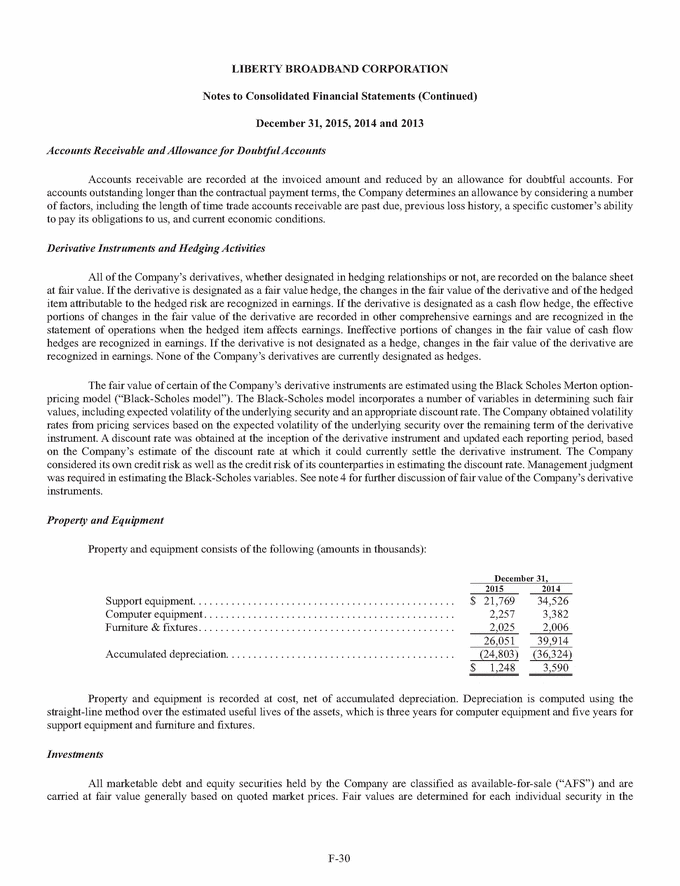
LIBERTY BROADBAND CORPORATION Notes to Consolidated Financial Statements (Continued) December 31, 2015, 2014 and 2013 investment portfolio. Unrealized gains and losses, net of taxes, arising from changes in fair value are reported in accumulated other comprehensive income (loss) as a component of shareholders’ equity. GAAP permits entities to choose to measure many financial instruments, such as AFS securities, and certain other items at fair value and to recognize the changes in fair value of such instruments in the entity’s statements of operations (the “Fair Value Option”). Liberty Broadband has elected the fair value option for those of its AFS securities which it considers to be non-strategic (“Fair Value Option Securities”). Accordingly, changes in the fair value of Fair Value Option Securities, as determined by quoted market prices, are reported in realized and unrealized gain (losses) on financial instruments in the accompanying consolidated statements of operations. The total value of AFS securities for which the Company has elected the fair value option aggregated $438.9 million and $359.6 million as of December 31, 2015 and 2014, respectively. The Company continually reviews its AFS securities not designated as Fair Value Option Securities to determine whether a decline in fair value below the carrying value is other than temporary. The primary factors considered in this determination are the length of time that the fair value of the investment is below the carrying value, the severity of the decline, and the financial condition, operating performance and near term prospects of the investee. In addition, the Company considers the reason for the decline in fair value, be it general market conditions, industry specific or investee specific; analysts’ ratings and estimates of 12 month share price targets for the investee; changes in stock price or valuation subsequent to the balance sheet date; and the Company’s intent and ability to hold the investment for a period of time sufficient to allow for a recovery in fair value. If the decline in fair value is deemed to be other than temporary, the carrying value of the security is written down to fair value. In situations where the fair value of an investment is not evident due to a lack of public market price or other factors, the Company uses its best estimates and assumptions to arrive at the estimated fair value of such investments. The Company’s assessment of the foregoing factors involves considerable management judgment and accordingly, actual results may differ materially from the Company’s estimates and judgments. Writedowns of AFS securities would be included in the consolidated statements of operations as other than temporary declines in fair values of investments. There were no impairment charges recorded during 2015, 2014 or 2013. For those investments in affiliates in which the Company has the ability to exercise significant influence, the equity method of accounting is used. Under this method, the investment, originally recorded at cost, is adjusted to recognize the Company’s share of net earnings or losses of the affiliate as they occur rather than as dividends or other distributions are received. Losses are limited to the extent of the Company’s investment in, advances to and commitments for the investee. The Company determines the difference between the purchase price of the investee and the underlying equity which results in an excess basis in the investment. This excess basis is allocated to the underlying assets and liabilities of the Company’s investee through a purchase accounting exercise and is allocated within memo accounts used for equity accounting purposes. Depending on the applicable underlying assets, these amounts are either amortized over the applicable useful lives or determined to be indefinite lived. We periodically evaluate our equity method investment to determine if decreases in fair value below our cost basis are other than temporary. If a decline in fair value is determined to be other than temporary, we are required to reflect such decline in our consolidated statement of operations. Other than temporary declines in fair value of our equity method investment would be included in share of earnings (losses) of affiliate in our consolidated statement of operations. Changes in the Company’s proportionate share of the underlying equity of an equity method investee, which result from the issuance of additional equity securities by such equity investee, are recognized in the statement of operations through the gain (loss) on dilution of investment in affiliate line item. As Liberty Broadband does not control the decision making process or business management practices of our affiliate accounted for using the equity method, Liberty Broadband relies on management of its affiliate to provide it with accurate financial information prepared in accordance with GAAP that the Company uses in the application of the equity method. In addition, Liberty Broadband relies on the audit reports that are provided by the affiliate’s independent auditors on the financial statements of such affiliates. The Company is not aware, however, of any errors in or possible misstatements of the financial information provided by its equity affiliate that would have a material effect on Liberty Broadband’s consolidated financial statements.
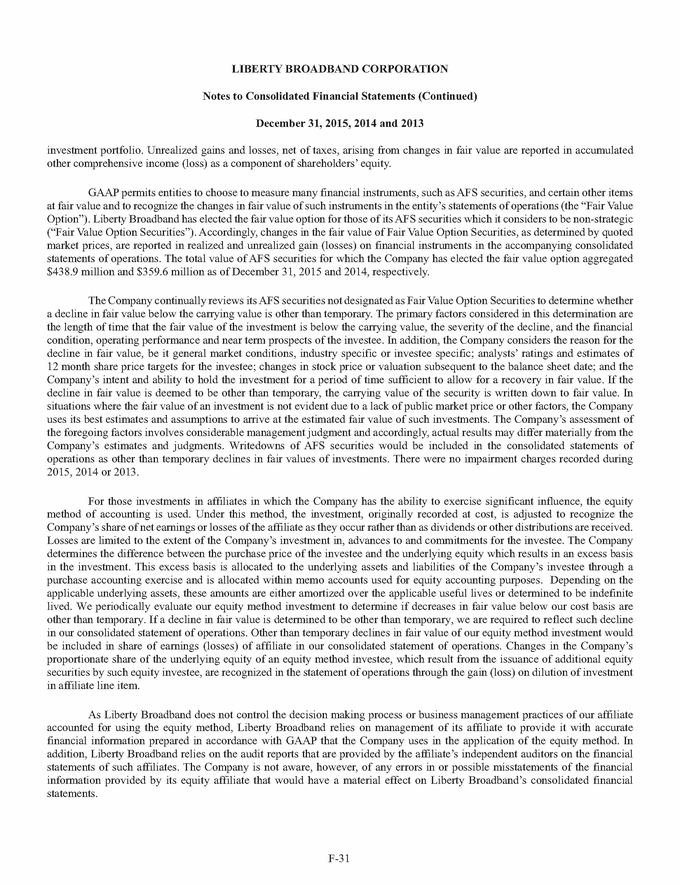
LIBERTY BROADBAND CORPORATION Notes to Consolidated Financial Statements (Continued) December 31, 2015, 2014 and 2013 Leases The Company, through its consolidated entities, leases facilities and certain equipment under cancelable and noncancelable lease agreements. The terms of some of the lease agreements provide for rental payments on a graduated basis. Rent expense is recognized on a straight-line basis over the lease period and accrued as rent expense incurred but not paid. The lease term begins on the date we become legally obligated for the rent payments or when we take possession of the office space, whichever is earlier. Goodwill and Other Intangible Assets The Company performs at least annually an assessment of the recoverability of goodwill and other indefinite-lived intangible assets during the fourth quarter of each year. The Company utilizes a qualitative assessment for determining whether the quantitative impairment analysis is necessary. The accounting guidance permits entities to first assess qualitative factors to determine whether it is more likely than not that the fair value of a reporting unit is less than its carrying amount as a basis for determining whether it is necessary to perform the two-step impairment test. In evaluating goodwill on a qualitative basis, the Company reviews the business performance of each reporting unit and evaluates other relevant factors as identified in the relevant accounting guidance to determine whether it was more likely than not that an indicated impairment exists for any of our reporting units. The Company considers whether there are any negative macroeconomic conditions, industry specific conditions, market changes, increased competition, increased costs in doing business, management challenges, the legal environments and how these factors might impact company-specific performance in future periods. If a step one test is considered necessary for goodwill impairment testing based on the qualitative factors, the Company compares the estimated fair value of a reporting unit to its carrying value. Developing estimates of fair value requires significant judgments, including making assumptions about appropriate discount rates, perpetual growth rates, relevant comparable market multiples, public trading prices and the amount and timing of expected future cash flows. The cash flows employed in the Company’s valuation analysis are based on management’s best estimates considering current marketplace factors and risks as well as assumptions of growth rates in future years. There is no assurance that actual results in the future will approximate these forecasts. For those reporting units whose carrying value exceeds the fair value, a second test is required to measure the impairment loss (the “Step 2 Test”). In the Step 2 Test, the fair value (Level 3) of the reporting unit is allocated to all of the identifiable assets and liabilities of the reporting unit with any residual value being allocated to goodwill. Any excess of the carrying value of the goodwill over this allocated amount is recorded as an impairment charge. The accounting guidance also permits entities to first perform a qualitative assessment to determine whether it is more likely than not that an indefinite-lived intangible asset is impaired. If the qualitative assessment supports that it is more likely than not that the carrying value of the Company’s indefinite-lived intangible assets, other than goodwill, exceeds its fair value, then a quantitative assessment is performed. If the carrying value of an indefinite-lived intangible asset exceeds its fair value, an impairment loss is recognized in an amount equal to that excess. See note 2 and note 7 for additional discussion regarding goodwill impairment losses recorded during the years ended December 31, 2015 and 2014. Internal Use Software Development Costs Certain costs incurred during the application development stage related to the development of internal use software are capitalized and included in other intangible assets. Capitalized costs include internal and external costs, if direct and incremental, and deemed by management to be significant. Costs related to the planning and post implementation phases of software development are expensed as these costs are incurred. Maintenance and enhancement costs (including those costs in the postimplementation stages) are typically expensed as incurred, unless such costs relate to substantial upgrades and enhancements to the website or software resulting in added functionality, in which case the costs are capitalized.
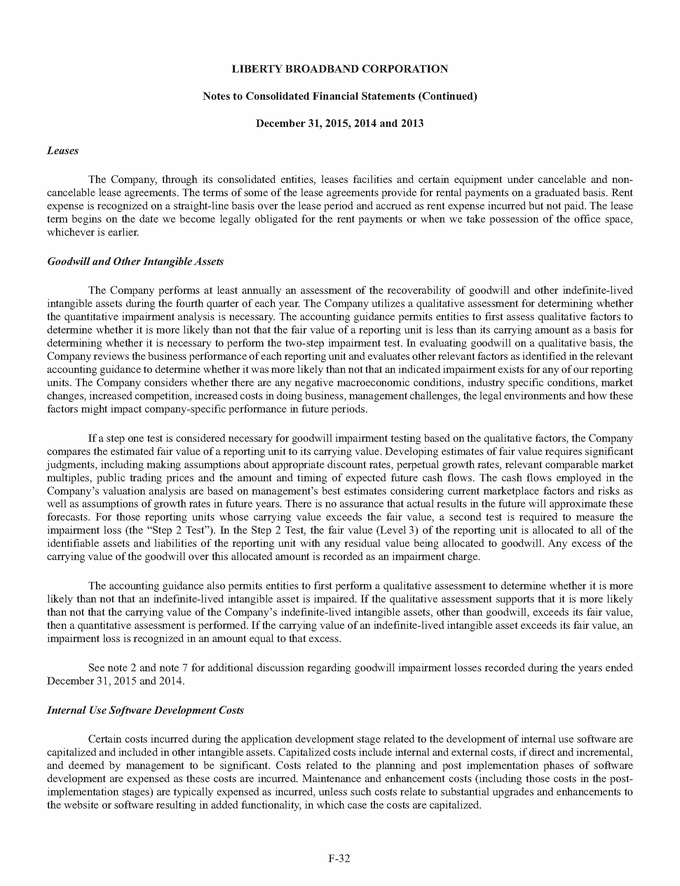
LIBERTY BROADBAND CORPORATION Notes to Consolidated Financial Statements (Continued) December 31, 2015, 2014 and 2013 Impairment of Long-Lived Assets Intangible assets with definite lives and other long-lived assets are carried at cost and are amortized on a straight-line basis over their estimated useful lives of three to five and a half years. The Company periodically reviews the carrying value of long-lived assets or asset groups, including property and equipment, to be used in operations whenever events or changes in circumstances indicate that the carrying amount of the assets or asset groups might not be recoverable. Factors that would necessitate an impairment assessment include a significant adverse change in the extent or manner in which an asset is used, a significant adverse change in legal factors or the business climate that could affect the value of the asset group, or a significant decline in the observable market value of an asset group, among others. If such facts indicate a potential impairment, the recoverability of the asset group is assessed by determining whether the carrying value of the asset group exceeds the sum of the projected undiscounted cash flows expected to result from the use and eventual disposition of the asset group over the remaining economic life of the asset group. If the carrying amount of the asset group is greater than the expected undiscounted cash flows to be generated by such asset group, including its ultimate disposition, an impairment adjustment is to be recognized. Such adjustment is measured by the amount that the carrying value of such asset groups exceeds their fair value. The Company generally measures fair value by considering sale prices for similar assets or by discounting estimated future cash flows using an appropriate discount rate. Considerable management judgment is necessary to estimate the fair value of asset groups. Accordingly, actual results could vary significantly from such estimates. Asset groups to be disposed of are carried at the lower of their financial statement carrying amount or fair value less costs to sell. The Company recorded a $16.8 million impairment loss of its intangible assets with definite lives during the year ended December 31, 2014 due to an anticipated decline in Skyhook’s operations as a result of the loss of one of Skyhook’s significant customers, as discussed in note 2. There was no indication of impairment of long-lived assets during the years ended December 31, 2015 or 2013. Foreign Currency Translation and Transaction Gains and Losses The functional currency of the Company is the United States (“U.S.”) dollar. Transactions denominated in currencies other than the functional currency are recorded based on exchange rates at the time such transactions arise. Subsequent changes in exchange rates result in transaction gains and losses which are reflected in the accompanying consolidated statements of operations and comprehensive earnings (loss) as unrealized (based on the applicable period end exchange rate) or realized upon settlement of the transactions. Revenue Recognition TruePosition earns revenue from the sale of hardware and licensing of software required to generate location records for wireless phones and other wireless devices on a cellular network and from the design, installation, testing, and commissioning of such hardware and software. In addition, TruePosition earns software maintenance revenue through the provision of ongoing technical and software support. TruePosition’s tangible products contain software components and non-software components that function together to deliver the tangible products’ essential functionality. Under the applicable accounting guidance, arrangements for such products are excluded from the scope of software revenue recognition guidance and are subject to the guidance for multiple-element arrangements. Accordingly, for multiple-element arrangements entered into or materially modified on or after January 1, 2011, the overall arrangement fee is allocated to each element (both delivered and undelivered items) based on their relative selling prices, regardless of whether those selling prices are evidenced by vendor specific objective evidence (“VSOE”) or third-party evidence of selling price or are based on the entity’s estimated selling price. The associated revenue for each element is recognized upon delivery assuming all other criteria for revenue recognition are met. For arrangements which do not qualify for treatment under the new guidance, TruePosition continues to account for such arrangements consistent with the guidance for software revenue recognition. Under those policies, for revenue derived from
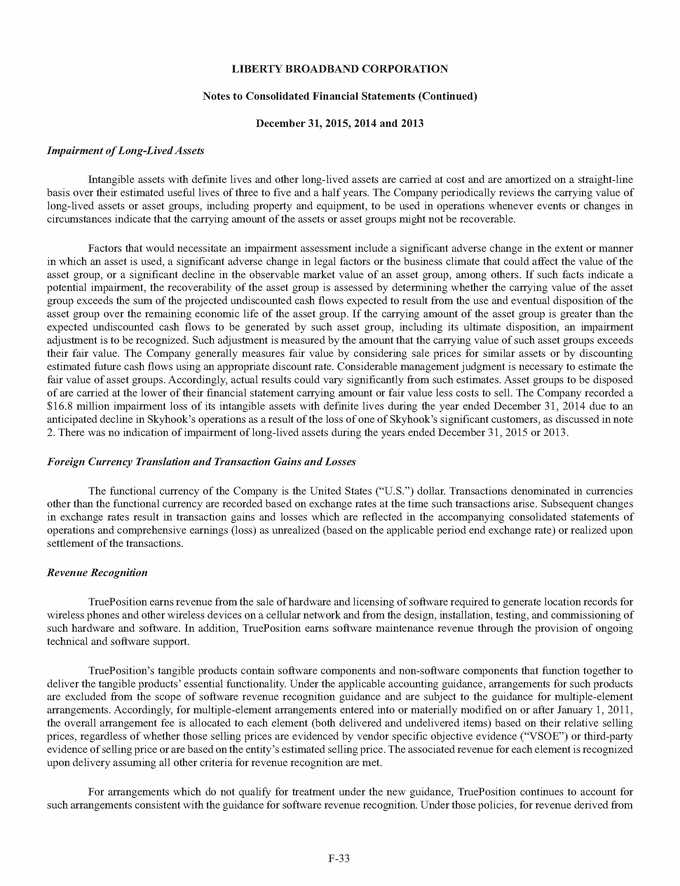
LIBERTY BROADBAND CORPORATION Notes to Consolidated Financial Statements (Continued) December 31, 2015, 2014 and 2013 multiple-element arrangements, if VSOE exists for each of the elements of the arrangement at the outset, the Company allocates the revenue to the various elements for recognition upon delivery of each element. If not, the revenue is deferred until the earlier of establishing sufficient VSOE for allocating revenue for recognition or delivery of all of the elements. If a multiple-element arrangement includes post-contract customer support (commonly referred to as maintenance), VSOE must exist for the maintenance in order to allocate revenue to all of the elements of the arrangement. If VSOE does not exist for the maintenance, revenue for the entire arrangement is recognized ratably over the contractual or expected term of the maintenance arrangement. Direct costs related to multiple-element arrangements are deferred and recognized as the related revenue is recognized. Direct costs include installation services, hardware, and software costs. TruePosition’s multiple-element arrangement with its significant customer also contemplates usage-based transaction fees for certain commercial uses of TruePosition’s hardware and software. TruePosition also provides training, technical, and repair services under its multiple-element arrangements. Revenue is recognized upon delivery of the services. In May 2014, the Financial Accounting Standards Board (“FASB”) issued new accounting guidance on revenue from contracts with customers. The new guidance requires an entity to recognize the amount of revenue to which it expects to be entitled for the transfer of promised goods or services to customers. The updated guidance will replace most existing revenue recognition guidance in GAAP when it becomes effective and permits the use of either a retrospective or cumulative effect transition method. This guidance is effective for fiscal years, and interim periods within those fiscal years, beginning after December 15, 2017. The Company is currently evaluating the effect that the new standard may have on its revenue recognition and has not yet selected a transition method but does not believe the standard will significantly affect its financial statements and related disclosures. Research and Development Costs Research and development costs are expensed as incurred. Deferred Revenue and Deferred Costs Deferred revenue represents billings in excess of revenue previously recognized. Deferred costs represent direct costs related to installation services, hardware, and software, which, to the extent not previously recognized, are recognized as the related revenue is recognized. As of December 31, 2014, the long-term portion of deferred revenue included $35.5 million of payments received from TruePosition’s largest customer, which were attributed to prepaid transaction fees. As discussed in note 2, TruePosition recognized this deferred revenue during December 2015, in connection with the expiration of this customer’s contract. Stock -Based Compensation As more fully described in note 11, Liberty Broadband has granted to its directors, employees and employees of certain of its subsidiaries options, restricted stock and stock appreciation rights (“SARs”) to purchase shares of Liberty Broadband common stock (collectively, “Awards”). Liberty Broadband measures the cost of employee services received in exchange for an Award of equity instruments (such as stock options and restricted stock) based on the grant-date fair value of the Award, and recognizes that cost over the period during which the employee is required to provide service (usually the vesting period of the Award). Liberty Broadband measures the cost of employee services received in exchange for an Award of liability instruments (such as stock appreciation rights that will be settled in cash) based on the current fair value of the Award, and remeasures the fair value of the Award at each reporting date. Certain outstanding awards of Liberty were assumed by Liberty Broadband at the time of the Broadband Spin-Off.
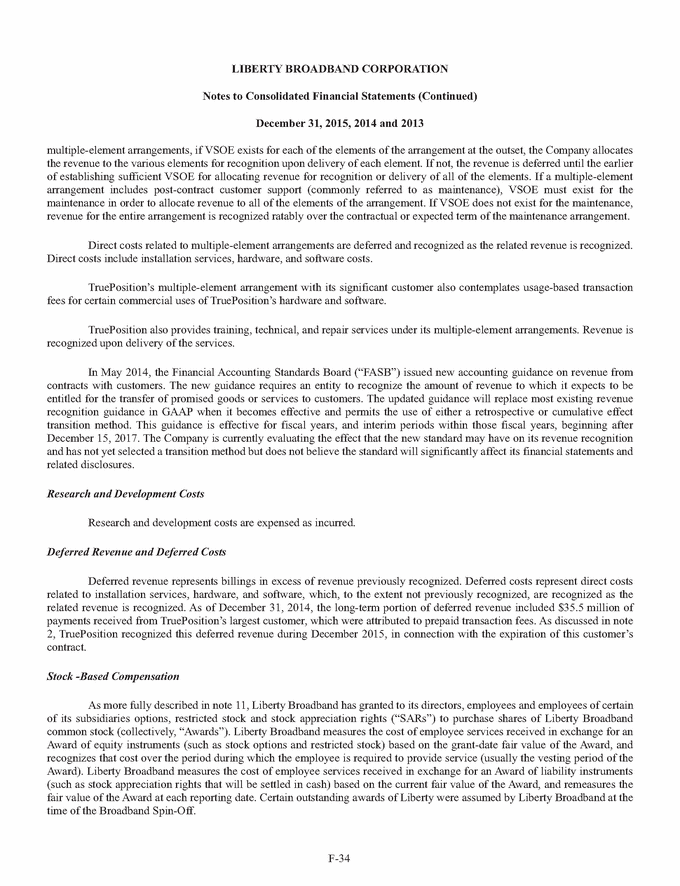
LIBERTY BROADBAND CORPORATION Notes to Consolidated Financial Statements (Continued) December 31, 2015, 2014 and 2013 Additionally, TruePosition and Skyhook each sponsor a long-term incentive plan (“LTIP”) which provide for the granting of phantom stock units (“PSUs”), and phantom stock appreciation rights (“PARs”) to employees, directors, and consultants of TruePosition and Skyhook, respectively. TruePosition also sponsors a Stock Incentive Plan (“SIP”), which provides for the granting of stock options to employees, directors, and consultants of TruePosition. TruePosition measures the cost of employee services received in exchange for awards of equity instruments based on the grant-date fair value of the award and recognizes that cost ratably over the period during which the employee is required to provide service (usually the vesting period of the award). TruePosition measures the cost of employee services received in exchange for awards of liability instruments (such as PSUs and PARs that will be settled in cash) based on the current fair value of the award, and remeasures the fair value of the award at each reporting date. The consolidated statements of operations includes stock-based compensation related to TruePosition awards. Included in the accompanying consolidated statements of operations are the following amounts of stock-based compensation for the years ended December 31, 2015, 2014 and 2013 (amounts in thousands): December 31, 2015 2014 2013 Operating expense $ 7 1 2 Selling, general and administrative 5,978 832 751 Research and development 395 166 243 $ 6,380 999 996 Income Taxes The Company accounts for income taxes using the asset and liability method. Deferred tax assets and liabilities are recognized for the future tax consequences attributable to differences between the financial statement carrying value amounts and income tax bases of assets and liabilities and the expected benefits of utilizing net operating loss and tax credit carryforwards. The deferred tax assets and liabilities are calculated using enacted tax rates in effect for each taxing jurisdiction in which the Company operates for the year in which those temporary differences are expected to be recovered or settled. Net deferred tax assets are then reduced by a valuation allowance if the Company believes it more likely than not that such net deferred tax assets will not be realized. We consider all relevant factors when assessing the likelihood of future realization of our deferred tax assets, including our recent earnings experience by jurisdiction, expectations of future taxable income, and the carryforward periods available to us for tax reporting purposes, as well as assessing available tax planning strategies. The effect on deferred tax assets and liabilities of an enacted change in tax rates is recognized in income in the period that includes the enactment date. Due to inherent complexities arising from the nature of our businesses, future changes in income tax law, tax sharing agreements or variances between our actual and anticipated operating results, we make certain judgments and estimates. Therefore, actual income taxes could materially vary from these estimates. In November 2015, the FASB issued new accounting guidance that eliminates the current requirement for organizations to present deferred tax assets and liabilities as current and noncurrent in a classified balance sheet. Under the new guidance, organizations will be required to classify all deferred tax assets and liabilities as noncurrent. The new guidance may be applied prospectively to all deferred tax liabilities and assets or retrospectively to all periods presented. This guidance is effective for fiscal years, and interim periods within those fiscal years, beginning after December 15, 2016. Early adoption is permitted. The Company elected to early adopt this guidance retrospectively during the current period. Accordingly, all deferred tax assets and liabilities are presented as noncurrent in the financial statements for all periods presented. The adoption of the new guidance resulted in the reclassification of $11.3 million deferred income tax assets previously reported as current deferred income tax assets to be reclassified to noncurrent deferred income tax assets as of December 31, 2014. When the tax law requires interest to be paid on an underpayment of income taxes, the Company recognizes interest expense from the first period the interest would begin accruing according to the relevant tax law. Such interest expense is included in interest expense in the accompanying consolidated statements of operations. Any accrual of penalties related to underpayment
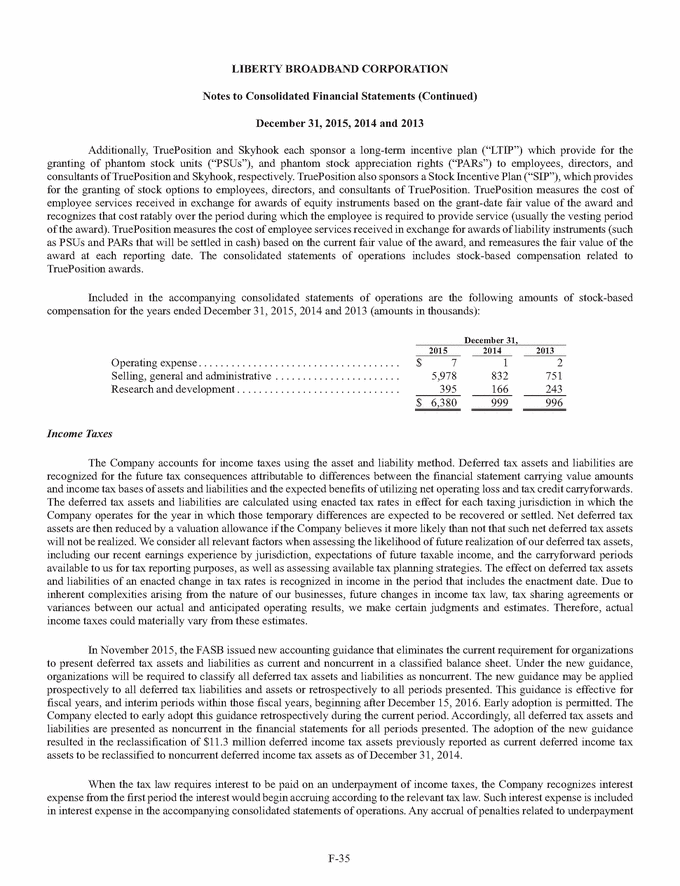
LIBERTY BROADBAND CORPORATION Notes to Consolidated Financial Statements (Continued) December 31, 2015, 2014 and 2013 of income taxes on uncertain tax positions is included in other income (expense) in the accompanying consolidated statements of operations. We recognize in our consolidated financial statements the impact of a tax position, if that position is more likely than not to be sustained upon an examination, based on the technical merits of the position. Certain Risks and Concentrations The TruePosition business is subject to certain risks and concentrations including dependence on relationships with its customers. TruePosition has one significant customer whose contract expired on December 31, 2015. The loss of this customer is expected to have a material adverse effect on TruePosition’s business unless TruePosition is able to generate significant new business to replace the financial impact of this customer. For the years ended December 31, 2015, 2014 and 2013, this customer accounted for 85%, 83% and 85%, respectively, of TruePosition’s total revenue. As discussed in note 7, we recorded an impairment loss during December 2015 due to the expected decline in TruePosition’s operations from the loss of this customer. Contingent Liabilities Periodically, we review the status of all significant outstanding matters to assess any potential financial exposure. When (i) it is probable that an asset has been impaired or a liability has been incurred and (ii) the amount of the loss can be reasonably estimated, we record the estimated loss in our consolidated statements of operations. We provide disclosure in the notes to the consolidated financial statements for loss contingencies that do not meet both these conditions if there is a reasonable possibility that a loss may have been incurred that would be material to the financial statements. Significant judgment is required to determine the probability that a liability has been incurred and whether such liability is reasonably estimable. We base accruals made on the best information available at the time which can be highly subjective. The final outcome of these matters could vary significantly from the amounts included in the accompanying consolidated financial statements. Comprehensive Earnings (Loss) Comprehensive earnings (loss) consists of net income (loss), cumulative foreign currency translation adjustments, unrealized gains and losses on available-for-sale securities, net of tax and the Company’s share of the comprehensive earnings (loss) of our equity method affiliate. Earnings per Share (EPS) Basic earnings (loss) per common share (“EPS”) is computed by dividing net earnings (loss) by the weighted average number of common shares outstanding for the period. Diluted EPS presents the dilutive effect on a per share basis of potential common shares as if they had been converted at the beginning of the periods presented. The Company issued 85,761,332 common shares, which is the aggregate number of shares of Series A, Series B and Series C common stock outstanding upon the completion of the Broadband Spin-Off on November 4, 2014. Additionally, as part of the recapitalization, Liberty Broadband distributed subscription rights, which were priced at a discount to the market value, to all holders of Liberty Broadband common stock (see further discussion in note 10). The rights offering, because of the discount, is considered a stock dividend which requires retroactive treatment for prior periods for the weighted average shares outstanding based on a factor applied determined by the fair value per share immediately prior to the rights exercise and the theoretical fair value after the rights exercise. The number of shares issued upon completion of the Broadband Spin-Off, adjusted for the rights factor, was used to determine both basic and diluted EPS for the year ended December 31, 2013 and for the period from January 1, 2014 through the date of the Broadband Spin-Off, as no Company equity awards were outstanding prior to the Broadband Spin-Off. Basic EPS subsequent to the Broadband Spin-Off was computed using the weighted average number of shares outstanding (“WASO”), adjusted for the rights factor, from the date of the completion of the Broadband Spin-Off through January
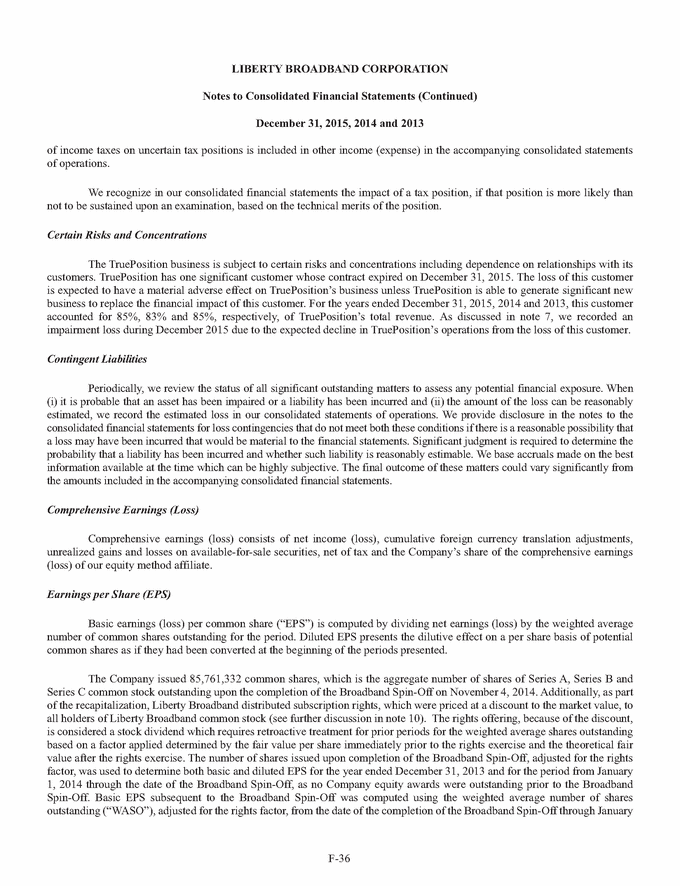
LIBERTY BROADBAND CORPORATION Notes to Consolidated Financial Statements (Continued) December 31, 2015, 2014 and 2013 9, 2015, the date on which the rights offering was fully subscribed. Basic EPS subsequent to January 9, 2015 was computed using WASO. Diluted EPS subsequent to the Broadband Spin-Off was computed using the WASO from the date of the completion of the Broadband Spin-Off through January 9, 2015, adjusted for the rights factor and potentially dilutive equity awards outstanding during the same period. Subsequent to January 9, 2015, basic EPS was computed using the WASO during the period, and diluted EPS was computed using the WASO adjusted for potentially dilutive equity awards outstanding during the period. Years ended December 31, 2015 2014 2013 number of shares in thousands Basic WASO 102,504 88,143 88,343 Potentially dilutive shares 494 630 — Diluted WASO 102,998 88,773 88,343 Excluded from diluted EPS for the year ended December 31, 2015 are approximately 3 thousand potential common shares because their inclusion would be anti-dilutive. Reclasses and adjustments Certain prior period amounts have been reclassified for comparability with the current year presentation. Estimates The preparation of financial statements in conformity with GAAP requires management to make estimates and assumptions that affect the reported amounts of assets and liabilities at the date of the financial statements and the reported amounts of revenue and expenses during the reporting period. Actual results could differ from those estimates. The Company considers (i) application of the equity method of accounting for its affiliates, (ii) fair value of non-financial instruments, (iii) fair value of financial instruments, (iv) revenue recognition, and (v) accounting for income taxes to be its most significant estimates. (4) Assets and Liabilities Measured at Fair Value For assets and liabilities required to be reported at fair value, GAAP provides a hierarchy that prioritizes inputs to valuation techniques used to measure fair value into three broad levels. Level 1 inputs are quoted market prices in active markets for identical assets or liabilities that the reporting entity has the ability to access at the measurement date. Level 2 inputs are inputs, other than quoted market prices included within Level 1, that are observable for the asset or liability, either directly or indirectly. Level 3 inputs are unobservable inputs for the asset or liability. The Company does not have any recurring assets or liabilities measured at fair value that would be considered Level 3.
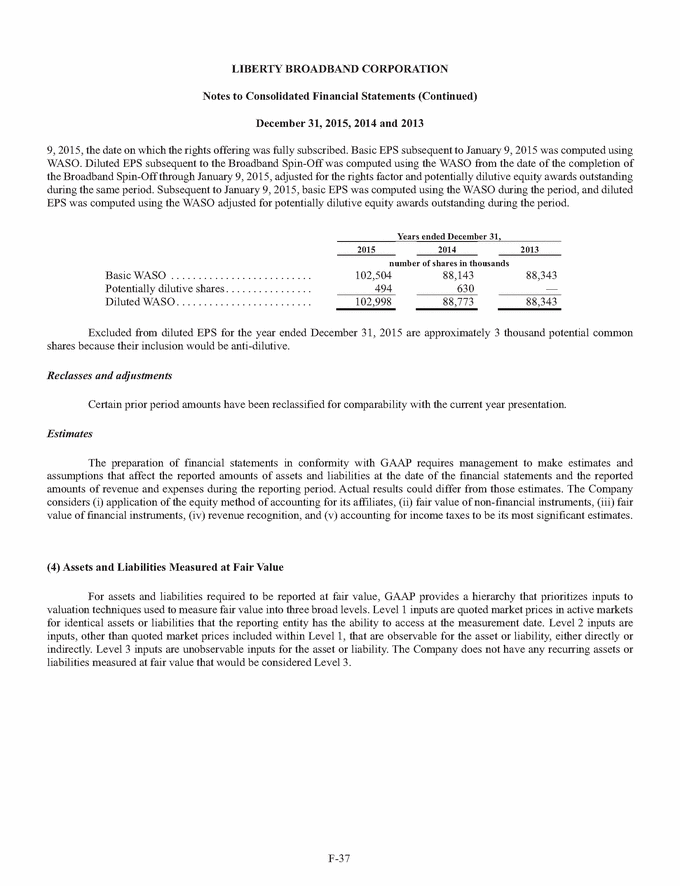
LIBERTY BROADBAND CORPORATION Notes to Consolidated Financial Statements (Continued) December 31, 2015, 2014 and 2013 The Company’s assets and liabilities measured at fair value are as follows: December 31, 2015 December 31, 2014 Quoted prices Significant Quoted prices Significant in active other in active other markets for observable markets for observable identical assets inputs identical assets inputs Description Total (Level 1) (Level 2) Total (Level 1) (Level 2) amounts in thousands Cash equivalents $ 639,956 639,956 — 36,002 36,002 — Short-term marketable securities $ 9,014 9,014 — 9,001 9,001 — Available-for-sale securities $ 439,560 439,560 — 360,762 360,762 — Time Warner Cable financial instruments (1)(2) $ — — — (75,356) — (75,356) (1) As of December 31, 2014, the Company had an outstanding written call option on 625,000 Time Warner Cable shares with a strike price of $92.02 per share which expired in February 2015. Upon expiration, this written call option was rolled into a new written call option on 625,000 Time Warner Cable shares with a strike price of $100.39 per share which the Company cash settled during June 2015 for $48.3 million. Additionally, as of December 31, 2014, the Company had another outstanding written call option on 625,000 Time Warner Cable shares with a strike price of $90.84 per share which the Company cash settled during April 2015 for $36.7 million. No written call options on Time Warner Cable shares are outstanding as of December 31, 2015. (2) On March 27, 2015, Liberty Broadband entered into a cashless collar agreement with a financial institution on 1.7 million Time Warner Cable shares held by the Company with a put option strike price of $136.80 per share and a call option strike price of $161.62 per share. The collar was originally scheduled to expire during March 2017. The Company unwound the agreement during July 2015 for $67.1 million cash paid to the counterparty. In connection with this collar agreement, the Company also entered into a revolving loan agreement with an availability of $234 million, which was terminated upon unwinding of the collar agreement during July 2015 (note 8). The fair value of Level 2 derivative liabilities were derived from a Black-Scholes model using observable market data as the significant inputs. The inputs used in the model during the period outstanding (exclusive of the applicable trading price of Time Warner Cable stock and the strike prices associated with the call options) were as follows: Range Volatility. 11.7% — 29.1 % Interest rate 0.23% — 0.99 % Dividend yield 0 % — 1.71 % Other Financial Instruments Other financial instruments not measured at fair value on a recurring basis include trade receivables, trade payables, accrued and other current liabilities. The carrying amount approximates fair value due to the short maturity of these instruments as reported on our consolidated balance sheets.
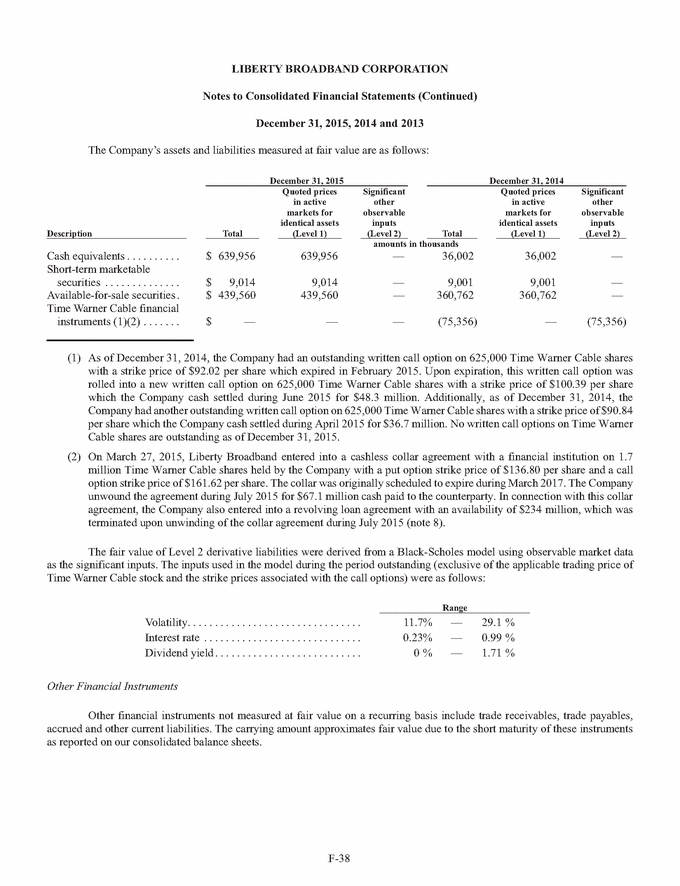
LIBERTY BROADBAND CORPORATION Notes to Consolidated Financial Statements (Continued) December 31, 2015, 2014 and 2013 Realized and Unrealized Gains (Losses) on Financial Instruments Realized and unrealized gains (losses) on financial instruments are comprised of changes in the fair value of the following: Years ended December 31, 2015 2014 2013 (amounts in thousands) Charter warrants (1) $ NA 32,782 38,234 Time Warner Cable investment and financial instruments 2,619 18,407 59,626 $ 2,619 51,189 97,860 (1) As discussed in note 6, Liberty Broadband exercised all of the Company’s outstanding warrants to purchase shares of Charter common stock during November 2014, subsequent to the completion of the Broadband Spin- Off. (5) Investments in Available-for-Sale Securities All marketable equity and debt securities held by the Company are classified as available-for-sale (“AFS”) and are carried at fair value generally based on quoted market prices. GAAP permits entities to choose to measure many financial instruments, such as AFS securities, and certain other items at fair value and to recognize the changes in fair value of such instruments in the entity’s statements of operations. The Company has elected to account for those of its AFS securities which it considers to be nonstrategic (“Fair Value Option Securities”) at fair value. Accordingly, changes in the fair value of Fair Value Option Securities, as determined by quoted market prices, are reported in realized and unrealized gains (losses) on financial instruments in the accompanying consolidated statements of operations. Investments in AFS securities, including our interest in Time Warner Cable which is our only Fair Value Option Security, are summarized as follows: December 31, December 31, 2015 2014 amounts in thousands Time Warner Cable $ 438,912 359,615 Other equity securities 648 1,147 Total Investments in available-for-sale securities $ 439,560 360,762 Unrealized Holding Gains and Losses As of December 31, 2015 and 2014, the gross unrealized holding gains related to investment in AFS securities were $357 thousand and $820 thousand, respectively. There were no gross unrealized holding losses related to investment in AFS securities for the periods presented.
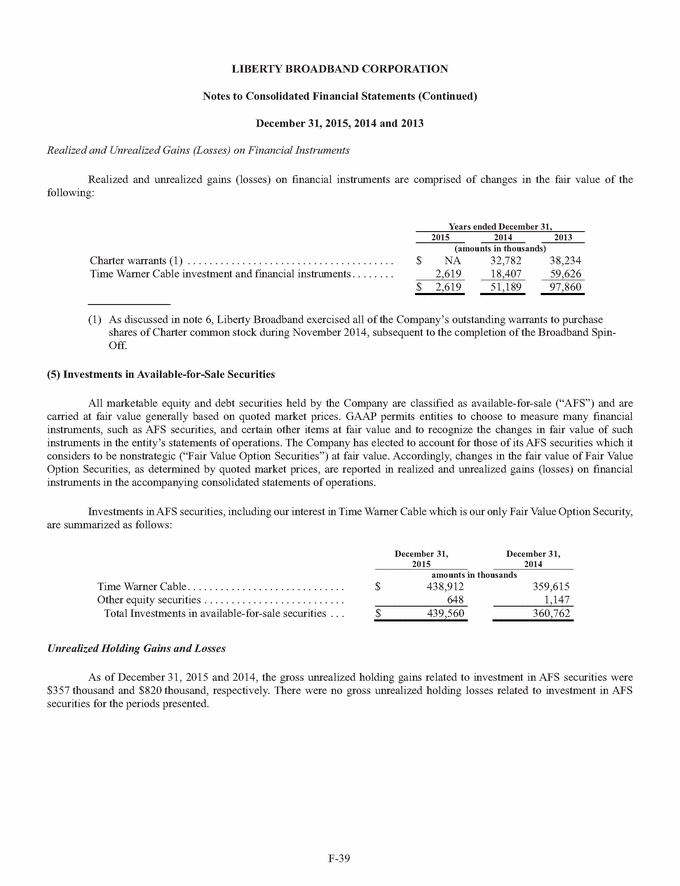
LIBERTY BROADBAND CORPORATION Notes to Consolidated Financial Statements (Continued) December 31, 2015, 2014 and 2013 (6) Investments in Affiliates Accounted for Using the Equity Method In May 2013, Liberty completed a transaction with investment funds managed by, or affiliated with, Apollo Management, Oaktree Capital Management and Crestview Partners to acquire approximately 26.9 million shares of common stock and approximately 1.1 million warrants in Charter for approximately $2.6 billion, which represented an approximate 27% beneficial ownership (including the warrants on an as if converted basis) in Charter at the time of purchase and a price per share of $95.50. Liberty funded the purchase with a combination of cash of approximately $1.2 billion on hand and new margin loan arrangements on approximately 20.3 million Charter common shares, approximately 720 million SIRIUS XM common shares, approximately 8.1 million Live Nation common shares and a portion of Liberty’s available for sale securities, including shares of Time Warner Cable. The margin loan secured by the Charter and Time Warner Cable shares was repaid and the collateral was released prior to completion of the Broadband Spin-Off. Liberty allocated the purchase price between the shares of common stock and the warrants acquired in the transaction by determining the fair value of the publicly traded warrants and allocating the remaining balance to the shares acquired, which resulted in an excess basis in the investment of $2,532.3 million. The investment in Charter is accounted for as an equity method affiliate based on the ownership interest obtained and the board seats held by individuals appointed by Liberty. During May 2014, Liberty purchased 897 thousand Charter shares for approximately $124.5 million. During November 2014, subsequent to the completion of the Broadband Spin-Off, Liberty Broadband borrowed $52 million to fund the exercise of all of the Company’s outstanding Charter warrants (see note 8). The exercise of the Charter warrants resulted in a non-cash investing addition of $130.6 million to the investments in affiliates, accounted for using the equity method line item and a $130.6 million non-cash investing reduction to the derivative instruments line item within the consolidated balance sheets. Charter Communications, Inc. Summarized financial information for Charter is as follows: Consolidated Balance Sheets December 31, December 31, 2015 2014 amounts in millions Current assets $ 345 345 Property and equipment, net 8,345 8,373 Goodwill 1,168 1,168 Intangible assets 6,862 7,111 Other assets 22,596 7,391 Total assets $ 39,316 24,388 Current liabilities $ 1,972 1,635 Deferred income taxes 1,590 1,648 Long-term debt 35,723 20,887 Other liabilities 77 72 Equity (46) 146 Total liabilities and equity $ 39,316 24,388
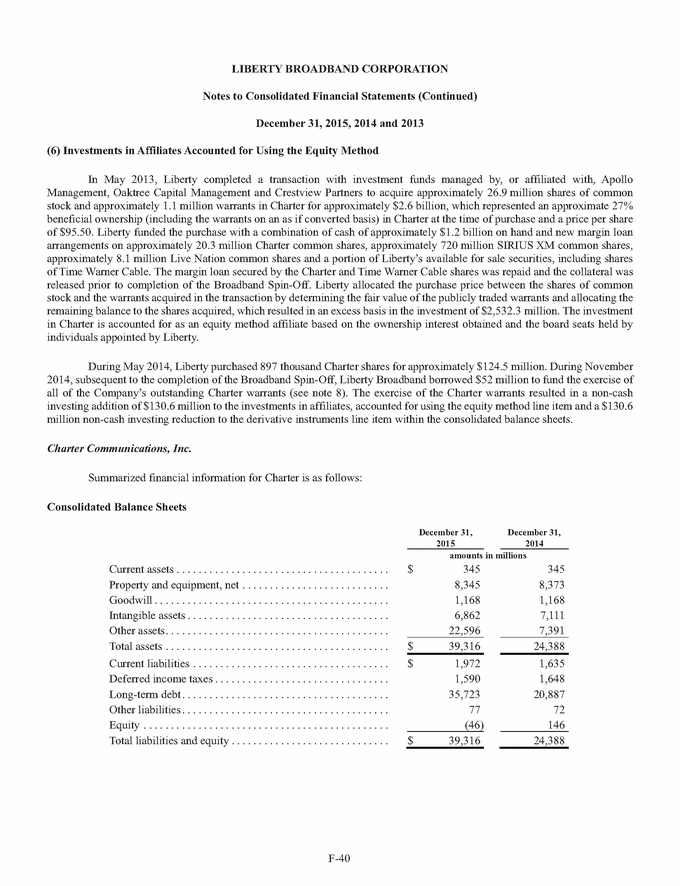
LIBERTY BROADBAND CORPORATION Notes to Consolidated Financial Statements (Continued) December 31, 2015, 2014 and 2013 Consolidated Statements of Operations Years ended December 31, 2015 2014 2013 amounts in millions Revenue $ 9,754 9,108 8,155 Cost and expenses: Operating costs and expenses (excluding depreciation and amortization) 6,426 5,973 5,345 Depreciation and amortization 2,125 2,102 1,854 Other operating expenses, net 89 62 47 8,640 8,137 7,246 Operating income 1,114 971 909 Interest expense (1,306) (911) (846) Loss on extinguishment of debt (128) — (123) Other income (expense), net (11) (7) 11 Income tax (expense) benefit 60 (236) (120) Net earnings (loss) $ (271) (183) (169) As of December 31, 2015, the carrying value of Liberty Broadband’s ownership in Charter was approximately $2,373 million. The market value of Liberty Broadband’s ownership in Charter as of December 31, 2015 was approximately $5,280 million, which represented an approximate ownership of 26% of the outstanding equity of Charter as of that date. During the years ended December 31, 2015, 2014 and 2013, there were $7.2 million, $87.2 million and $92.9 million of dilution losses, respectively, in the Company’s investment in Charter due to warrant and stock option exercises by third parties below Liberty Broadband’s book basis per share. During the years ended December 31, 2015, 2014 and 2013, the Company recorded $1.3 million, $3.2 million and $3.7 million, respectively, of its share of Charter’s other comprehensive earnings, net of income taxes. Charter records gains and losses related to the fair value of its interest rate swap agreements which qualify as hedging activities in other comprehensive income. The pre-tax portion of Liberty Broadband’s share of Charter’s other comprehensive earnings was $2.1 million, $5.2 million and $6.0 million for the years ended December 31, 2015, 2014 and 2013, respectively. Due to the amortization of amortizable assets acquired and losses due to warrant and stock option exercises at Charter (as previously discussed), the excess basis has decreased to $2,384.6 million as of December 31, 2015. Such amount has been allocated within memo accounts used for equity method accounting purposes as follows (amounts in millions): Property and equipment $ 354.7 Customer relationships 566.6 Franchise fees 1,451.4 Trademarks 36.2 Goodwill 935.0 Debt (126.1) Deferred income tax liability (833.2) $ 2,384.6 Upon acquisition, the Company ascribed remaining useful lives of 7 years and 13 years to property and equipment and customer relationships, respectively, and indefinite lives to franchise fees, trademarks and goodwill. Outstanding debt is amortized over the contractual period using the effective interest rate method. Included in our share of losses from Charter of, $121.0 million, $127.6 million and $76.1 million for the years ended December 31, 2015, 2014 and 2013, respectively, are $51.6
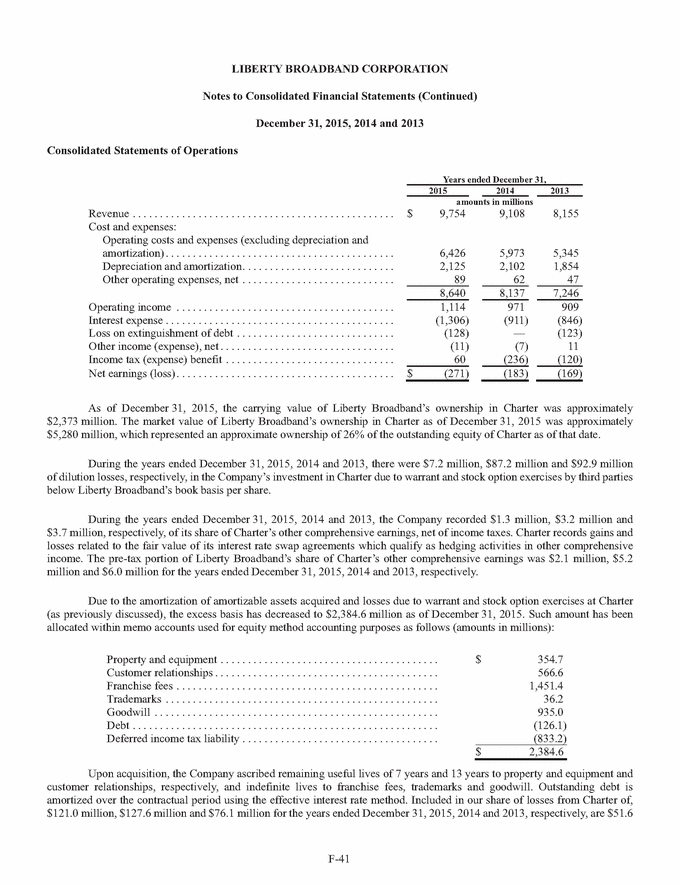
LIBERTY BROADBAND CORPORATION Notes to Consolidated Financial Statements (Continued) December 31, 2015, 2014 and 2013 million, $81.2 million and $44.3 million, respectively, of losses, net of taxes, due to the amortization of the excess basis of our investment in Charter related to debt and intangible assets with identifiable useful lives. The excess basis amortization during the year ended December 31, 2015 was offset by the write-off of the excess basis related to debt instruments which Charter repaid during the second quarter of 2015 prior to their contractual maturity. On March 31, 2015, Liberty Broadband announced its entry into a new stockholders agreement with Charter, a subsidiary of Charter (“New Charter”) and Advance/Newhouse Partnership (“A/N”) (the “Bright House Stockholders Agreement”), which would have replaced the Company’s existing stockholders agreement with Charter, as amended September 29, 2014. Liberty Broadband’s entry into the Bright House Stockholders Agreement came as the result of Charter’s announcement of a proposed transaction with A/N, pursuant to which New Charter would acquire Bright House Networks (“Bright House”) from A/N for $10.4 billion (the “Bright House Transaction”). The closing of the Bright House Transaction was subject to several conditions, including Charter’s receipt of stockholder approval, the expiration of Time Warner Cable’s right of first offer for Bright House, the closing of a binding definitive agreement between Charter and Comcast Corporation (the “Comcast Transactions Agreement”) and regulatory approval. As announced by Charter on April 24, 2015, the Comcast Transactions Agreement was terminated by Comcast Corporation. As the closing of the Comcast Transactions Agreement had been a condition to the Bright House Transaction, the parties to the Bright House Stockholders Agreement were to consider, and negotiate for a period of 30 days in good faith, amendments to the terms of the Bright House Stockholders Agreement that would be desirable to consummate the Bright House Transaction. On May 26, 2015, Liberty Broadband announced its entry into an agreement with Charter to invest $4.3 billion at a price of $176.95 per share (adjusted by the applicable exchange rates in the Time Warner Cable Merger) in connection with (and contingent upon) the closing of the proposed merger of Time Warner Cable and Charter (the “Time Warner Cable Merger”), which was also announced on May 26, 2015. Additionally, Liberty Broadband agreed to purchase an additional $700 million at a price of $173.00 per share (adjusted by the applicable exchange rates in the Time Warner Cable Merger) in connection with Charter’s proposed acquisition of Bright House from A/N, which is generally conditioned on the closing of the Time Warner Cable Merger. In connection with these transactions, it is expected that Charter will undergo a corporate reorganization, resulting in New Charter, a current subsidiary of Charter, becoming the new publicly traded parent company. As discussed previously, in support of the Time Warner Cable Merger, Liberty Broadband will purchase shares of stock in New Charter (the “Charter Shares”) using proceeds of $4.4 billion related to subscriptions for newly issued shares of Liberty Broadband’s Series C common stock (the “Series C Shares”), at a price per share of $56.23, which was determined based upon the fair value of Liberty Broadband’s net assets on a sum-of-the parts basis at the time the investment agreements were executed. The purchasers of the Series C Shares are Liberty Interactive through its Liberty Ventures Group and certain third party investors, which will all invest on substantially similar terms. One of the third party investors also holds a position in Time Warner Cable and has agreed to vote its Time Warner Cable shares in favor of the Time Warner Cable Merger. The Series C Share subscriptions are subject to customary closing conditions and funding will only occur in connection with the completion of the Time Warner Cable Merger. Each of Charter and Liberty Broadband obtained stockholder approval during September 2015 for the issuance of the Charter Shares and the Series C Shares, respectively, in accordance with the rules and requirements of the Nasdaq Stock Market. Liberty Broadband has the right, and may determine, to incur debt financing (subject to certain conditions) to fund a portion of the purchase price for its investment in New Charter, in which case Liberty Broadband may reduce the aggregate subscription for Series C Shares by up to 25%, with such reduction applied pro rata to all investors, including Liberty Interactive. In connection with the Time Warner Cable Merger, Liberty Broadband has also entered into an agreement with Charter pursuant to which it has agreed to vote all of its shares of Charter’s Class A common stock in favor of the Time Warner Cable Merger, the issuance of the Charter Shares and any related proposals. Liberty Broadband and Liberty Interactive have also entered into an agreement with Charter which provides that Liberty Broadband and Liberty Interactive will exchange, in a tax-free transaction, the shares of Time Warner Cable common stock held by each company for shares of New Charter Class A common stock (subject to certain limitations). In addition, Liberty Interactive has also agreed to grant Liberty Broadband a proxy over the
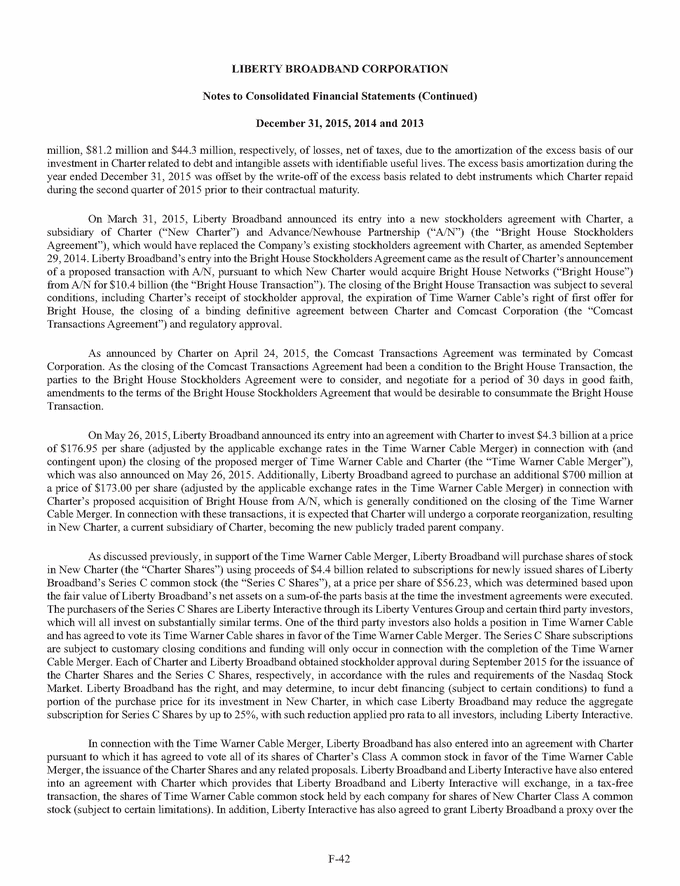
LIBERTY BROADBAND CORPORATION Notes to Consolidated Financial Statements (Continued) December 31, 2015, 2014 and 2013 shares of New Charter it receives in the exchange, along with a right of first refusal with respect to the underlying New Charter shares. Liberty Broadband intends to fund its commitment to purchase up to $700 million in shares of New Charter at a per share price of $173.00 (as adjusted) in connection with the Bright House acquisition through cash on hand or other financing. As previously announced, A/N and Liberty Broadband will enter into a proxy agreement, pursuant to which A/N will grant Liberty Broadband a five-year proxy to vote shares of New Charter held by A/N, capped at 7% of New Charter’s outstanding shares. Liberty Broadband is expected to control approximately 25.01% of the aggregate voting power of New Charter following the completion of the Time Warner Cable Merger and the Bright House Transaction and is expected to be New Charter’s largest stockholder. The terms of the Second Amended and Restated Stockholders Agreement (which will become effective in its entirety upon the closing of the Bright House Transaction) remain substantially similar to the Bright House Stockholders Agreement, except that the restrictions on Liberty Broadband’s ability to utilize its shares of New Charter in connection with financing transactions have been eliminated and A/N will be entitled to designate two (instead of three) director nominees, among other things. The Time Warner Cable Merger was approved by stockholders of both Charter and Time Warner Cable during September 2015 and is subject to regulatory approval and other customary conditions to closing. The Bright House Transaction is subject to several conditions, including the completion of the Time Warner Cable Merger (subject to certain exceptions if Time Warner Cable enters into another sale transaction) and regulatory approval. Therefore, as these transactions are subject to certain contingencies, we have not reflected any financial impacts in the consolidated financial statements related to the respective agreements as of December 31, 2015. (7) Goodwill and Other Intangible Assets Changes in the carrying amount of TruePosition goodwill is as follows (amounts in thousands): Balance at January 1, 2013 $ 20,669 Other — Balance at December 31, 2013 20,669 Acquisitions (1) 24,931 Impairments (2) (18,434) Balance at December 31, 2014 27,166 Impairments (3) (20,669) Balance at December 31, 2015 $ 6,497 (1) As discussed in note 2, TruePosition acquired Skyhook on February 14, 2014. (2) As discussed in note 2, as a result to the loss of one of Skyhook’s significant customers in November 2014, the Company determined the fair value of Skyhook and performed a Step 2 impairment test. The fair value of Skyhook, including the related intangibles and goodwill, was determined using Skyhook’s projections of future operating performance and applying a combination of market multiples (market approach) and discounted cash flow (income approach) calculations (Level 3). (3) As discussed in note 2, as a result to the loss of one of TruePosition’s significant customers in December 2015, the Company determined the fair value of TruePosition and performed a Step 2 impairment test. The fair value of TruePosition, including the related intangibles and goodwill, was determined using TruePosition’s projections of future operating performance and applying a combination of market multiples (market approach) and discounted cash flow (income approach) calculations (Level 3).
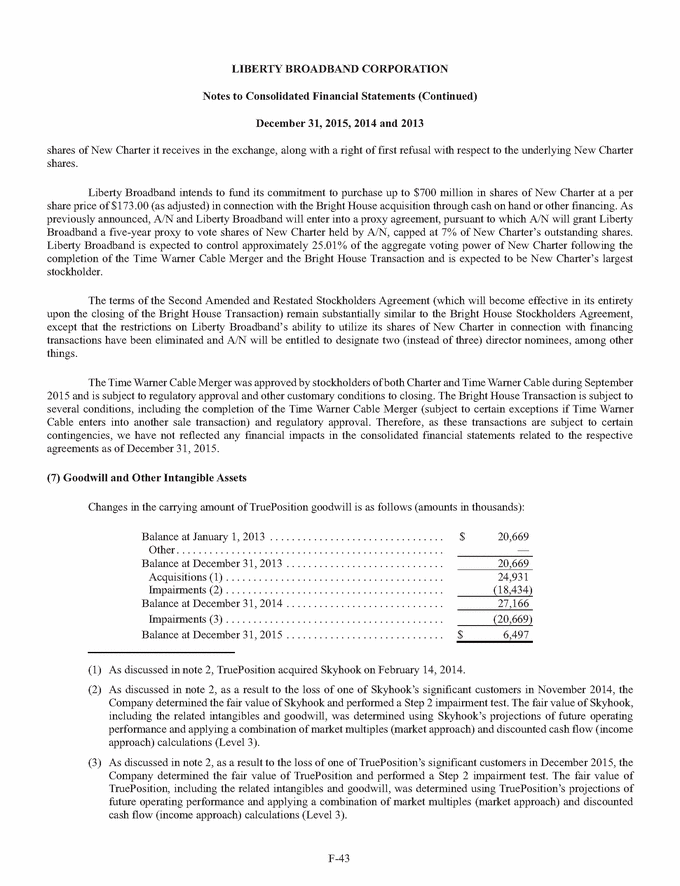
LIBERTY BROADBAND CORPORATION Notes to Consolidated Financial Statements (Continued) December 31, 2015, 2014 and 2013 During 2015, the Company recorded an impairment of all of the Company’s goodwill related to TruePosition, and as of December 31, 2015, the remaining goodwill relates to Skyhook. As of December 31, 2015, the Company’s accumulated goodwill impairment loss was $39.1 million. The Company does not have any significant indefinite lived intangible assets other than goodwill. Intangible assets subject to amortization are comprised of the following (amounts in thousands): December 31, 2015 December 31, 2014 Gross Carrying Accumulated Net Carrying Gross Carrying Accumulated Net Carrying Amount Amortization Amount Amount Amortization Amount Acquired patents $ 10,823 (6,872) 3,951 8,822 (5,801) 3,021 Tradename 2,838 (1,154) 1,684 2,788 (788) 2,000 Capitalized software 10,973 (10,857) 116 10,991 (10,597) 394 Customer relationships 10,212 (4,076) 6,136 10,212 (2,712) 7,500 $ 34,846 (22,959) 11,887 32,813 (19,898) 12,915 Effective January 1, 2015, TruePosition’s patents are amortized straight-line over three to three and a half years. TruePosition's capitalized software intangible assets are amortized straight-line over three to five years. TruePosition's customer relationships and tradename are amortized straight-line over five and a half years. Amortization expense was $3.1 million, $6.5 million and $1.4 million for each of the years ended December 31, 2015, 2014 and 2013, respectively. The estimated future amortization expense for the next five years related to intangible assets with definite lives as of December 31, 2015 is as follows (amounts in thousands): 2016 $ 3,412 2017 3,335 2018 2,529 2019 1,742 2020 869 Total $ 11,887 (8) Debt On October 30, 2014, in connection with and prior to the effectiveness of the Broadband Spin-Off, a wholly-owned special purpose subsidiary of the Company ("BroadbandSPV") entered into two margin loan agreements (the "Margin Loan Agreements") with each of the lenders party thereto. The Margin Loan Agreements permit BroadbandSPV, subject to certain funding conditions, to borrow term loans up to an aggregate principal amount equal to $400 million (the "Margin Loans"), of which BroadbandSPV borrowed $320 million on October 31, 2014 and had $80 million available to be drawn immediately following the Broadband Spin-Off. During November 2014, subsequent to the Broadband Spin-Off, Liberty Broadband borrowed an additional $52 million to fund the exercise of the Charter warrants. As of December 31, 2014, Liberty Broadband had $372 million outstanding under the Margin Loan Agreements, with an additional $28 million available to be drawn. $300 million of the amount borrowed pursuant to the Margin Loan Agreements (less certain expenses incurred in connection with the Margin Loans) was distributed to Liberty prior to the Broadband Spin-Off. During October 2015, Liberty Broadband borrowed an additional $28 million pursuant to the Margin Loan Agreements. The maximum borrowing capacity of $400 million under the Margin Loan Agreements was outstanding at December 31, 2015. The maturity date of the Margin Loans is October 30, 2017. Borrowings under the Margin Loan Agreements bear interest at the three-month LIBOR rate plus 1.55%. Interest is payable quarterly in arrears beginning on December 31, 2014. The Margin Loan Agreements contain various affirmative and negative covenants that restrict the activities of BroadbandSPV. The Margin Loan Agreements do not include any financial covenants. The Margin Loan Agreements also contain certain restrictions related to additional indebtedness.
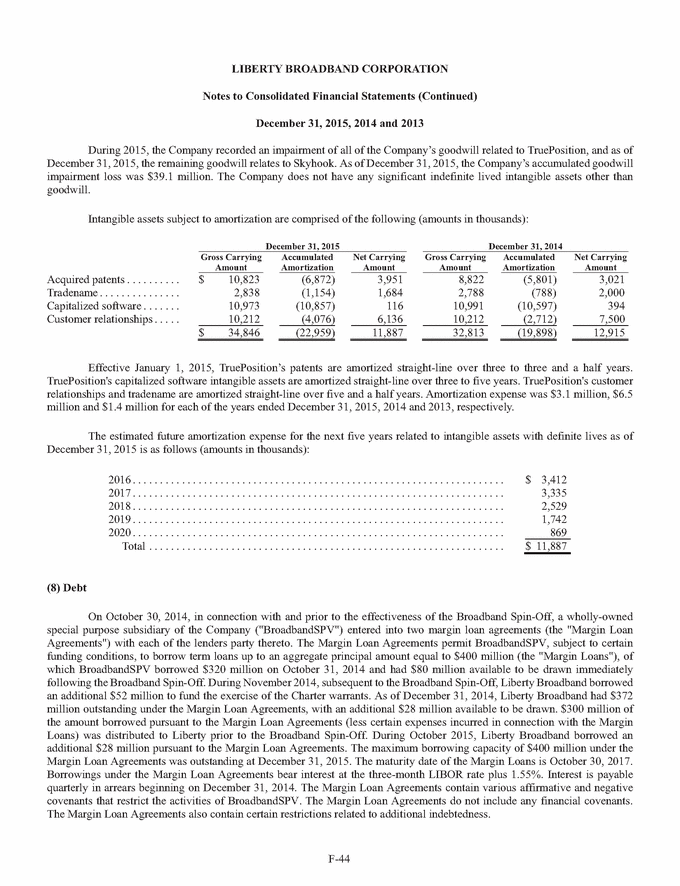
LIBERTY BROADBAND CORPORATION Notes to Consolidated Financial Statements (Continued) December 31, 2015, 2014 and 2013 BroadbandSPV's obligations under the Margin Loan Agreements are guaranteed by the Company. In addition, BroadbandSPV's obligations are secured by first priority liens on a portion of the Company's ownership interest in Charter, sufficient for BroadbandSPV to meet its loan to value requirement under the Margin Loan Agreements. Each agreement contains language that indicates that Liberty Broadband, as borrower and transferor of underlying shares as collateral, has the right to exercise all voting, consensual and other powers of ownership pertaining to the transferred shares for all purposes, provided that Liberty Broadband agrees that it will not vote the shares in any manner that would reasonably be expected to give rise to transfer or other certain restrictions. Similarly, the loan agreements indicate that no lender party shall have any voting rights with respect to the shares transferred, except to the extent that a lender party buys any shares in a sale or other disposition made pursuant to the terms of the loan agreements. As of December 31, 2015, 7.0 million shares of Charter with a value of $1.3 billion were pledged as collateral pursuant to the Margin Loans. In connection with the collar agreement on shares of Time Warner Cable entered into on March 27, 2015, as discussed in note 4, the Company also entered into a $234 million revolving loan agreement. On April 7, 2015, Liberty Broadband drew $40 million on this loan, which was the amount used to match the outstanding call liability due in April 2015. The shares of Time Warner Cable underlying the collar served as collateral for borrowings under the revolving loan agreement. Borrowings outstanding under the revolving loan agreement bore interest at the three-month LIBOR rate plus 0.64%, payable quarterly in arrears beginning on March 31, 2015. The interest rate on the unused portion of the revolving loan agreement was 0.12% per annum. The Company repaid the $40 million drawn on the loan during July 2015 and the agreement was terminated upon unwinding of the Time Warner Cable collar agreement. TruePosition had a $4 million line of credit, which expired on December 25, 2013, covering standby letters of credit issued for the benefit of TruePosition. Pursuant to the terms of the line of credit, upon its expiration, any issued and outstanding letters of credit remain in effect through the remainder of their respective terms, the last of which expired during the first quarter of 2015. Accordingly, there were no letters of credit outstanding at December 31, 2015. $634 thousand in letters of credit were outstanding as of December 31, 2014. Letters of credit issued under the line of credit prior to its expiration remained collateralized by a cash deposit maintained by the bank (note 3), which was cancelled upon the expiration of the last letter of credit during the first quarter of 2015. The line of credit bore interest at the rate of four-tenths of 1% per annum on the balance available for issuance of letters of credit. Letters of credit issued under the line of credit bore interest at 1.75%. All interest was payable quarterly. Interest expense related to the line of credit was not significant for the years ended December 31, 2015, 2014, or 2013. In April 2015, the FASB issued new accounting guidance on the presentation of debt issuance costs, which requires debt issuance costs related to a recognized debt liability to be presented on the balance sheet as a direct deduction from the debt liability. The new guidance intends to simplify the presentation of debt issuance costs. In August 2015, the FASB issued new accounting guidance on the presentation or subsequent measurement of debt issuance costs related to line of credit arrangements, which provides that such cost may be presented as an asset and amortized ratably over the term of the line of credit arrangement, regardless of whether there are outstanding borrowings on the arrangement. The amendments in these new accounting standards are effective for financial statements issued for fiscal years beginning after December 15, 2015 and interim periods within those years. Early adoption is permitted for financial statements that have not been previously issued and retrospective application is required for each balance sheet presented. We retrospectively early adopted this new guidance in the fourth quarter of 2015. Prior period amounts have been appropriately restated to reflect this change in presentation of deferred loan costs on the consolidated balance sheets. The adoption of the new guidance resulted in the reclassification of $461 thousand net debt issuance costs previously reported as other assets to be reclassified to debt as of December 31, 2014.
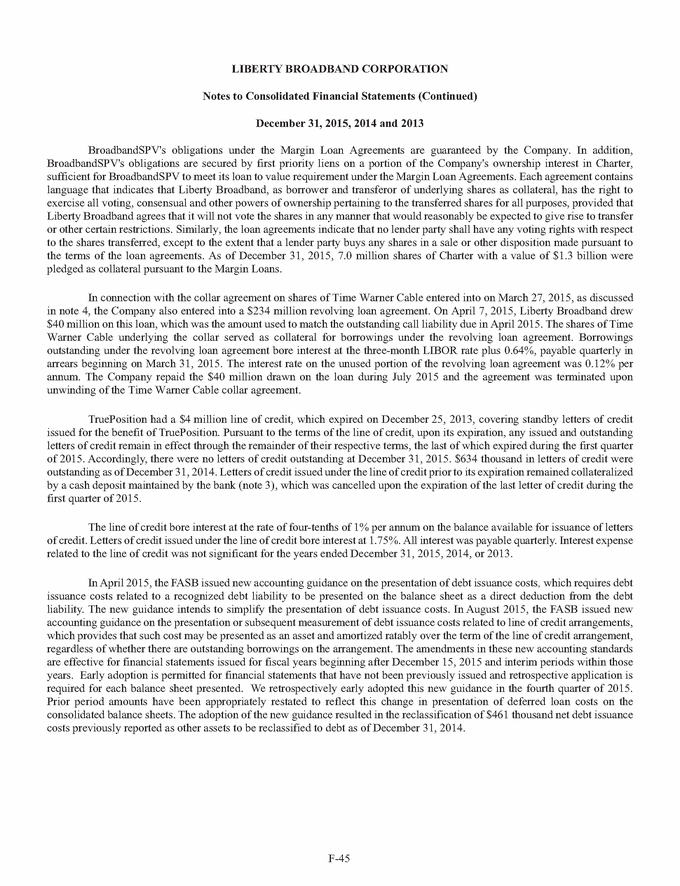
LIBERTY BROADBAND CORPORATION Notes to Consolidated Financial Statements (Continued) December 31, 2015, 2014 and 2013 (9) Income Taxes Liberty Broadband, as consolidated, was included in the federal consolidated income tax return of Liberty through November 4, 2014. Subsequent to the Broadband Spin-Off, Liberty Broadband files separate federal consolidated income tax returns. The tax provision included in these financial statements has been prepared on a stand-alone basis, as if Liberty Broadband was not part of the consolidated Liberty group for the periods prior to the Broadband Spin-Off. Charter and Time Warner Cable are not included in the Liberty Broadband consolidated group tax return as Liberty Broadband owns less than 80% of both companies. A portion of the income taxes allocated to Liberty Broadband by Liberty were treated as an equity contribution by Liberty upon completion of the Broadband Spin-Off. Income tax benefit (expense) consists of: Years ended December 31, 2015 2014 2013 amounts in thousands Current: Federal $ (4,234) 510 (5,124) State and local (862) 473 (3,102) (5,096) 983 (8,226) Deferred: Federal 23,512 62,014 26,735 State and local 1,452 4,689 4,189 24,964 66,703 30,924 Income tax benefit (expense) $ 19,868 67,686 22,698 Income tax benefit (expense) differs from the amounts computed by applying the U.S. federal income tax rate of 35% as a result of the following: Years ended December 31, 2015 2014 2013 amounts in thousands Computed expected tax benefit (expense) $ 24,519 70,802 22,549 State and local taxes, net of federal income taxes 1,786 2,657 2,462 Foreign taxes, net of foreign tax credit (59) — (751) Change in valuation allowance 612 (2,154) (986) Dividends received deduction 752 819 1,506 Change in tax rate (179) (998) (1,756) Impairment of intangible assets not deductible for tax purposes (7,234) (6,452) — Loss on liquidation of subsidiary — 3,082 — Other (329) (70) (326) Income tax (expense) benefit $ 19,868 67,686 22,698 For the year ended December 31, 2015, the significant reconciling items, as noted in the table above, are the result of the impairment to non-deductible goodwill related to TruePosition. For the year ended December 31, 2014 the significant reconciling items, as noted in the table above, are the result of the impairment to non-deductible goodwill at Skyhook and a tax loss from the liquidation of a consolidated subsidiary at TruePosition.
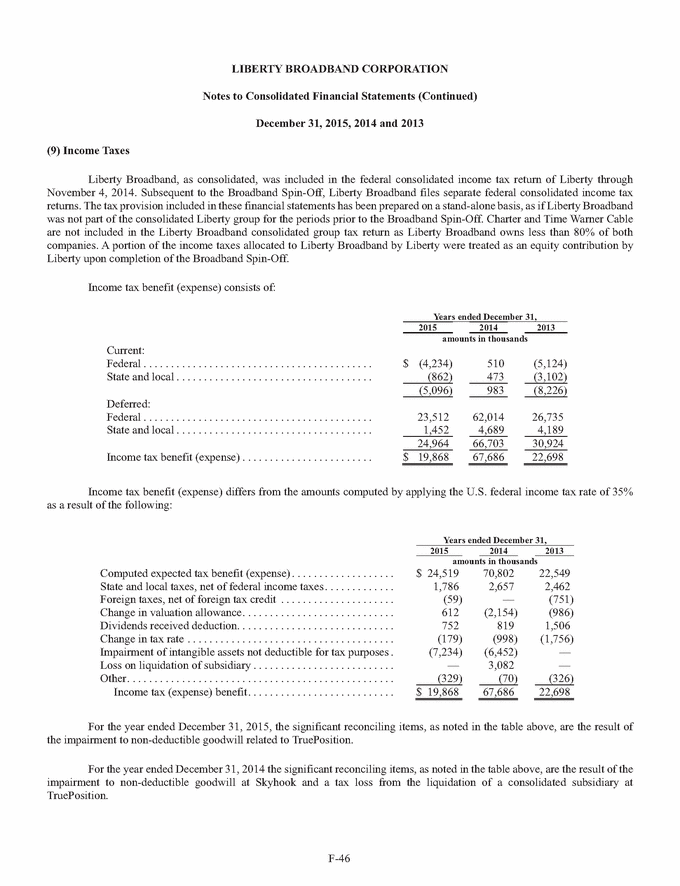
LIBERTY BROADBAND CORPORATION Notes to Consolidated Financial Statements (Continued) December 31, 2015, 2014 and 2013 During 2013, Liberty Broadband changed its estimate of the effective tax rate used to measure its net deferred tax liabilities, based on expected changes to the Company’s state apportionment factors due to the Company’s investment in Charter Communications. The rate change required an adjustment to deferred taxes at the parent level. The tax effects of temporary differences that give rise to significant portions of the deferred income tax assets and deferred income tax liabilities are presented below: December 31, 2015 2014 amounts in thousands Deferred tax assets: Net operating loss carryforwards $ 12,585 20,201 Investments 45,195 — Accrued stock-based compensation 2,896 943 Deferred revenue 1,880 16,490 Other 2,254 6,759 Total deferred tax assets 64,810 44,393 Less: valuation allowance (7,628) (8,240) Net deferred tax assets 57,182 36,153 Deferred tax liabilities: Investments — (1,252) Intangible assets (1,795) (4,039) Other (19) (40) Total deferred tax liabilities (1,814) (5,331) Net deferred tax asset (liability) $ 55,368 30,822 The Company’s valuation allowance decreased $612 thousand in 2015, which affected tax expense during the year ended December 31, 2015. At December 31, 2015, Liberty Broadband had federal and state net operating losses (on a tax effected basis) and tax credit carryforwards for income tax purposes aggregating approximately $12.6 million. These net operating losses and credit carryforwards are expected to be utilized prior to expiration, except for $7.6 million which based on current projections, may expire unused. The carryforwards that are expected to be utilized will begin to expire in 2022. As of December 31, 2015, the Company had not recorded tax reserves related to unrecognized tax benefits for uncertain tax positions. As of December 31, 2015, Liberty’s tax years prior to 2012 are closed for federal income tax purposes, and the IRS has completed its examination of Liberty’s 2012 through 2014 tax years. The tax loss carryforwards from the 2011 through 2014 tax years are still subject to adjustment. Liberty Broadband’s 2015 tax year is being examined as part of the IRS’s Compliance Assurance Process “CAP” program. As discussed earlier, because Liberty Broadband’s ownership of Charter Communications and Time Warner Cable is less than the required 80%, these companies are not consolidated with Liberty Broadband for federal income tax purposes. (10) Stockholders' Equity In the Broadband Spin-Off, record holders of Liberty Series A, Series B and Series C common stock received one-fourth of a share of the corresponding series of Liberty Broadband common stock for each share of Liberty common stock held by them
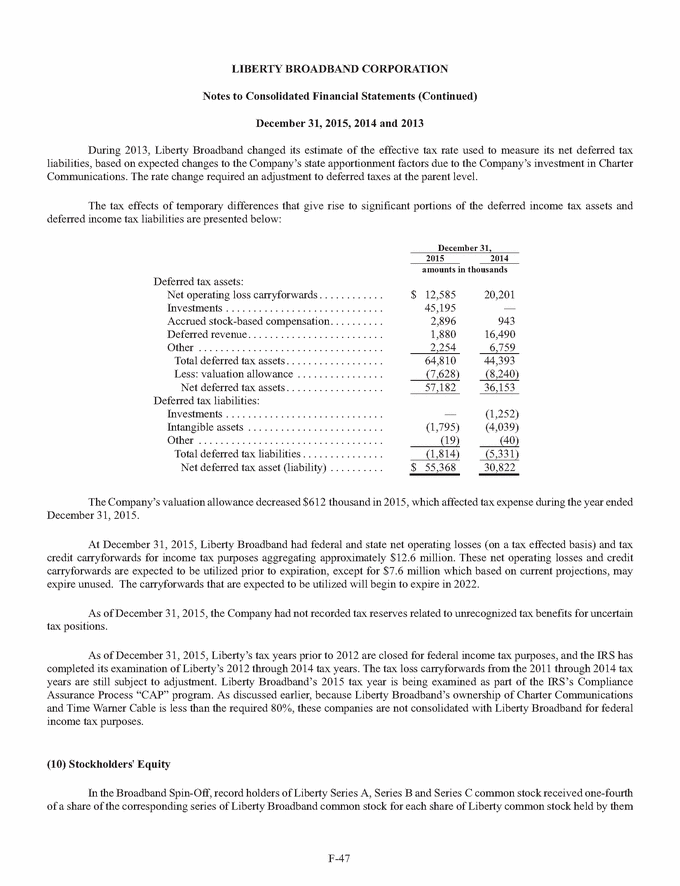
LIBERTY BROADBAND CORPORATION Notes to Consolidated Financial Statements (Continued) December 31, 2015, 2014 and 2013 as of 5:00 p.m., New York City Time, on October 29, 2014 (the record date) for the Broadband Spin-Off, with cash paid in lieu of fractional shares. This resulted in the issuance of an aggregate 85,761,332 shares of Series A, Series B and Series C common stock. In addition, following the completion of the Broadband Spin-Off, on December 10, 2014, stockholders received a subscription right to acquire one share of Series C Liberty Broadband common stock for every five shares of Liberty Broadband common stock they held as of the rights record date at a per share subscription price of $40.36, which was a 20% discount to the 20-trading day volume weighted average trading price of the Series C Liberty Broadband common stock following the completion of the Broadband Spin-Off. The rights offering was fully subscribed on January 9, 2015, with 17,277,224 shares of Series C common stock issued to those rightsholders exercising basic and, as applicable, oversubscription privileges. The subscription rights were issued to raise capital for general corporate purposes of Liberty Broadband Preferred Stock Liberty Broadband's preferred stock is issuable, from time to time, with such designations, preferences and relative participating, optional or other rights, qualifications, limitations or restrictions thereof, as shall be stated and expressed in a resolution or resolutions providing for the issue of such preferred stock adopted by Liberty Broadband's board of directors. As of December 31, 2015, no shares of preferred stock were issued. Common Stock Liberty Broadband's Series A common stock has one vote per share, Liberty Broadband's Series B common stock has ten votes per share and Liberty Broadband’s Series C common stock has no votes per share. Each share of the Series B common stock is exchangeable at the option of the holder for one share of Series A common stock. All series of our common stock participate on an equal basis with respect to dividends and distributions. As of December 31, 2015, there were 630 thousand shares of Series A and 2.8 million shares of Series C common stock reserved for issuance under exercise privileges of outstanding stock options. (11) Stock-Based Compensation Liberty Broadband - Incentive Plans In connection with the Broadband Spin-Off, the holder of an outstanding option or stock appreciation right (collectively, “Award”) to purchase shares of Liberty common stock on the record date (an original Liberty Award) received an Award to purchase shares of the corresponding series of our Liberty Broadband common stock and an adjustment to the exercise price and number of shares subject to the original Liberty Award (as so adjusted, an adjusted Liberty Award). Following the Broadband Spin-Off, employees of Liberty hold Awards in both Liberty common stock and Liberty Broadband common stock. The compensation expense relating to employees of Liberty is recorded at Liberty. Therefore, compensation expense related to options resulting from the Broadband Spin-Off will not be recognized in the Company’s consolidated financial statements. Except as described above, all other terms of an adjusted Liberty Award and a new Liberty Broadband Award (including, for example, the vesting terms thereof) are in all material respects, the same as those of the corresponding original Liberty Award. Pursuant to the Liberty Broadband 2014 Omnibus Incentive Plan (the “2014 Plan”), as amended, the Company may grant Awards to be made in respect of a maximum of 8.4 million shares of Liberty Broadband common stock. Awards generally vest over 4-5 years and have a term of 7-10 years. Liberty Broadband issues new shares upon exercise of equity awards.
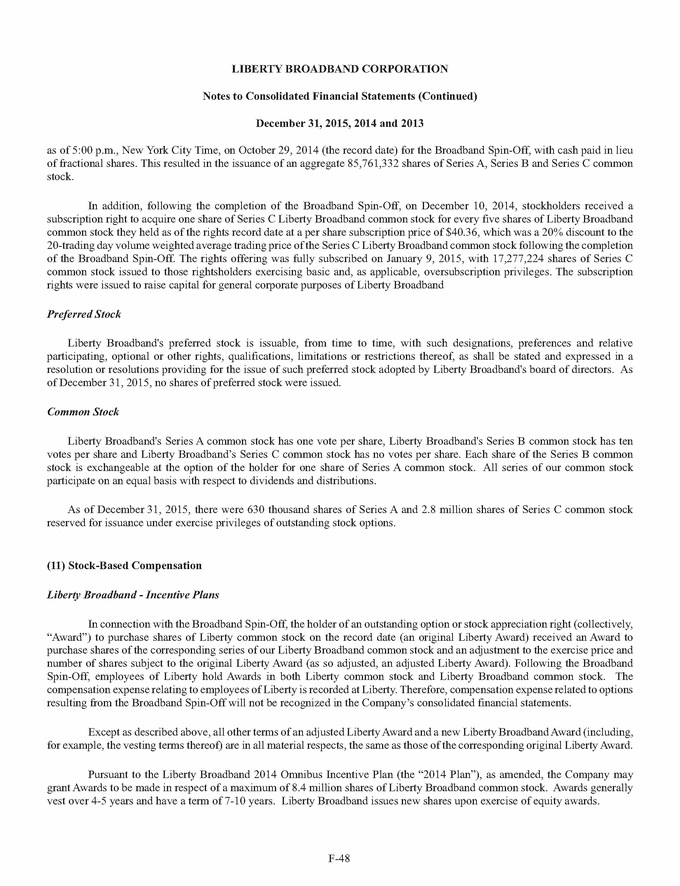
LIBERTY BROADBAND CORPORATION Notes to Consolidated Financial Statements (Continued) December 31, 2015, 2014 and 2013 Liberty Broadband – Grants of Stock Options During the year ended December 31, 2015, Liberty Broadband granted 21 thousand options to purchase shares of Series C common stock to its non-employee directors: (1) 18 thousand options with a weighted average grant-date fair value of $13.28 per share which cliff vest over a one year vesting period and (2) 3 thousand options with a weighted average grant date fair value of $15.03 per share which cliff vest over a two year vesting period. There were no options to purchase shares of Series A common stock granted during the period. The Company has calculated the grant-date fair value for all of its equity classified awards and any subsequent remeasurement of its liability classified awards using the Black-Scholes Model. The Company estimates the expected term of the Awards based on historical exercise and forfeiture data. For grants made in 2014 and 2015, the range of expected terms was 4.6 to 7.3 years. Since Liberty Broadband common stock has not traded on the stock market for a significant length of time, the volatility used in the calculation for Awards is based on the historical volatility of Charter Communications common stock and the implied volatility of publicly traded Charter Communications options; as the most significant asset within Liberty Broadband, the volatility of Charter Communications served as a proxy for the expected volatility of Liberty Broadband. For grants made in 2014 and 2015, the range of volatilities was 27.4% to 28.5%. The Company uses a zero dividend rate and the risk-free rate for Treasury Bonds with a term similar to that of the subject option. Liberty Broadband – Outstanding Awards The following table presents the number and weighted average exercise price (“WAEP”) of Awards to purchase Liberty Broadband common stock granted to certain officers, employees and directors of the Company, as well as the weighted average remaining life and aggregate intrinsic value of the Awards. Weighted average remaining Aggregate contractual intrinsic Series A WAEP life value (in thousands) (in years) (in millions) Outstanding at January 1, 2015 807 $ 32.21 Granted — $ — Exercised (176) $ 31.67 Forfeited/Cancelled (1) $ 37.11 Outstanding at December 31, 2015 630 $ 32.36 3.2 $ 12 Exercisable at December 31, 2015 606 $ 32.20 3.1 $ 12 Weighted average remaining Aggregate contractual intrinsic Series C WAEP life value (in thousands) (in years) (in millions) Outstanding at January 1, 2015 3,137 $ 39.85 Granted 21 $ 51.24 Exercised (395) $ 31.80 Forfeited/Cancelled (2) $ 37.09 Outstanding at December 31, 2015 2,761 $ 41.09 6.4 $ 30 Exercisable at December 31, 2015 1,184 $ 32.17 3.1 $ 23 The Company had no outstanding Series B options during 2015.
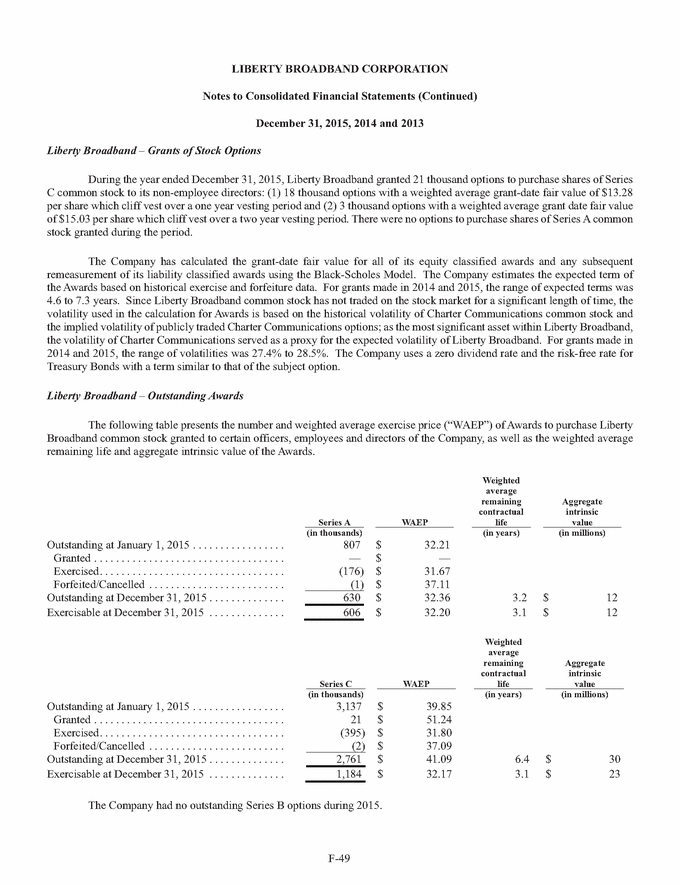
LIBERTY BROADBAND CORPORATION Notes to Consolidated Financial Statements (Continued) December 31, 2015, 2014 and 2013 As of December 31, 2015, the total unrecognized compensation cost related to unvested Liberty Broadband Awards was approximately $20.0 million. Such amount will be recognized in the Company’s consolidated statements of operations over a weighted average period of approximately 2.5 years. As of December 31, 2015, Liberty Broadband reserved 3.4 million shares of Series A and Series C common stock for issuance under exercise privileges of outstanding stock Awards. Liberty Broadband – Exercises The aggregate intrinsic value of all options exercised during the years ended December 31, 2015 and 2014 was $11.2 million and $1.8 million, respectively. Liberty Broadband – Restricted Shares The aggregate fair value of all Series A and Series C restricted shares of Liberty Broadband common stock that vested during the years ended December 31, 2015 and 2014 was $5.8 million and $172 thousand, respectively. As of December 31, 2015, the Company had approximately 38,000 unvested restricted shares of Series A and Series C Liberty Broadband common stock held by certain directors, officers and employees of the Company with a weighted average grant-date fair value of $18.57 per share. TruePosition equity incentive plans Long-Term Incentive Plans TruePosition and Skyhook have granted PARs and PSUs to employees, directors, and consultants of TruePosition and Skyhook, respectively, pursuant to the LTIPs. PAR grants under the LTIPs vest over a four or five-year period. On June 30 of each of the fiscal years following the second, fourth, sixth, and eighth anniversaries of the date of a grant, 25% of the original grant is deemed to have been exercised and canceled. Upon such date, the holders of such grants receive the appreciation in the value of the grant, if any, from the value of the grant on the date of its issuance. PSUs, unless otherwise indicated, have the same vesting, exercise, and cancellation provisions as PARs granted under the plan. Certain of the PARs and the majority of the outstanding PSU grants contain modifications to the standard vesting, exercise and cancellation provisions. Upon separation from TruePosition, holders of grants are eligible, assuming all conditions are met under the LTIPs, to receive the appreciation in value of their vested PAR grants and the value of their vested PSU grants as of the date of their separation that have not been deemed exercised and canceled.
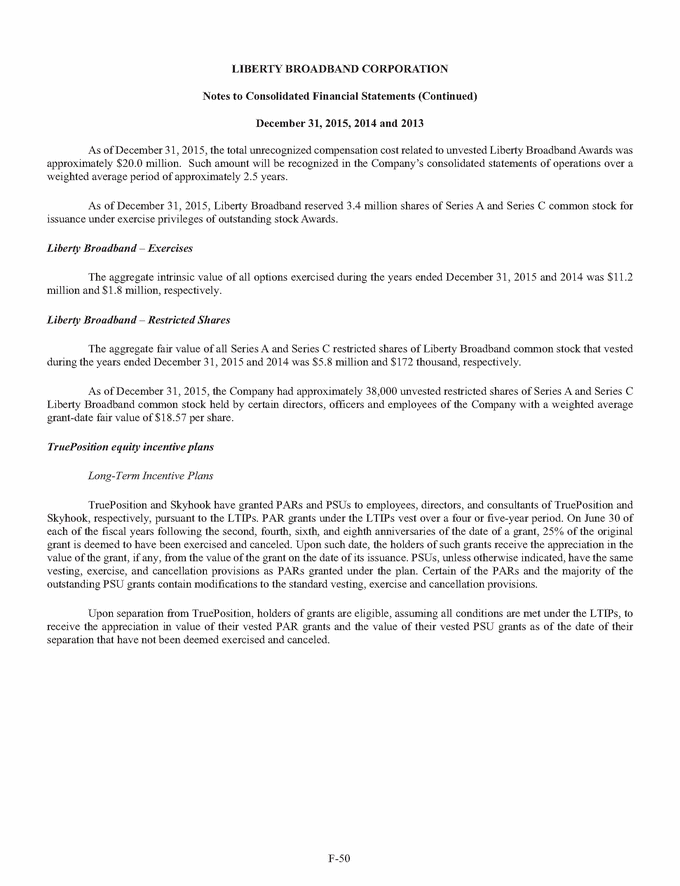
LIBERTY BROADBAND CORPORATION Notes to Consolidated Financial Statements (Continued) December 31, 2015, 2014 and 2013 The following summarizes the PAR and PSU activities under the LTIPs during 2015 (in thousands): Stand-alone Tandem Stand-alone Skyhook PARs PARs PSUs PSUs PARs Outstanding at January 1, 2015 1,076 51 15 161 3,988 Grants 120 — — 23 4,028 Exercises (297) (51) (15) (24) (150) Forfeitures (5) — — — (805) Outstanding at December 31, 2015 894 — — 160 7,061 Fair value of outstanding grants — — — $ 2,028 $ 1,660 Vested fair value — — — $ 1,150 $ 592 Weighted average remaining vesting period 2.3 years 2.1 years 2.5 years Grants that are exercised and paid and grants that are forfeited, canceled, or otherwise not paid are available for grant under the LTIPs. Grants under the LTIPs may be settled in cash, publicly traded stock of the companies or an affiliate of the companies, or a combination thereof. TruePosition accounts for grants under the LTIPs as liability instruments. Accordingly, TruePosition measures the cost of employee services received in exchange for grants based on the current fair value of the grants and records a liability at the end of each reporting period equivalent to the vested portion of such current fair value. TruePosition calculates the grant-date fair value and subsequent remeasurement of its liability classified awards using the Black-Scholes model. TruePosition estimates the expected term of the awards based on historical exercise and forfeiture data. The expected term for grants made to during 2015 ranged from 0.5 - 7.5 years. The volatility used by TruePosition in the Black- Scholes model for grants made during 2015 was 40%. TruePosition uses a zero dividend rate and the risk-free rate for Treasury Bonds with a term similar to that of the subject options, which ranged from 0.5% - 2.1% for grants made in 2015. As of December 31, 2015 and 2014, $2.0 million and $2.1 million, respectively, are included in other liabilities for the fair value (Level 2) of the Company's LTIP obligations. Stock Option Plan In October 1995, TruePosition adopted the SIP, which provides for the granting of stock options to employees, directors, and consultants of TruePosition. Options granted under the SIP may be either Incentive Stock Options (ISOs) or Nonqualified Stock Options (NSOs). ISOs may be granted only to TruePosition employees (including officers and directors who are also employees). NSOs may be granted to employees, directors, and consultants. Options under the SIP may be granted for periods of up to ten years and generally vest over four or five years. As of December 31, 2015 and 2014, there were no options outstanding. (12) Employee Benefit Plans Prior to January 1, 2015, TruePosition participated in Liberty’s defined-contribution plan (the “Liberty 401(k) Plan”). The Liberty 401(k) Plan provided for employees to make contributions by salary reductions to a trust for investment in Liberty common stock, as well as several mutual funds and/or a self-directed brokerage account pursuant to Section 401(k) of the Internal Revenue Code. Beginning January 1, 2015, employees of TruePosition and Skyhook participate in a separate defined-contribution plan administered by TruePosition (the “TruePosition 401(k) Plan”). The TruePosition 401(k) Plan provides for employees to make
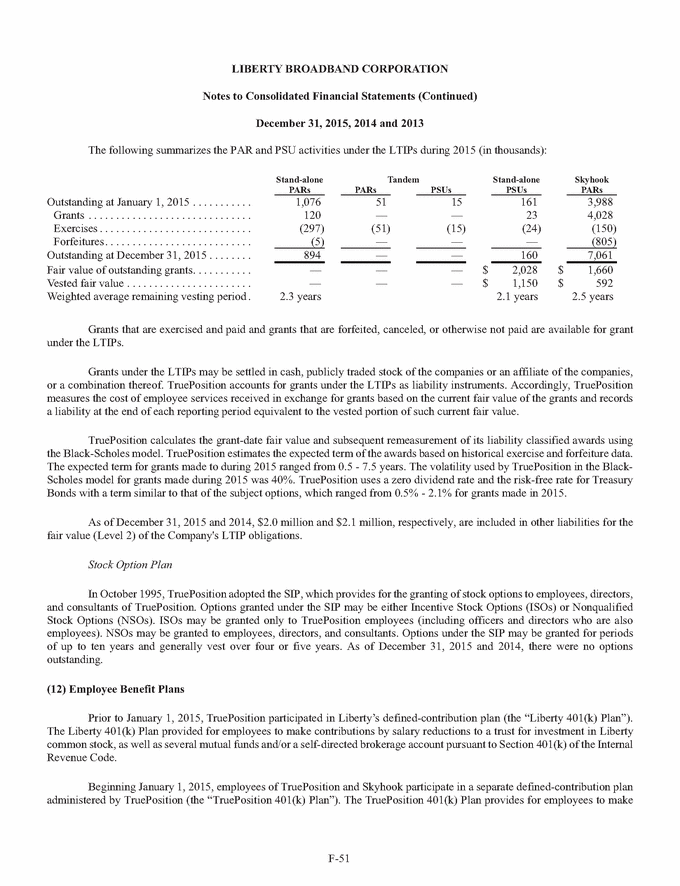
LIBERTY BROADBAND CORPORATION Notes to Consolidated Financial Statements (Continued) December 31, 2015, 2014 and 2013 contributions by salary reductions for investment in several mutual funds and/or a self-directed brokerage account pursuant to Section 401(k) of the Internal Revenue Code. TruePosition and Skyhook employees are eligible for 100% and 50% matching contributions by the Company for each dollar contributed up to 10% and 8% of the employees’ total compensation, respectively, subject to certain limitations. For the years ended December 31, 2015, 2014 and 2013, TruePosition contributed approximately $1.1 million, $1.5 million and $1.6 million respectively. (13) Related Party Transactions During the year ended December 31, 2014 certain of TruePosition’s costs and expenses were charged to TruePosition by Liberty. The amounts due to (from) Liberty and the activities for the year ended December 31, 2014 are summarized as follows (amounts in thousands): 2014 Payable (receivable) at beginning of year $ (5,953) Costs and expenses charged by Liberty 3,913 Amounts (receivable) due under the tax-sharing arrangement (4,094) Transfer of related party receivable to (from) note receivable 5,306 Payments to Liberty (6,399) Amount receivable (due) under the tax-sharing arrangement transferred to Liberty Broadband 7,227 (Receivable) payable at end of year $ — Prior to the completion of the Broadband Spin-Off, TruePosition was a party to certain tax sharing arrangements with Liberty (or its former affiliate). Under these tax-sharing arrangements, TruePosition had been obligated to make cash payments to Liberty (or its former affiliate) in each year TruePosition generated positive taxable income, determined as if TruePosition filed a separate tax return. The amount of such payment has been equal to the amount of TruePosition’s taxable income (as so determined) multiplied by the highest corporate tax rate in effect for the applicable tax jurisdiction. If on a separate return basis, TruePosition would have a net operating loss or net tax credit for a particular year, and such loss or credit could be utilized on the actual tax returns filed by Liberty (or its former affiliate), then TruePosition would be entitled to reduce current and future payments to Liberty (or its former affiliate) by the amount of such tax benefit. TruePosition made payments of $3.2 million in 2014 and $13.6 million in 2013 under these tax sharing arrangements. Prior to the completion of the Broadband Spin-Off, TruePosition’s income tax receivable from Liberty was transferred to Liberty Broadband and the tax sharing arrangement between Liberty and TruePosition was extinguished.
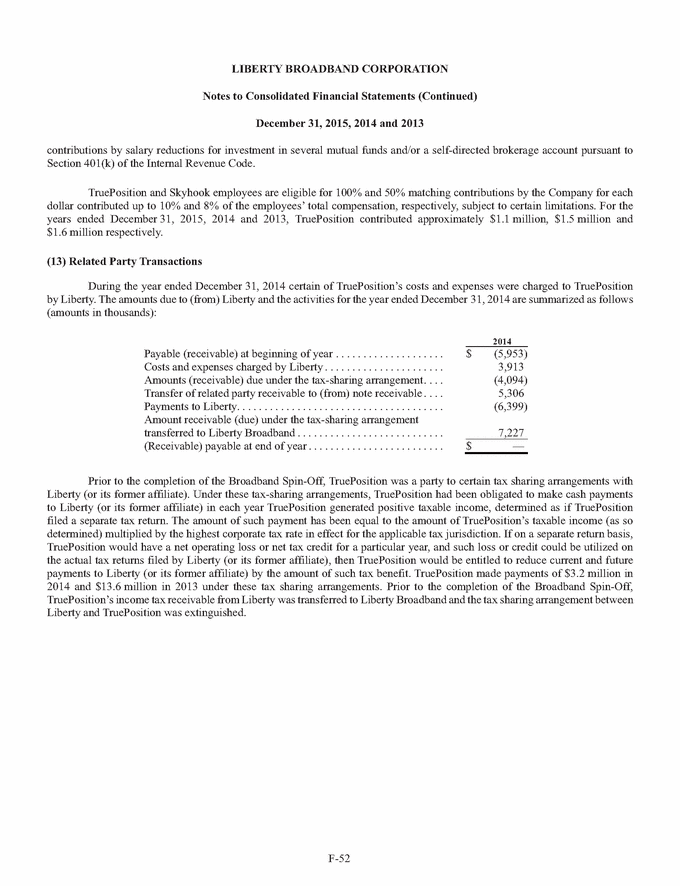
LIBERTY BROADBAND CORPORATION Notes to Consolidated Financial Statements (Continued) December 31, 2015, 2014 and 2013 (14) Commitments and Contingencies Leases TruePosition leases various properties under operating leases expiring at various times through 2018. The aggregate minimum annual lease payments under the noncancelable operating leases as of December 31, 2015 are as follows (amounts in thousands): 2016 $ 1,161 2017 1,136 2018 27 $ 2,324 TruePosition’s principal facility is under lease through December 2017 and Skyhook’s lease for its corporate headquarters expires in January 2018. Total rental expense for the years ended December 31, 2015, 2014 and 2013 was $3.7 million, $3.3 million and $3.1 million, respectively. Litigation On May 23, 2012, TruePosition filed a patent infringement lawsuit in the U.S. District Court for the District of Delaware against Polaris Wireless, Inc. (“Polaris”), related to the sale by Polaris of systems used to locate mobile devices. In parallel with the lawsuit, at Polaris’s request, the U.S. Patent and Trademark Office initiated an Inter Partes Review. Both the District Court and the Patent Trial and Appeal Board ruled adversely to TruePosition and those rulings were appealed by TruePosition. On December 15, 2015, the United States Court of Appeals for the Federal Court confirmed the decision of the Patent Trial and Appeals Board and dismissed the appeal of the District Court’s ruling as moot. No further appeal will be taken by TruePosition. During the pendency of the appeal, Polaris filed a motion in the District Court for an award of approximately $3 million in attorneys’ fees and expenses incurred in defending the lawsuit. The matter was heard by the Court on October 16, 2015, wherein the court denied the Polaris motion. On September 10, 2010, Skyhook filed a patent infringement lawsuit in the U.S. District Court for the District of Massachusetts against Google, Inc. (“Google”). In March 2013, Skyhook amended its lawsuit to add additional claims. In total, at the time the case was to be tried, Skyhook alleged that Google infringed on eight Skyhook patents involving location technology and sought an injunction and/or award of damages in an amount to be determined at trial. The case had been scheduled to be tried before a jury commencing March 9, 2015. However, on March 5, 2015, the parties advised the District Court that the case has been settled and thereby dismissed the action without costs and without prejudice to the right person, upon good cause shown within 45 days, to reopen the action if settlement is not consummated. On March 27, 2015, the parties consummated a final settlement agreement and on April 24, 2015, Google paid Skyhook settlement consideration of $90 million. In return for payment of the settlement consideration, Google received dismissal of the action with prejudice, a license to the existing Skyhook patents and patent applications (and their continuations, divisionals, continuations-in-part), a three-year covenant not to sue (subject to limited exceptions) and a mutual release of claims. The settlement amount of $90 million is recorded net of approximately $29.5 million for legal fees in the statement of operations for the year ended December 31, 2015. General Litigation In the ordinary course of business, the Company and its consolidated subsidiaries are parties to legal proceedings and claims involving alleged infringement of third-party intellectual property rights, defamation, and other claims. Although it is reasonably possible that the Company may incur losses upon conclusion of such matters, an estimate of any loss or range of loss cannot be made. In the opinion of management, it is expected that amounts, if any, which may be required to satisfy such contingencies will not be material in relation to the accompanying consolidated financial statements.
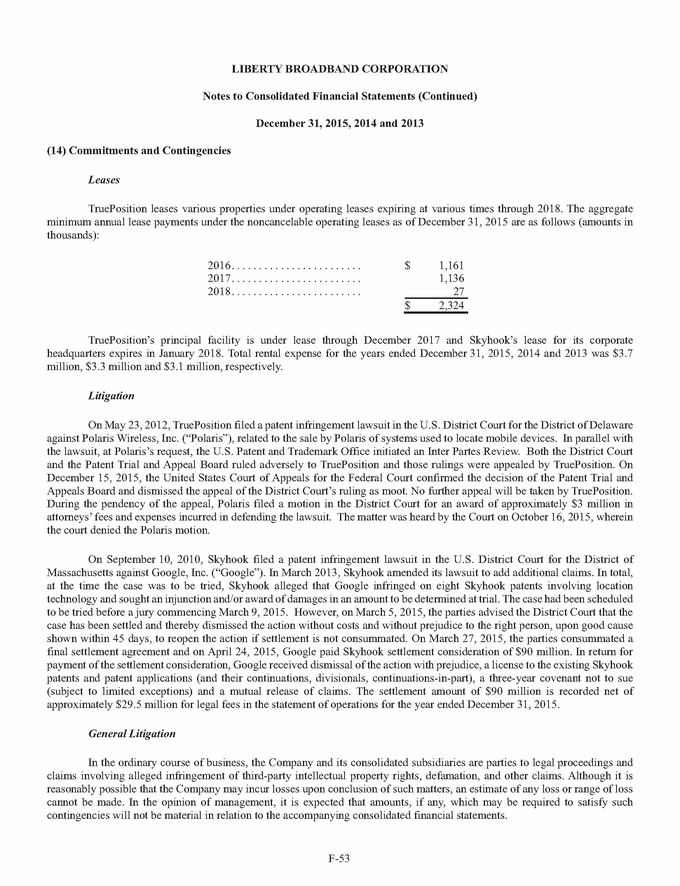
LIBERTY BROADBAND CORPORATION Notes to Consolidated Financial Statements (Continued) December 31, 2015, 2014 and 2013 Indemnification Claims In the normal course of business, TruePosition provides indemnification to certain customers against specified claims that might arise against those customers from the use of TruePosition’s products. To date, TruePosition has not made any significant reimbursements to any of its customers for any losses related to these indemnification provisions. However, five such claims are currently pending and are described below. TruePosition is unable to estimate the maximum potential impact of these indemnification provisions on its future results of operations, although TruePosition’s liabilities in certain of those arrangements are customarily limited in various respects, including monetarily. Accordingly, no accrual was recorded related to indemnification claims as of December 31, 2015 or 2014. TruePosition’s former customer, T-Mobile, has made two indemnification claims against TruePosition. In September, 2008, T-Mobile requested that TruePosition indemnify it for damages (including defense costs) that it may incur in a patent infringement action that Emsat Advanced Geolocation, LLC (“Emsat”) filed against T-Mobile. TruePosition is not a party to the suit. TruePosition has denied that it is obligated to indemnify T-Mobile and believes that the equipment that it has supplied to TMobile is not covered by the patent claims that Emsat is asserting against T-Mobile. T-Mobile has not yet formally pursued its indemnification claims in a civil court action, but has indicated its intention to do so after the infringement action is resolved. In March 2014, T-Mobile requested that TruePosition indemnify it for damages (including defense costs) that it may incur in a patent infringement action that Guidance IP LLC (“Guidance”) filed against T-Mobile. TruePosition is not a party to the suit. TruePosition has indicated a willingness to participate in the defense of the action, but has not yet received a response from TMobile. TruePosition’s customer, AT&T, has made four indemnification claims against TruePosition. In October 2008, AT&T requested TruePosition to indemnify it for damages (including defense costs) that it may incur relating to the Emsat litigation described in the preceding paragraph (to which AT&T is a party). In June 2009, AT&T requested TruePosition to indemnify it for damages (including defense costs) that it may incur relating to a lawsuit filed against AT&T by Tendler Cellular of Texas, LLC (“Tendler”) (to which the Company is not a party). This action relates to TruePosition’s subsidiary, Useful Networks, Inc., whose operations were discontinued in 2010. In June 2011, AT&T requested TruePosition to indemnify it for damages (including defense costs) that it may incur relating to a lawsuit filed against AT&T by Tracbeam, LLC (to which Company is not a party). TruePosition has denied that it is obligated to indemnify AT&T with respect to the Emsat and Tendler cases. AT&T has not yet formally pursued its indemnification claims in a civil court action and it is unclear at this time whether or not it will do so. The lawsuit filed against AT&T by Guidance IP LLC, was resolved by the payment to AT&T of $55 thousand during October 2015. With respect to Tracbeam, AT&T has determined that TruePosition’s total allocated contribution is $132 thousand and has invoiced TruePosition accordingly. TruePosition has informed AT&T that TruePosition believes that the allocation method employed by AT&T is flawed and that the actual amount owed is less than $132 thousand. TruePosition is unable to estimate the maximum potential impact of these indemnification provisions on its future results of operations, although TruePosition’s liabilities in certain of those arrangements are customarily limited in various respects, including monetarily. Off-Balance Sheet Arrangements Liberty Broadband did not have any off-balance sheet arrangements that have, or are reasonably likely to have, a current or future effect on the Company’s financial condition, results of operations, liquidity, capital expenditures or capital resources. (15) Segment Information Liberty Broadband identifies its reportable segments as (A) those consolidated companies that represent 10% or more of its consolidated annual revenue, annual Adjusted OIBDA or total assets and (B) those equity method affiliates whose share of earnings or losses represent 10% or more of Liberty Broadband’s annual pre-tax earnings (losses).
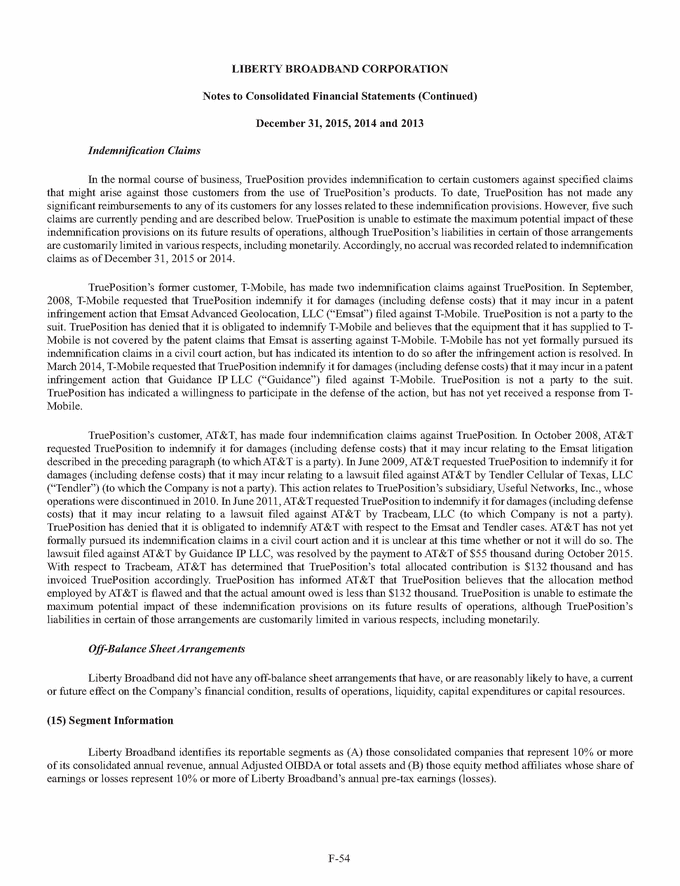
LIBERTY BROADBAND CORPORATION Notes to Consolidated Financial Statements (Continued) December 31, 2015, 2014 and 2013 Liberty Broadband evaluates performance and makes decisions about allocating resources to its operating segments based on financial measures such as revenue, Adjusted OIBDA. In addition, Liberty Broadband reviews nonfinancial measures such as subscriber growth. Liberty Broadband defines Adjusted OIBDA as revenue less cost of sales, operating expenses, and selling, general and administrative expenses (excluding stock-based compensation). Liberty Broadband believes this measure is an important indicator of the operational strength and performance of its businesses, including each business’s ability to service debt and fund capital expenditures. In addition, this measure allows management to view operating results and perform analytical comparisons and benchmarking between businesses and identify strategies to improve performance. This measure of performance excludes depreciation and amortization, stock based compensation, separately reported litigation settlements and restructuring and impairment charges that are included in the measurement of operating income pursuant to GAAP. Accordingly, Adjusted OIBDA should be considered in addition to, but not as a substitute for, operating income, net earnings, cash flow provided by operating activities and other measures of financial performance prepared in accordance with GAAP. Liberty Broadband generally accounts for intersegment sales and transfers as if the sales or transfers were to third parties, that is, at current prices. For the year ended December 31, 2015, Liberty Broadband has identified the following consolidated company and equity method investment as its reportable segments: TruePosition—a wholly-owned subsidiary of the Company that develops and markets technology for locating wireless phones and other wireless devices on a cellular network, enabling wireless carriers and government agencies to provide public safety E-9-1-1 services domestically and services in support of national security and law enforcement worldwide. In addition, TruePosition acquired Skyhook in 2014, which operates a global location network providing hybrid wireless positioning technology and contextual location intelligence solutions worldwide. Charter—an equity method investment that is one of the largest providers of cable services in the United States, offering a variety of entertainment, information and communications solutions to residential and commercial customers. Liberty Broadband’s operating segments are strategic business units that offer different products and services. They are managed separately because each segment requires different technologies, distribution channels and marketing strategies. The accounting policies of the segments that are also consolidated companies are the same as those described in the Company’s summary of significant accounting policies in the Company’s annual financial statements. For periods in which Liberty Broadband owned Charter shares and warrants, we have included amounts attributable to Charter in the tables below. Although Liberty Broadband owns less than 100% of the outstanding shares of Charter, 100% of the Charter amounts are included in the schedule below and subsequently eliminated in order to reconcile the account totals to the Liberty Broadband consolidated financial statements.
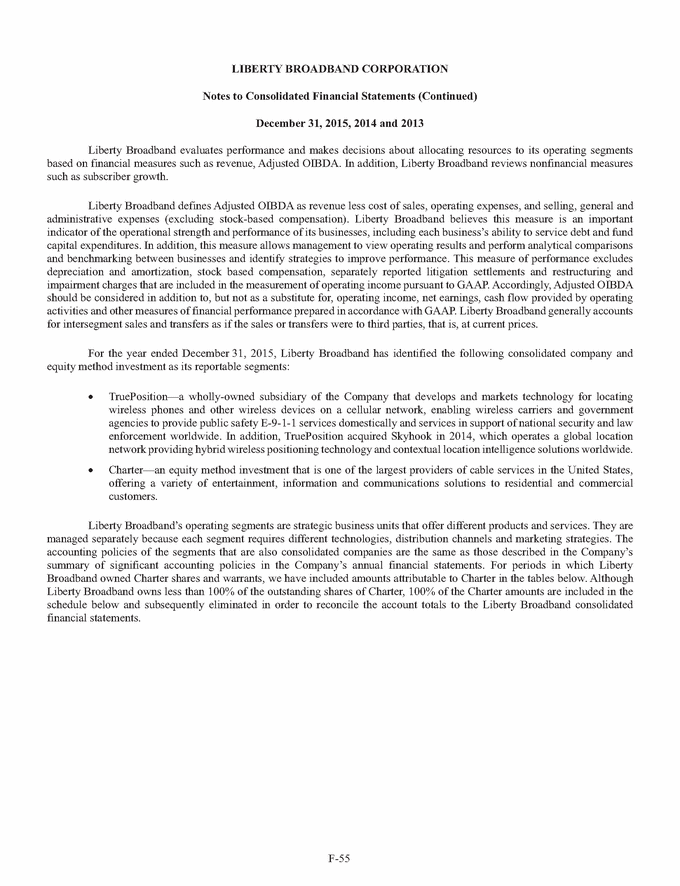
LIBERTY BROADBAND CORPORATION Notes to Consolidated Financial Statements (Continued) December 31, 2015, 2014 and 2013 Performance Measures Years ended December 31, 2015 2014 2013 Adjusted Adjusted Adjusted Revenue OIBDA Revenue OIBDA Revenue OIBDA amounts in thousands TruePosition $ 91,182 43,600 69,045 (2,152) 77,363 5,290 Charter (a) 9,754,000 3,317,000 9,108,000 3,128,000 8,155,000 2,811,000 Corporate and other — (11,958) — (1,559) — — 9,845,182 3,348,642 9,177,045 3,124,289 8,232,363 2,816,290 Eliminate equity method affiliate (9,754,000) (3,317,000) (9,108,000) (3,128,000) (8,155,000) (2,811,000) Consolidated Liberty Broadband $ 91,182 31,642 69,045 (3,711) 77,363 5,290 (a) The amounts herein represent Charter’s results for the full years ended December 31, 2015, 2014 and 2013. However, the portion of Charter’s share of earnings (losses) included in the consolidated financial statements of Liberty Broadband only includes Charter’s results from the time of acquisition (May 2013) through December 31, 2015. Other Information December 31, 2015 December 31, 2014 Total Investments Capital Total Investments Capital assets in affiliates expenditures assets in affiliates expenditures amounts in thousands TruePosition $ 61,395 — 731 96,989 — 1,398 Charter 39,316,000 — 1,840,000 24,388,000 — 2,221,000 Corporate and other 3,504,346 2,372,699 — 2,906,482 2,498,804 — 42,881,741 2,372,699 1,840,731 27,391,471 2,498,804 2,222,398 Eliminate equity method affiliate (39,316,000) — (1,840,000) (24,388,000) — (2,221,000) Consolidated Liberty Broadband $ 3,565,741 2,372,699 731 3,003,471 2,498,804 1,398 Revenue by Geographic Area Years ended December 31, 2015 2014 2013 amounts in thousands United States $ 87,739 66,045 68,179 Other countries 3,443 3,000 9,184 $ 91,182 69,045 77,363
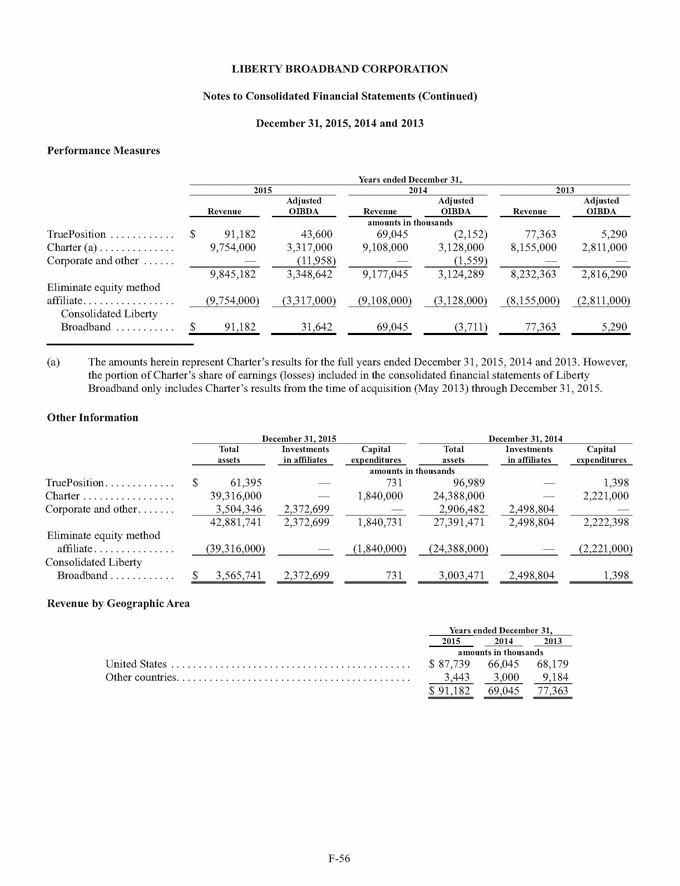
LIBERTY BROADBAND CORPORATION Notes to Consolidated Financial Statements (Continued) December 31, 2015, 2014 and 2013 Long-lived Assets by Geographic Area December 31, 2015 2014 amounts in thousands United States $ 1,248 3,570 Other countries — 20 $ 1,248 3,590 The following table provides a reconciliation of segment Adjusted OIBDA to earnings (loss) from continuing operations before income taxes: Years ended December 31, 2015 2014 2013 amounts in thousands Consolidated segment Adjusted OIBDA $ 31,642 (3,711) 5,290 Stock-based compensation (6,380) (999) (996) Depreciation and amortization (6,088) (9,043) (4,382) Gain on legal settlement 60,450 6,000 — Impairment of intangible assets (20,669) (35,221) — Interest expense (7,424) (1,138) — Dividend and interest income 3,797 5,426 6,878 Share of earnings (loss) of affiliates, net (120,962) (127,573) (76,090) Realized and unrealized gains (losses) on financial instruments, net 2,619 51,189 97,860 Gain (loss) on dilution of investment in affiliate (7,198) (87,158) (92,933) Other, net 158 (63) (53) Earnings (loss) from continuing operations before income taxes $ (70,055) (202,291) (64,426) (16) Quarterly Financial Information (Unaudited) 1st 2nd 3rd 4th Quarter Quarter Quarter Quarter amounts in thousands 2015: Revenue $ 13,316 12,645 15,225 49,996 Operating income (loss) $ 50,471 (3,414) 288 11,610 Net earnings (loss) attributable to Liberty Broadband Corporation Series A, Series B and Series C stockholders $ 5,318 (7,809) (19,295) (28,401) Basic earnings (loss) attributable to Liberty Broadband Corporation Series A, Series B and Series C stockholders per common share $ 0.05 (0.08) (0.19) (0.28) Diluted earnings (loss) attributable to Liberty Broadband Corporation Series A, Series B and Series C stockholders per common share $ 0.05 (0.08) (0.19) (0.28)
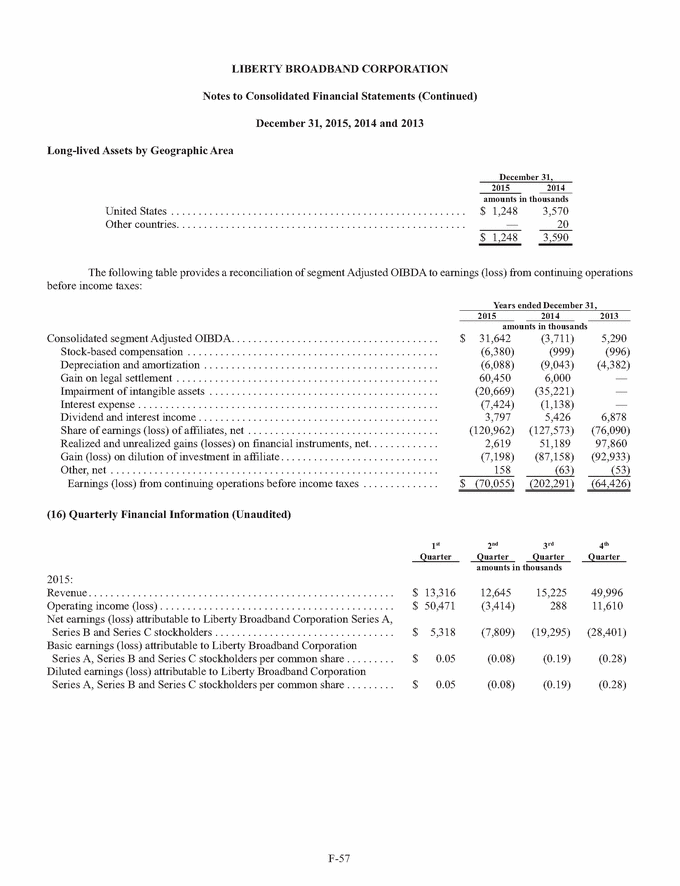
LIBERTY BROADBAND CORPORATION Notes to Consolidated Financial Statements December 31, 2015, 2014 and 2013 1st 2nd 3rd 4th Quarter Quarter Quarter Quarter amounts in thousands 2014: Revenue $ 16,921 17,146 17,445 17,533 Operating income (loss) $ (4,536) (8,398) 6,364 (36,404) Net earnings (loss) attributable to Liberty Broadband Corporation Series A, Series B and Series C stockholders $ (57,715) 1,904 (31,990) (46,804) Basic earnings (loss) attributable to Liberty Broadband Corporation Series A, Series B and Series C stockholders per common share $ (0.65) 0.02 (0.36) (0.53) Diluted earnings (loss) attributable to Liberty Broadband Corporation Series A, Series B and Series C stockholders per common share $ (0.65) 0.02 (0.36) (0.53)
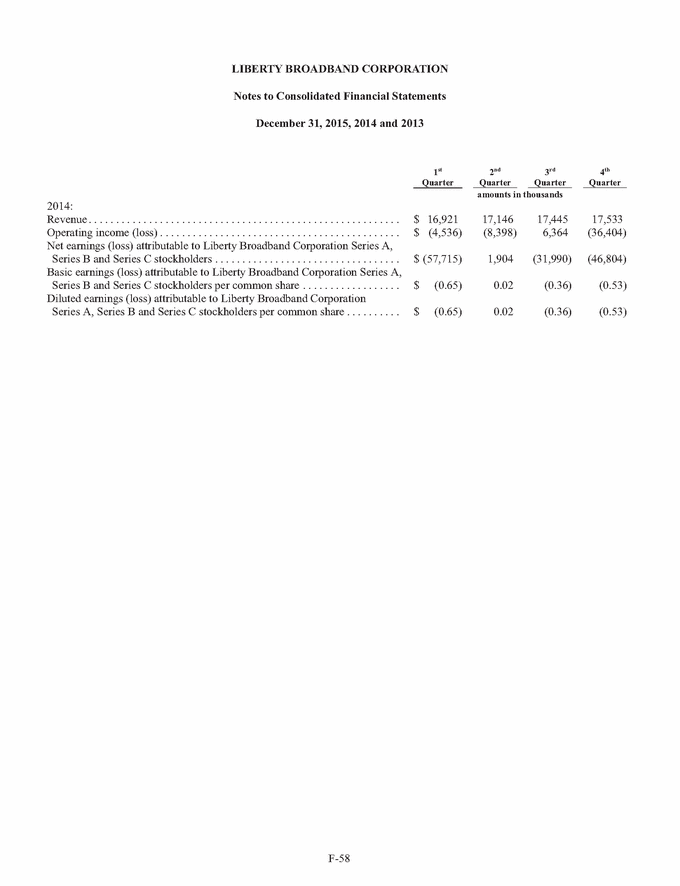
This page has been intentionally left blank.

This page has been intentionally left blank.

BOARD OF DIRECTORS John C. Malone Chairman of the Board Liberty Broadband Corporation Richard R. Green Retired President and Chief Executive Officer CableLabs® Gregory B. Maffei President and Chief Executive Officer Liberty Broadband Corporation J. David Wargo Founder and President Wargo & Company, Inc. John E. Welsh III President Avalon Capital Partners LLC EXECUTIVE COMMITTEE Gregory B. Maffei John C. Malone COMPENSATION COMMITTEE J. David Wargo (Chairman) Richard R. Green John E. Welsh III AUDIT COMMITTEE John E. Welsh III (Chairman) Richard R. Green J. David Wargo NOMINATING & CORPORATE GOVERNANCE COMMITTEE Richard R. Green (Chairman) J. David Wargo John E. Welsh III SENIOR OFFICERS Gregory B. Maffei President and Chief Executive Officer Richard N. Baer Chief Legal Officer Mark D. Carleton Chief Development Officer Albert E. Rosenthaler Chief Tax Officer Christopher W. Shean Chief Financial Officer CORPORATE SECRETARY Pamela L. Coe CORPORATE HEADQUARTERS 12300 Liberty Boulevard Englewood, CO 80112 (720) 875-5700 STOCK INFORMATION Series A Common Stock (LBRDA) and Series C Common Stock (LBRDK) trade on the NASDAQ Global Select Market. Series B Common Stock (LBRDB) is quoted on The OTC Markets. CUSIP NUMBERS LBRDA – 530307 107 LBRDB – 530307 206 LBRDK – 530307 305 TRANSFER AGENT Liberty Broadband Corporation Shareholder Services c/o Computershare P.O. Box 43023 Providence, RI 02940-3023 Phone: (781) 575-4593 Toll free: (866) 367-6355 www.computershare.com Telecommunication Device for the Deaf (TDD) (800) 952-9245 INVESTOR RELATIONS Courtnee Chun investor@libertybroadband.com (844) 826-8735 ON THE INTERNET Visit the Liberty Broadband Corporation website at www.libertybroadband.com. FINANCIAL STATEMENTS Liberty Broadband Corporation financial statements are filed with the Securities and Exchange Commission. Copies of these financial statements can be obtained from the Transfer Agent or through the Liberty Broadband Corporation website.
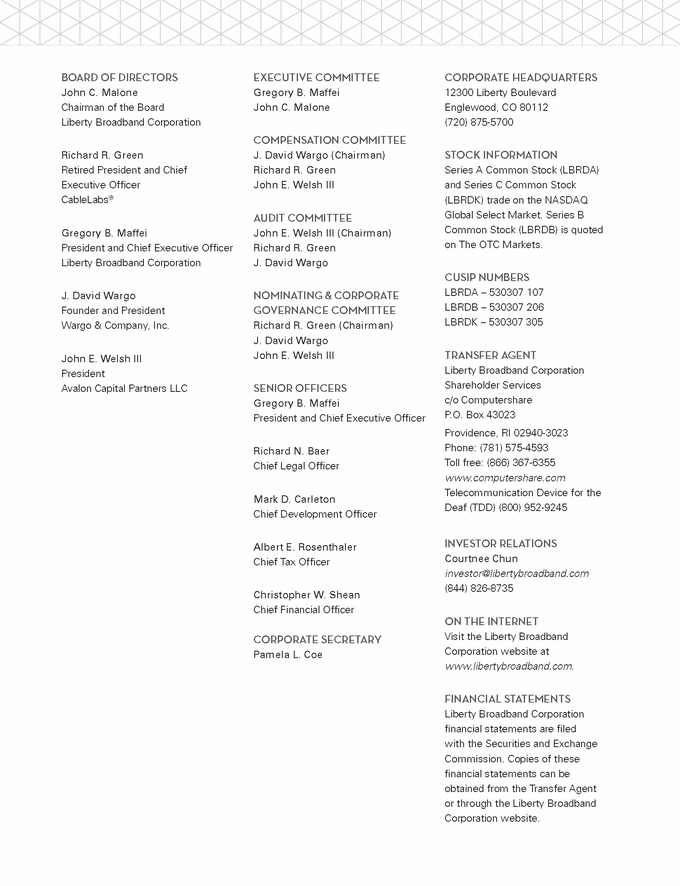
12300 LIBERTY BOULEVARD | ENGLEWOOD, CO 80112 WWW.LIBERTYBROADBAND.COM | 720.875.5700
